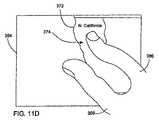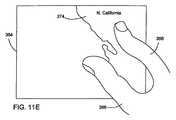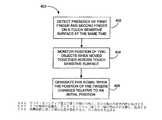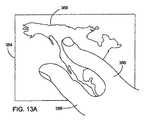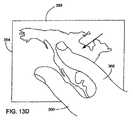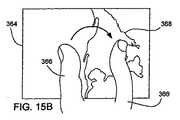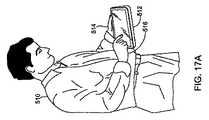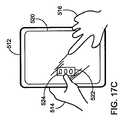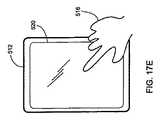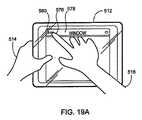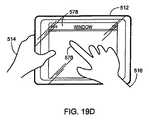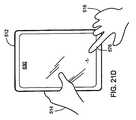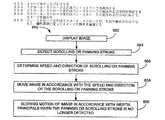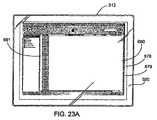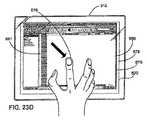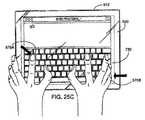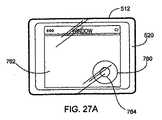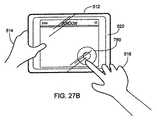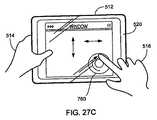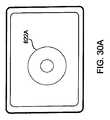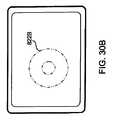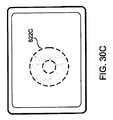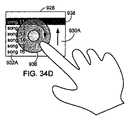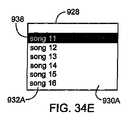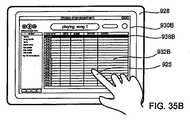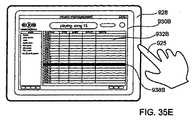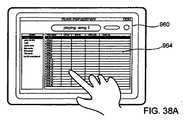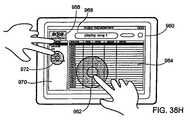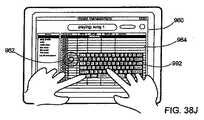JP2008508600A - Mode-based graphical user interface for touch-sensitive input devices - Google Patents
Mode-based graphical user interface for touch-sensitive input devicesDownload PDFInfo
- Publication number
- JP2008508600A JP2008508600AJP2007523644AJP2007523644AJP2008508600AJP 2008508600 AJP2008508600 AJP 2008508600AJP 2007523644 AJP2007523644 AJP 2007523644AJP 2007523644 AJP2007523644 AJP 2007523644AJP 2008508600 AJP2008508600 AJP 2008508600A
- Authority
- JP
- Japan
- Prior art keywords
- touch
- user interface
- scroll wheel
- gui element
- finger
- Prior art date
- Legal status (The legal status is an assumption and is not a legal conclusion. Google has not performed a legal analysis and makes no representation as to the accuracy of the status listed.)
- Granted
Links
Images
Classifications
- G—PHYSICS
- G06—COMPUTING OR CALCULATING; COUNTING
- G06F—ELECTRIC DIGITAL DATA PROCESSING
- G06F3/00—Input arrangements for transferring data to be processed into a form capable of being handled by the computer; Output arrangements for transferring data from processing unit to output unit, e.g. interface arrangements
- G06F3/01—Input arrangements or combined input and output arrangements for interaction between user and computer
- G06F3/048—Interaction techniques based on graphical user interfaces [GUI]
- G06F3/0487—Interaction techniques based on graphical user interfaces [GUI] using specific features provided by the input device, e.g. functions controlled by the rotation of a mouse with dual sensing arrangements, or of the nature of the input device, e.g. tap gestures based on pressure sensed by a digitiser
- G06F3/0488—Interaction techniques based on graphical user interfaces [GUI] using specific features provided by the input device, e.g. functions controlled by the rotation of a mouse with dual sensing arrangements, or of the nature of the input device, e.g. tap gestures based on pressure sensed by a digitiser using a touch-screen or digitiser, e.g. input of commands through traced gestures
- G—PHYSICS
- G06—COMPUTING OR CALCULATING; COUNTING
- G06F—ELECTRIC DIGITAL DATA PROCESSING
- G06F3/00—Input arrangements for transferring data to be processed into a form capable of being handled by the computer; Output arrangements for transferring data from processing unit to output unit, e.g. interface arrangements
- G06F3/01—Input arrangements or combined input and output arrangements for interaction between user and computer
- G06F3/048—Interaction techniques based on graphical user interfaces [GUI]
- G—PHYSICS
- G06—COMPUTING OR CALCULATING; COUNTING
- G06F—ELECTRIC DIGITAL DATA PROCESSING
- G06F3/00—Input arrangements for transferring data to be processed into a form capable of being handled by the computer; Output arrangements for transferring data from processing unit to output unit, e.g. interface arrangements
- G06F3/01—Input arrangements or combined input and output arrangements for interaction between user and computer
- G06F3/03—Arrangements for converting the position or the displacement of a member into a coded form
- G06F3/041—Digitisers, e.g. for touch screens or touch pads, characterised by the transducing means
- G—PHYSICS
- G06—COMPUTING OR CALCULATING; COUNTING
- G06F—ELECTRIC DIGITAL DATA PROCESSING
- G06F3/00—Input arrangements for transferring data to be processed into a form capable of being handled by the computer; Output arrangements for transferring data from processing unit to output unit, e.g. interface arrangements
- G06F3/01—Input arrangements or combined input and output arrangements for interaction between user and computer
- G06F3/048—Interaction techniques based on graphical user interfaces [GUI]
- G06F3/0481—Interaction techniques based on graphical user interfaces [GUI] based on specific properties of the displayed interaction object or a metaphor-based environment, e.g. interaction with desktop elements like windows or icons, or assisted by a cursor's changing behaviour or appearance
- G06F3/04812—Interaction techniques based on cursor appearance or behaviour, e.g. being affected by the presence of displayed objects
- G—PHYSICS
- G06—COMPUTING OR CALCULATING; COUNTING
- G06F—ELECTRIC DIGITAL DATA PROCESSING
- G06F3/00—Input arrangements for transferring data to be processed into a form capable of being handled by the computer; Output arrangements for transferring data from processing unit to output unit, e.g. interface arrangements
- G06F3/01—Input arrangements or combined input and output arrangements for interaction between user and computer
- G06F3/048—Interaction techniques based on graphical user interfaces [GUI]
- G06F3/0487—Interaction techniques based on graphical user interfaces [GUI] using specific features provided by the input device, e.g. functions controlled by the rotation of a mouse with dual sensing arrangements, or of the nature of the input device, e.g. tap gestures based on pressure sensed by a digitiser
- G06F3/0488—Interaction techniques based on graphical user interfaces [GUI] using specific features provided by the input device, e.g. functions controlled by the rotation of a mouse with dual sensing arrangements, or of the nature of the input device, e.g. tap gestures based on pressure sensed by a digitiser using a touch-screen or digitiser, e.g. input of commands through traced gestures
- G06F3/04883—Interaction techniques based on graphical user interfaces [GUI] using specific features provided by the input device, e.g. functions controlled by the rotation of a mouse with dual sensing arrangements, or of the nature of the input device, e.g. tap gestures based on pressure sensed by a digitiser using a touch-screen or digitiser, e.g. input of commands through traced gestures for inputting data by handwriting, e.g. gesture or text
- G—PHYSICS
- G06—COMPUTING OR CALCULATING; COUNTING
- G06F—ELECTRIC DIGITAL DATA PROCESSING
- G06F3/00—Input arrangements for transferring data to be processed into a form capable of being handled by the computer; Output arrangements for transferring data from processing unit to output unit, e.g. interface arrangements
- G06F3/14—Digital output to display device ; Cooperation and interconnection of the display device with other functional units
- G—PHYSICS
- G06—COMPUTING OR CALCULATING; COUNTING
- G06F—ELECTRIC DIGITAL DATA PROCESSING
- G06F2203/00—Indexing scheme relating to G06F3/00 - G06F3/048
- G06F2203/041—Indexing scheme relating to G06F3/041 - G06F3/045
- G06F2203/04106—Multi-sensing digitiser, i.e. digitiser using at least two different sensing technologies simultaneously or alternatively, e.g. for detecting pen and finger, for saving power or for improving position detection
- G—PHYSICS
- G06—COMPUTING OR CALCULATING; COUNTING
- G06F—ELECTRIC DIGITAL DATA PROCESSING
- G06F2203/00—Indexing scheme relating to G06F3/00 - G06F3/048
- G06F2203/048—Indexing scheme relating to G06F3/048
- G06F2203/04808—Several contacts: gestures triggering a specific function, e.g. scrolling, zooming, right-click, when the user establishes several contacts with the surface simultaneously; e.g. using several fingers or a combination of fingers and pen
Landscapes
- Engineering & Computer Science (AREA)
- Theoretical Computer Science (AREA)
- General Engineering & Computer Science (AREA)
- Human Computer Interaction (AREA)
- Physics & Mathematics (AREA)
- General Physics & Mathematics (AREA)
- Position Input By Displaying (AREA)
- User Interface Of Digital Computer (AREA)
Abstract
Translated fromJapaneseDescription
Translated fromJapanese本発明は、全体として、タッチ・センシティブ・デバイスに関連するジェスチャリングに関する。 The present invention relates generally to gestures associated with touch-sensitive devices.
(関連技術の説明)
今日、コンピュータ・システムにおける諸操作を実行するための多くのスタイルの入力デバイスが存在する。諸操作は、概ね、カーソルを動かすことや、ディスプレイ・スクリーン上で選択を行うことに対応する。また、操作には、ページング、スクロール、パン、ズーム、その他も含まれる。例として、入力デバイスには、ボタン、スイッチ、キーボード、マウス、トラックボール、タッチ・パッド、ジョイスティック、タッチ・スクリーンなどが含まれることが可能である。以上のデバイスのそれぞれは、コンピュータ・システムを設計する際に考慮される利点と欠点を有する。(Description of related technology)
Today, there are many styles of input devices for performing operations in computer systems. The operations generally correspond to moving the cursor or making a selection on the display screen. The operation also includes paging, scrolling, panning, zooming, and others. By way of example, input devices can include buttons, switches, keyboards, mice, trackballs, touch pads, joysticks, touch screens, and the like. Each of these devices has advantages and disadvantages that are taken into account when designing a computer system.
ボタンやスイッチは、一般に、機械的な性質を有し、カーソルの動き、および選択を行うことに関して、限られたコントロールを提供する。例えば、ボタンやスイッチは、一般に、特定の方向にカーソルを動かすこと(例えば、矢印キー)、または特定の選択を行うこと(例えば、入力、削除、数、その他)に専用である。 Buttons and switches generally have mechanical properties and provide limited control over cursor movement and making selections. For example, buttons and switches are generally dedicated to moving the cursor in a particular direction (eg, arrow keys) or making a particular selection (eg, input, delete, number, etc.).
マウスでは、入力ポインタの動きは、ユーザが、マウスを表面に沿って動かすにつれ、マウスの相対的動きに対応する。トラックボールでは、入力ポインタの動きは、ユーザが、筐体内のボールを動かすにつれ、ボールの相対的動きに対応する。また、マウスおよびトラックボールは、選択を行うための1つまたは複数のボタンも含む。また、マウスは、ユーザが、単にホイールを前方または後方に回転させることによってGUIの中を移動することができるようにするスクロール・ホイールも含むことが可能である。 On the mouse, the movement of the input pointer corresponds to the relative movement of the mouse as the user moves the mouse along the surface. In a trackball, the movement of the input pointer corresponds to the relative movement of the ball as the user moves the ball in the housing. The mouse and trackball also include one or more buttons for making selections. The mouse can also include a scroll wheel that allows the user to move through the GUI by simply rotating the wheel forward or backward.
タッチ・パッドでは、入力ポインタの動きは、ユーザの指が、タッチ・パッドの表面に沿って動かされるにつれ、その指(またはスタイラス)の相対的動きに対応する。他方、タッチ・スクリーンは、スクリーンを覆うタッチ・センシティブな透明パネルを有する一種のディスプレイ・スクリーンである。タッチ・スクリーンを使用する際、ユーザは、スクリーン上のGUIオブジェクトを直接にポイントする(通常、スタイラスまたは指で)ことにより、ディスプレイ・スクリーン上で選択を行う。 On a touch pad, the movement of the input pointer corresponds to the relative movement of the finger (or stylus) as the user's finger is moved along the surface of the touch pad. On the other hand, a touch screen is a kind of display screen having a touch-sensitive transparent panel covering the screen. When using a touch screen, the user makes a selection on the display screen by pointing directly (typically with a stylus or finger) to a GUI object on the screen.
さらなる機能を提供するため、以上の入力デバイスのいくつかを使用してジェスチャが実施されてきた。例として、タッチ・パッドでは、タッチ・パッドの表面上で1回または複数回のタップが検出されると、選択が行われる。一部のケースでは、タッチ・パッドの任意の部分をタップし、他のケースでは、タッチ・パッドの専用の部分をタップすることが可能である。選択に加え、タッチ・パッドの縁における指の動きを使用することにより、スクロールを開始させることもる。 In order to provide further functionality, gestures have been performed using some of the above input devices. As an example, in a touch pad, a selection is made when one or more taps are detected on the surface of the touch pad. In some cases it is possible to tap any part of the touch pad and in other cases it is possible to tap a dedicated part of the touch pad. In addition to selection, scrolling may be initiated by using finger movements at the edge of the touch pad.
アップルコンピュータ株式会社に譲渡された米国特許第5,612,719号と米国特許第5,590,219号が、ジェスチャリングの他のいくつかの用法を説明している。米国特許第5,612,719号は、スクリーン上で、ボタンの上、またはボタン近くで行われた、少なくとも2つの異なるボタン・ジェスチャに応答するオンスクリーン・ボタンを開示する。米国特許第5,590,219号は、コンピュータ・システムのディスプレイ・スクリーン上で楕円型のジェスチャを認識するための方法を開示する。 U.S. Pat. No. 5,612,719 and U.S. Pat. No. 5,590,219 assigned to Apple Computer, Inc. illustrate several other uses for gesturing. US Pat. No. 5,612,719 discloses an on-screen button that responds to at least two different button gestures made on, on or near the button. US Pat. No. 5,590,219 discloses a method for recognizing an elliptical gesture on a display screen of a computer system.
最近、より高度なジェスチャが実装されている。例えば、スクロールは、タッチ・パッド上に4本の指を置いて、スクロール・ジェスチャを認識させ、その後、タッチ・パッド上でそれらの指を動かして、スクロール・イベントを実行することによって開始される。しかし、それらの高度なジェスチャを実施する方法は、いくつかの欠点を有する。例として、ジェスチャは、設定されると、ユーザが、ジェスチャ状態をリセットするまで、変更されることがない。例えば、タッチ・パッドでは、4本の指がスクロールし、ユーザが、4本の指が認識された後に、親指を置いた場合、4本の指と親指を含む、その新たなジェスチャに関連するいずれのアクションも、手全体が、タッチ・パッドから持ち上げられて離され、再び置かれる(例えば、リセットされる)まで、実行されない。簡単に述べると、ユーザは、ジェスチャ状態を中途で変更することができない。同様の文脈で、任意の所与の時点で、1つのジェスチャだけが実行される。つまり、複数のジェスチャは、同時に実行されることができない。 Recently, more advanced gestures have been implemented. For example, scrolling is initiated by placing four fingers on the touch pad to recognize a scroll gesture, and then moving those fingers on the touch pad to execute a scroll event. . However, the method of performing these advanced gestures has several drawbacks. As an example, once a gesture is set, it is not changed until the user resets the gesture state. For example, on a touch pad, if four fingers scroll and the user puts the thumb after the four fingers are recognized, it is associated with the new gesture, including the four fingers and the thumb. Neither action is performed until the entire hand is lifted off the touch pad and repositioned (eg, reset). In short, the user cannot change the gesture state midway. In a similar context, only one gesture is performed at any given time. That is, multiple gestures cannot be performed simultaneously.
以上に基づき、ジェスチャが、タッチ・センシティブ・デバイス上で実行される形に、改良の必要性が存在する。 Based on the above, there is a need for improvement in the way gestures are performed on touch-sensitive devices.
本発明は、ジェスチャを実施し、タッチ・センシティブ・デバイスでジェスチャを実施する方法に関する。タッチ・センシティブ・デバイスの例には、タッチ・スクリーンとタッチ・パッドが含まれる。また、本発明は、ユーザ・インタフェースに関し、さらにディスプレイでユーザ・インタフェースを実装する方法にも関する。 The present invention relates to a method for performing gestures and performing gestures on a touch-sensitive device. Examples of touch sensitive devices include touch screens and touch pads. The invention also relates to a user interface and further to a method for implementing a user interface on a display.
本発明は、方法として、グラフィカル・ユーザ・インタフェース、コンピューティング・デバイス、またはコンピュータ可読媒体を含む、多数の形で実現できる。本発明のいくつかの実施態様を以下に説明する。 The present invention can be implemented in numerous ways, including as a method, a graphical user interface, a computing device, or a computer readable medium. Several embodiments of the invention are described below.
本発明は、一実施態様では、ユーザ・インタフェース方法に関する。方法は、タッチを検出することを含む。また、方法は、タッチが検出された際のユーザ・インタフェース・モードを判定することも含む。方法は、ユーザ・インタフェース・モードに基づき、検出されたタッチに応答して、1つまたは複数のGUI要素を活性化することをさらに含む。 The present invention, in one embodiment, relates to a user interface method. The method includes detecting a touch. The method also includes determining a user interface mode when a touch is detected. The method further includes activating one or more GUI elements in response to the detected touch based on the user interface mode.
本発明は、一実施態様では、ユーザ・インタフェース方法に関する。方法は、メディア・アイテムのグループをディスプレイすることを含む。また、方法は、ディスプレイされたメディア・アイテムのグループにわたってタッチを検出することも含む。方法は、ディスプレイされたメディア・アイテムにわたってタッチが検出された際に、仮想スクロール・ホイールを活性化することをさらに含む。仮想スクロール・ホイールの活性化には、仮想スクロール・ホイールの機能をディスプレイすることや、有効にすることが含まれ、仮想スクロール・ホイールは、ユーザが、メディア・アイテムのグループの中で移動するために、ユーザの指を旋回させるタッチ領域を提供する。方法は、タッチ・イベントが、仮想スクロール・ホイールのタッチ領域に対して実行されたかどうかを判定することをさらに含む。さらに、方法は、スクロール・タッチ・イベントが実行された際に、メディア・アイテムのグループをスクロールすることを含む。 The present invention, in one embodiment, relates to a user interface method. The method includes displaying a group of media items. The method also includes detecting a touch across the displayed group of media items. The method further includes activating a virtual scroll wheel when a touch is detected across the displayed media item. Virtual scroll wheel activation includes displaying and enabling virtual scroll wheel functionality, which allows the user to move within a group of media items. In addition, a touch area for turning the user's finger is provided. The method further includes determining whether a touch event has been performed on the touch area of the virtual scroll wheel. Further, the method includes scrolling the group of media items when a scroll touch event is performed.
本発明は、一実施態様では、ディスプレイとタッチ・スクリーンとを有する、ユーザによって操作される電子デバイス上で実行される方法に関する。方法は、タッチが検出されたかどうかを判定することを含む。また、方法は、タッチが検出された際に、現行のオペレーション条件を監視し、分析することも含む。また、方法は、第1のオペレーション条件セットに関して、第1のGUI要素を活性化することも含む。方法は、第2のオペレーション条件セットに関して、第2のGUI要素を活性化することをさらに含む。 The invention relates, in one embodiment, to a method performed on a user operated electronic device having a display and a touch screen. The method includes determining whether a touch has been detected. The method also includes monitoring and analyzing current operating conditions when a touch is detected. The method also includes activating a first GUI element for the first set of operating conditions. The method further includes activating a second GUI element for the second set of operating conditions.
本発明は、一実施態様では、ディスプレイと、タッチ・センシティブ入力デバイスとを有するコンピューティング・デバイス上で実行される方法に関する。方法は、タッチを感知することを含む。また、方法は、タッチが検出されると、GUI要素をディスプレイし、有効にすることも含む。GUI要素は、以下の少なくとも1つに基づく。すなわち、(a)コンピューティング・デバイス上で現在、実行されているアプリケーション、(b)アプリケーションの現在の状態、および/または(c)タッチの1つまたは複数の特性。特性には、例えば、タッチ・ロケーション、タッチID、タッチの回数、タッチ・モーションが含まれる。方法は、以下のイベントの1つが生じた際に、GUI要素を無効にし、ディスプレイからGUI要素を除去することをさらに含む。すなわち、(a)タッチがもはや検出されない、(b)タッチが、所定の時間にわたって検出されていない、(c)ディスプレイし、有効にするステップ以来、ある時間が経過している、(d)ユーザ選択、である。 The present invention, in one embodiment, relates to a method performed on a computing device having a display and a touch sensitive input device. The method includes sensing a touch. The method also includes displaying and enabling the GUI element when a touch is detected. The GUI element is based on at least one of the following: That is, (a) an application that is currently running on the computing device, (b) the current state of the application, and / or (c) one or more characteristics of the touch. The characteristics include, for example, touch location, touch ID, number of touches, and touch motion. The method further includes disabling the GUI element and removing the GUI element from the display when one of the following events occurs. That is, (a) a touch is no longer detected, (b) a touch has not been detected for a predetermined amount of time, (c) a time has elapsed since the step of displaying and enabling, (d) a user Selection.
本発明は、別の実施態様では、コンピューティング・システムに関する。コンピューティング・システムは、グラフィカル・ユーザ・インタフェースをディスプレイするように構成されたディスプレイ・デバイスを含む。また、システムは、ディスプレイ・デバイスの上に配置されたタッチ・スクリーンも含む。タッチ・スクリーンは、ディスプレイ・デバイスの上で生じるタッチを検出するように構成される。システムは、ディスプレイ・デバイスとタッチ・スクリーンに結合されたプロセッサをさらに含む。プロセッサは、タッチに応答して、1つまたは複数のGUI要素をディスプレイするようディスプレイ・デバイスに命令し、ディスプレイされたGUI要素に関連してタッチ・イベントが検出されると、GUI要素に関連するアクションを実行する。 The invention, in another embodiment, relates to a computing system. The computing system includes a display device configured to display a graphical user interface. The system also includes a touch screen disposed on the display device. The touch screen is configured to detect touches that occur on the display device. The system further includes a processor coupled to the display device and the touch screen. The processor directs the display device to display one or more GUI elements in response to the touch and associates the GUI element when a touch event is detected in relation to the displayed GUI element. Perform the action.
本発明は、別の実施態様では、コンピューティング・デバイスに関する。コンピューティング・デバイスはプロセッサを含む。また、コンピューティング・デバイスは、タッチ・イベントを感知することができるタッチ・スクリーンも含む。コンピューティング・デバイスは、複数のメディア・アイテムを同時にディスプレイするように構成されたディスプレイ、および仮想スクロール・ホイールをさらに含む。仮想スクロール・ホイールは、スクロール・アクションを実施するためにタッチ・イベントが実行される領域を提供する。スクロール・アクションは、ユーザが、複数のメディア・アイテムにわたって移動することを可能にする。 The invention, in another embodiment, relates to a computing device. The computing device includes a processor. The computing device also includes a touch screen that can sense touch events. The computing device further includes a display configured to display a plurality of media items simultaneously, and a virtual scroll wheel. The virtual scroll wheel provides an area where touch events are performed to perform scroll actions. The scroll action allows the user to move across multiple media items.
本発明のその他の態様および利点は、例として、本発明の諸原理を示す、添付の図面に関連して解釈される、以下の詳細な説明から明白となろう。 Other aspects and advantages of the present invention will become apparent from the following detailed description, taken in conjunction with the accompanying drawings, illustrating by way of example the principles of the invention.
本発明は、添付の図面に関連して、以下の詳細な説明によって容易に理解されよう。図面では、同様の符号が、同様の構造上の要素を示す。
本発明は、ジェスチャに関し、かつタッチ・センシティブ・デバイスを使用してジェスチャを実施する方法に関する。タッチ・センシティブ・デバイスの例には、タッチ・スクリーンとタッチ・パッドが含まれる。また、本発明は、ユーザ・インタフェースに関し、かつディスプレイでユーザ・インタフェースを実施する方法にも関する。本発明の一態様は、1つまたは複数の条件に基づき、ユーザ・インタフェース・モードを判定することに関する。本発明の別の態様は、ユーザ・インタフェース・モードに基づいて1つまたは複数のGUI要素を活性化すること(例えば、GUI要素をディスプレイすること)に関する。本発明の別の態様は、仮想スクロール・ホイールに関する。The present invention will be readily understood by the following detailed description in conjunction with the accompanying drawings. In the drawings, like numerals indicate like structural elements.
The present invention relates to gestures and to methods for performing gestures using a touch-sensitive device. Examples of touch sensitive devices include touch screens and touch pads. The invention also relates to a user interface and to a method for implementing a user interface on a display. One aspect of the invention relates to determining a user interface mode based on one or more conditions. Another aspect of the invention relates to activating one or more GUI elements based on a user interface mode (eg, displaying GUI elements). Another aspect of the invention relates to a virtual scroll wheel.
本発明の以上、およびその他の態様を、図1〜図38Jに関連して以下に説明する。しかし、本発明は、それらの限られた実施形態を超えて広がるので、それらの図に関連して本明細書で与えられる詳細な説明は、例示を目的とすることが、当業者には直ちに理解されよう。 These and other aspects of the invention are described below with respect to FIGS. However, since the present invention extends beyond those limited embodiments, the detailed description provided herein in connection with those figures is intended to be illustrative only for those skilled in the art. It will be understood.
図1は、本発明の一実施形態による例示的なコンピュータ・システム50のブロック図である。コンピュータ・システム50は、デスクトップ・コンピュータ、ラップトップ・コンピュータ、タブレット・コンピュータ、またはハンドヘルド・コンピュータなどの、パーソナル・コンピュータ・システムに対応する。また、コンピュータ・システムは、セル電話機、PDA、専用メディア・プレーヤ、家庭用電子機器などの、コンピューティング・デバイスに対応することも可能である。 FIG. 1 is a block diagram of an exemplary computer system 50 according to one embodiment of the invention. Computer system 50 corresponds to a personal computer system, such as a desktop computer, laptop computer, tablet computer, or handheld computer. The computer system can also support computing devices such as cell phones, PDAs, dedicated media players, and consumer electronics.
図1に示された例示的なコンピュータ・システム50は、命令を実行し、コンピュータ・システム50に関連するオペレーションを実行するように構成されたプロセッサ56を含む。例えば、メモリから取り出された命令を使用して、プロセッサ56は、例えば、コンピューティング・システム50のコンポーネント間における入力データと出力データの受信と操作を制御することができる。プロセッサ56は、単一チップ上、複数のチップ上、または複数の電気コンポーネントに実装される。例えば、専用もしくは組み込み型のプロセッサ、単一目的プロセッサ、コントローラ、ASICなどを含め、様々なアーキテクチャをプロセッサ56として使用できる。 The exemplary computer system 50 shown in FIG. 1 includes a
ほとんどのケースで、プロセッサ56は、オペレーティング・システムと一緒になって、コンピュータ・コードを実行し、かつデータを生成し使用する。オペレーティング・システムは、一般に、周知であり、さらに詳細に説明することはしない。例として、オペレーティング・システムは、OS/2、DOS、Unix(登録商標)、Linux、Palm OSなどとすることが可能である。また、オペレーティング・システムは、限定された目的の器具タイプのコンピューティング・デバイスのために使用されるような、特殊目的のオペレーティング・システムでもよい。オペレーティング・システム、その他のコンピュータ・コード、データは、プロセッサ56に結合されたメモリ・ブロック58内に常駐することが可能である。メモリ・ブロック58は、一般に、コンピュータ・システム50によって使用されるコンピュータ・コードやデータを格納する場所を提供する。例として、メモリ・ブロック58には、読取り専用メモリ(ROM)、ランダム・アクセス・メモリ(RAM)、ハード・ディスク・ドライブ、および/または類似物が含まれる。また、情報は、取り外し可能な記憶媒体上に常駐して、必要とされる際に、コンピュータ・システム50上に読み込まれる、またはインストールされる。取り外し可能な記憶媒体には、例えば、CD−ROM、PC−CARD、メモリ・カード、フロッピー(登録商標)・ディスク、磁気テープ、ネットワーク・コンポーネントが含まれる。 In most cases, the
また、コンピュータ・システム50は、プロセッサ56に結合されたディスプレイ・デバイス68も含む。ディスプレイ・デバイス68は、液晶ディスプレイ(LCD)(例えば、能動マトリックス、受動マトリックスなど)であってもよい。代替的に、ディスプレイ・デバイス68は、モノクロのディスプレイ、カラー・グラフィックス・アダプタ(CGA)ディスプレイ、高性能グラフィックス・アダプタ(EGA)ディスプレイ、可変グラフィックス・アレイ(VGA)ディスプレイ、スーパVGAディスプレイ、陰極線管(CRT)などのモニタであってもよい。また、ディスプレイ・デバイスは、プラズマ・ディスプレイ、または電子インクで実現されるディスプレイでもよい。 Computer system 50 also includes a
ディスプレイ・デバイス68は、概して、コンピュータ・システムのユーザと、オペレーティング・システム、またはオペレーティング・システム上で実行されているアプリケーションとの間で、使いやすいユーザ・インタフェースを提供するグラフィカル・ユーザ・インタフェース(GUI)69をディスプレイするように構成される。一般的に述べると、GUI69は、グラフィック・イメージを伴うプログラム、ファイル、操作オプションを表す。グラフィック・イメージは、ウインドウ、フィールド、ダイアログ・ボックス、メニュー、アイコン、ボタン、カーソル、スクロール・バーなどを含む。そのようなイメージは、事前定義されたレイアウトで配置されるか、またはユーザによって行われる特定のアクションに役立つように動的に作成される。操作中、ユーザは、グラフィック・イメージに関連する諸機能やタスク群を開始するために、様々なグラフィック・イメージを選択し、活性化することができる。例として、ユーザは、ウインドウを開く、閉じる、最小化する、または最大化するボタン、または特定のプログラムを起動するアイコンを選択することができる。GUI69は、さらに、または代替的に、ユーザのためにディスプレイ・デバイス68上で、非対話型のテキストやグラフィックスなどの情報をディスプレイすることもできる。
また、コンピュータ・システム50は、プロセッサ56に結合された入力デバイス70も含む。入力デバイス70は、外部世界からコンピュータ・システム50にデータを転送するように構成される。入力デバイス70は、例えば、ディスプレイ68上のGUI69に関連してトラッキングを実行し、選択を行うのに使用される。また、入力デバイス70は、コンピュータ・システム50においてコマンドを発行するのに使用されることも可能である。入力デバイス70は、ユーザのタッチからの入力を受け取り、その情報をプロセッサ56に送るように構成されたタッチ・センシティブ・デバイスを含む。例として、タッチ・センシティブ・デバイスは、タッチ・パッドまたはタッチ・スクリーンに対応する。多くのケースで、タッチ・センシティブ・デバイスは、タッチを認識するとともに、タッチ・センシティブ面上のタッチの位置と大きさも認識する。タッチ感知手段は、タッチをプロセッサ56に報告し、プロセッサ56は、そのタッチをプロセッサ56のプログラミングに従って解釈する。例えば、プロセッサ56は、特定のタッチに従ってタスクを開始することができる。タッチをローカルで処理し、コンピュータ・システムのメイン・プロセッサに対する要求を減らすのに専用プロセッサを使用してもよい。タッチ・センシティブ・デバイスは、静電容量感知、抵抗感知、表面弾性波感知、圧力感知、光学感知、および/または類似の技術を含むが、以上には限定されない感知技術に基づくことが可能である。さらに、タッチ感知手段は、単一ポイント感知またはマルチポイント感知に基づくことが可能である。単一ポイント感知は、単一のタッチを識別することだけができるのに対して、マルチポイント感知は、同時に生じた複数のタッチを識別することができる。 Computer system 50 also includes an
入力デバイス70は、ディスプレイ68の上または前に配置されたタッチ・スクリーンであることが可能である。タッチ・スクリーン70は、ディスプレイ・デバイス68に組み込まれても、別個のコンポーネントであってもよい。タッチ・スクリーン70は、タッチ・パッド、マウス、その他などの他の入力技術に優る、いくつかの利点を有する。1つには、タッチ・スクリーン70は、ディスプレイ68の前に配置され、したがって、ユーザは、GUI69を直接に操作することができる。例えば、ユーザは、制御されるべきオブジェクトの上に、ユーザの指を単に置くだけである。タッチ・パッドにおいて、このような1対1の関係は全く存在しない。タッチ・パッドでは、タッチ・パッドは、ディスプレイから離れて、通常、異なる平面に配置される。例えば、ディスプレイは、通常、垂直面に配置され、タッチ・パッドは、通常、水平面に配置される。これにより、タッチ・パッドの使用は、それほど直観的でなくなり、したがって、タッチ・スクリーンと比べると、より困難になる。タッチ・スクリーンであることに加え、入力デバイス70は、マルチポイント入力デバイスであることが可能である。マルチポイント入力デバイスは、複数のオブジェクト(指)を識別することができるという点で、従来の単一ポイント・デバイスに優る利点を有する。単一ポイント・デバイスは、複数のオブジェクトを識別することが全くできない。例として、本明細書で使用されることが可能なマルチポイント・タッチ・スクリーンは、参照により本明細書に組み込まれている、同時係属の、本発明の譲受人に譲渡された米国特許出願第10/840,862号においてより詳細に示され、説明されている。 The
また、コンピュータ・システム50は、1つまたは複数のI/Oデバイス群80に結合するための諸機能も含む。例として、I/Oデバイス群80は、キーボード、プリンタ、スキャナ、カメラ、スピーカ、および/または類似物に相当する。I/Oデバイス群80は、コンピュータ・システム50に組み込まれても、別個のコンポーネント(例えば、周辺デバイス群)であってもよい。一部のケースでは、I/Oデバイス群80は、有線接続(例えば、ケーブル/ポート)を介してコンピュータ・システム50に接続される。他のケースでは、I/Oデバイス群80は、無線接続を介してコンピュータ・システム80に接続される。例として、データ・リンクは、PS/2、USB、IR、RF、Bluetoothなどに相当する。 Computer system 50 also includes functions for coupling to one or more I / O device groups 80. As an example, the I /
本発明の一実施形態によれば、コンピュータ・システム50は、入力デバイス70に印加されるジェスチャ85を認識し、ジェスチャ85に基づいてコンピュータ・システム50の諸態様を制御するように設計される。一部のケースでは、ジェスチャは、1つまたは複数の特定のコンピューティング・オペレーションにマップされた、入力デバイスとの様式化された対話として定義される。ジェスチャ85は、様々な手の動き、より詳細には、指の動きを介して行われる。代替的に、またはさらに、ジェスチャは、スタイラスを使用して行われることも可能である。以上のケースのすべてにおいて、入力デバイス70は、ジェスチャ85を受け取り、プロセッサ56が、ジェスチャ85に関連するオペレーションを実行する命令を実行する。さらに、メモリ・ブロック58が、ジェスチャ・オペレーション・プログラム88を含むことが可能であり、プログラム88は、オペレーティング・システムの一部であっても、別個のアプリケーションであってもよい。ジェスチャ・オペレーション・プログラム88は、一般に、ジェスチャ85の出現を認識し、1つまたは複数のソフトウェア・エージェントに、それらのジェスチャ85、および/またはそれらのジェスチャに応答してどのようなアクションが行われるべきかについて通知する命令セットを含む。 According to one embodiment of the invention, the computer system 50 is designed to recognize a
ユーザが、1つまたは複数のジェスチャを実行すると、入力デバイス70は、ジェスチャ情報をプロセッサ56に中継する。メモリ58から、より詳細には、ジェスチャ・オペレーション・プログラム88からの命令を使用して、プロセッサ56は、ジェスチャ85を解釈し、それらのジェスチャ85に基づき、メモリ58、ディスプレイ68、I/Oデバイス群80などの、コンピュータ・システム50の様々なコンポーネントを制御する。ジェスチャ85は、メモリ58の中に格納されたアプリケーション群におけるアクションを実行するためのコマンド、ディスプレイ68上に示されたGUIオブジェクト群を変更するためのコマンド、メモリ58の中に格納されたデータを変更するためのコマンド、および/またはI/Oデバイス群80におけるアクションを実行するためのコマンドとして識別されることが可能である。例として、コマンドは、ズーム、パン、スクロール、ページング、回転、サイズ設定などに関連することが可能である。さらなる例として、コマンドは、特定のプログラムを起動すること、ファイルまたはドキュメントを開くこと、メニューを閲覧すること、選択を行うこと、命令を実行すること、コンピュータ・システムにログオンすること、権限を付与された個人が、コンピュータ・システムの制限された領域にアクセスするのを許すこと、コンピュータ・デスクトップのユーザが選好する構成に関連するユーザ・プロファイルを読み込むこと、および/または以上に類することに関連することも可能である。 When the user performs one or more gestures, the
多様な異なるジェスチャを利用することも可能である。例として、ジェスチャは、単一ポイント・ジェスチャもしくはマルチポイント・ジェスチャ、静的ジェスチャもしくは動的ジェスチャ、連続的ジェスチャもしくは区分されたジェスチャ、および/または以上に類するジェスチャである。単一ポイント・ジェスチャは、単一の接触ポイントで実行されるジェスチャであり、例えば、このジェスチャは、例えば、単一の指、手のひら、またはスタイラスからの、単一のタッチで実行される。マルチポイント・ジェスチャは、複数のポイントで実行されることが可能なジェスチャであり、例えば、ジェスチャは、例えば、複数の指、複数の指と手のひら、指とスタイラス、複数のスタイラス、および/または以上の任意の組み合わせからの、複数のタッチで実行される。静的ジェスチャは、動きを含まないジェスチャであり、動的ジェスチャは、動きを含むジェスチャである。連続的ジェスチャは、単一のストロークで実行されるジェスチャであり、区分されたジェスチャは、一連の別個のステップもしくはストロークで実行されるジェスチャである。 It is also possible to use a variety of different gestures. By way of example, a gesture is a single point or multi-point gesture, a static or dynamic gesture, a continuous or segmented gesture, and / or a similar gesture. A single point gesture is a gesture performed at a single contact point, for example, the gesture is performed with a single touch, eg, from a single finger, palm, or stylus. A multipoint gesture is a gesture that can be performed at multiple points, for example, a gesture is, for example, multiple fingers, multiple fingers and palms, fingers and stylus, multiple styluses, and / or more Performed with multiple touches from any combination. A static gesture is a gesture that does not include movement, and a dynamic gesture is a gesture that includes movement. A continuous gesture is a gesture that is performed in a single stroke, and a segmented gesture is a gesture that is performed in a series of discrete steps or strokes.
一部の実施形態では、コンピュータ・システム50は、複数のジェスチャを同時に記録するように構成される、すなわち、複数のジェスチャが、同時に実行されることが可能である。例として、ズーム・ジェスチャが、回転ジェスチャと同時に実行されることが可能であり、あるいは回転ジェスチャが、パン・ジェスチャと同時に実行されることが可能である。1つの特定の実装では、ズーム・ジェスチャ、回転ジェスチャ、パン・ジェスチャはすべて、ズーム、回転、パンを同時に実行するために、同時に行われることが可能である。 In some embodiments, the computer system 50 is configured to record multiple gestures simultaneously, i.e., multiple gestures can be performed simultaneously. As an example, a zoom gesture can be performed simultaneously with a rotation gesture, or a rotation gesture can be performed simultaneously with a pan gesture. In one particular implementation, zoom gestures, rotation gestures, and pan gestures can all be performed simultaneously to perform zoom, rotation, and pan simultaneously.
別の実施形態では、システムは、ジェスチャに関連するアクションを、ジェスチャと同時に実施できるように、ジェスチャを即時に認識するように構成される、すなわち、ジェスチャとアクションは、2ステップのプロセスであるのではなく、並行して同時に行われる。例として、スクロール・ジェスチャ中、スクリーンが、指の動きとともに動く。 In another embodiment, the system is configured to immediately recognize a gesture so that the action associated with the gesture can be performed simultaneously with the gesture, ie, the gesture and the action are a two-step process Rather, they are done in parallel. As an example, during a scroll gesture, the screen moves with the movement of the finger.
別の実施形態では、ディスプレイ68上に提示されたオブジェクトが、タッチ・スクリーン上で行われるジェスチャを連続的に追う。実行されているジェスチャと、ディスプレイ68上で示されるオブジェクトの間に1対1の関係が存在する。例えば、ジェスチャが実行されるにつれ、そのジェスチャの下に位置するオブジェクトの変更が同時に生じる。例えば、ズーム・ジェスチャ中、複数の指が、広げられて離れ、または閉じられて一緒になり、ディスプレイ68上に示されたオブジェクトが、広げる最中にズーム・インされ、閉じる最中にズーム・アウトされるようにすることが可能である。この操作中、コンピュータ・システム50は、ユーザ入力をズーム・ジェスチャとして認識し、どのようなアクションが行われるべきかを判定し、制御データを適切なデバイスに、このケースでは、ディスプレイ68に出力する。 In another embodiment, objects presented on
別の実施形態では、コンピュータ・システム50は、ジェスチャが、入力デバイス68の異なる区域の上で実施された場合、異なる事物を意味する、領域反応性をもたらす。例えば、音量ノブ上の回転ジェスチャは、音量が増大する/減少することを生じさせるのに対して、写真上の回転ジェスチャは、その写真の回転を生じさせる。 In another embodiment, the computer system 50 provides region responsiveness, meaning different things when the gesture is performed on different areas of the
別の実施形態では、タッチ・スクリーンと接触している指の数は、入力モードを示すことが可能である。例えば、単一の指による単一のタッチが、例えば、トラッキング、すなわち、ポインタもしくはカーソルの動き、または選択を実行する要望を示すことが可能であるのに対して、例えば、一群の指による複数のタッチが、ジェスチャリングを実行する要望を示すことが可能である。ジェスチャリングを実施するための指の数は、様々であることが可能である。例として、2本の指が、第1のジェスチャ・モードを示すことが可能であり、3本の指が、第3のジェスチャ・モードを示す可能性があるといった具合である。代替的に、任意の数の指、すなわち、複数が、1つまたは複数のジェスチャ制御を含むことが可能な、同一のジェスチャ・モードのために使用されることが可能である。指の向きも同様に、所望されるモードを表すのに使用されることが可能である。指のプロファイルが、例えば、ユーザが、ユーザの親指を使用したか、または人差し指を使用したかに基づき、異なるモードのオペレーションを許すように検出されるようにすることも可能である。 In another embodiment, the number of fingers in contact with the touch screen can indicate the input mode. For example, a single touch with a single finger can indicate a desire to perform tracking, ie, pointer or cursor movement, or selection, for example, while multiple with a group of fingers, for example Can indicate a desire to perform gestures. The number of fingers for performing the gesturing can vary. As an example, two fingers can indicate the first gesture mode, three fingers can indicate the third gesture mode, and so on. Alternatively, any number of fingers, i.e., multiples, can be used for the same gesture mode, which can include one or more gesture controls. Finger orientation can also be used to represent the desired mode. It is also possible that the finger profile is detected to allow different modes of operation based on, for example, whether the user has used the user's thumb or index finger.
別の実施形態では、ストロークを止める(例えば、タッチ・センシティブ面から持ち上げる)ことなしに、入力デバイス上で連続的なストロークを行いながら、入力を変更するようにしてもよい。1つの実装では、ユーザは、ストロークが行われている間に、トラッキング(または選択)モードからジェスチャリング・モードに切り替えることができる。例えば、トラッキングまたは選択を単一の指に関連付け、ジェスチャリングを、複数の指に関連付けることが可能であり、したがって、ユーザは、タッチ・スクリーン上から第2の指を持ち上げること、およびタッチ・スクリーン上に第2の指を置くことにより、トラッキング/選択とジェスチャリングの間で切り替えを行うことができる。別の実装では、ユーザは、ストロークが行われている間に、1つのジェスチャ・モードから別のジェスチャ・モードに切り替えることができる。例えば、ズームが、ペアの指を広げることに関連付けられることが可能であり、回転が、そのペアの指を回転させることに関連付けられることが可能であり、したがって、ユーザは、広げることと、回転させることの間でユーザの指の動きを交替させることにより、ズームと回転の間で切り替えを行うことができる。さらに別の実装では、ジェスチャ入力の数は、ストロークが行われている間に、変更されることが可能である(例えば、足される、または引かれる)。例えば、指が広げられて離されるズーム中、ユーザは、ユーザの指をさらに回転させて、ズームと回転をともに開始させることができる。さらに、ズームと回転の最中に、ユーザは、ユーザの指を広げるのを止めて、回転だけが生じるようにすることができる。つまり、ジェスチャ入力は、同時に、または連続的に、絶え間なく入力されることが可能である。 In another embodiment, the input may be changed while making a continuous stroke on the input device without stopping the stroke (eg, lifting from the touch-sensitive surface). In one implementation, the user can switch from tracking (or selection) mode to gesturing mode while a stroke is being made. For example, tracking or selection can be associated with a single finger and gesturing can be associated with multiple fingers, so that the user can lift a second finger over the touch screen and touch screen By placing the second finger on top, it is possible to switch between tracking / selection and gesturing. In another implementation, the user can switch from one gesture mode to another while a stroke is being made. For example, zoom can be associated with spreading a pair of fingers, and rotation can be associated with rotating the pair of fingers, so the user can expand and rotate By switching the movement of the user's finger between the zooming and the zooming, it is possible to switch between zooming and rotation. In yet another implementation, the number of gesture inputs can be changed (eg, added or subtracted) while a stroke is being made. For example, during a zoom in which the finger is spread and released, the user can further rotate the user's finger to initiate both zoom and rotation. Furthermore, during zooming and rotation, the user can stop spreading his finger so that only rotation occurs. That is, the gesture input can be input continuously or continuously.
1つの特定の実施形態では、単一の指が、トラッキング(または選択)を開始し、互いに極めて近接した2つ以上の指が、スクロールまたはパンを開始する。1本の指と2本の指の間で容易な切り替えをもたらすように、2本の指が、通常、好ましくは、すなわち、ユーザは、単に、さらなる指を上げる、または下ろすことにより、モード間で非常に簡単に切り替えを行うことができる。以上は、他の形態のモード切り替えよりも直観的であるという利点を有する。トラッキング中、カーソルの動きは、ユーザが、タッチ・センシティブ・デバイスのタッチ・センシティブ面上で単一の指を動かすことによって制御される。タッチ・センシティブ・デバイスのセンサ配列が、指の動きを解釈し、ディスプレイ上でカーソルの対応する動きを生じさせるための信号を生成する。スクロール中、スクリーンの動きは、ユーザが、タッチ・センシティブ・デバイスのタッチ・センシティブ面上で双数の指を動かすことによって制御される。組み合わせの指が、垂直方向に動かされると、その動きは、垂直スクロール・イベントとして解釈され、組み合わせの指が、水平方向に動かされると、その動きが、水平スクロール・イベントとして解釈される。同一のことを、パンに関しても述べることができ、ただし、パンは、水平方向と垂直方向だけでなく、すべての方向で行われることが可能である。 In one particular embodiment, a single finger initiates tracking (or selection), and two or more fingers that are in close proximity to each other initiate scrolling or panning. Two fingers are usually preferred, i.e., the user can simply switch between modes by raising or lowering additional fingers to provide easy switching between one and two fingers. Can be switched very easily. The above has the advantage of being more intuitive than other forms of mode switching. During tracking, the movement of the cursor is controlled by the user moving a single finger on the touch sensitive surface of the touch sensitive device. The sensor array of the touch sensitive device interprets the finger movement and generates a signal to cause the corresponding movement of the cursor on the display. During scrolling, the movement of the screen is controlled by the user moving two or more fingers on the touch sensitive surface of the touch sensitive device. When the combination finger is moved in the vertical direction, the movement is interpreted as a vertical scroll event, and when the combination finger is moved in the horizontal direction, the movement is interpreted as a horizontal scroll event. The same can be said for panning, but panning can be done in all directions, not just horizontal and vertical.
本明細書で使用される「スクロール」という用語は、概ね、新たなデータのセット(例えば、テキストの行、またはグラフィックス)が、ディスプレイ領域内で見えるようにされるように、ディスプレイ・スクリーン上のディスプレイ領域にわたって、ディスプレイされるデータまたはイメージ(例えば、テキストまたはグラフィックス)を動かすことに関する。ほとんどのケースで、ディスプレイ領域が一杯になると、それぞれの新たなデータ・セットは、ディスプレイ領域の端に出現し、他のすべてのデータ・セットは、1つ位置を譲る。つまり、ディスプレイ領域から外れる各データ・セットにつき、新たなデータ・セットが出現する。要するに、スクロール・ファンクションは、ユーザが、現在、ディスプレイ領域から外れている、連続するデータ・セットを見ることができるようにする。ディスプレイ領域は、ディスプレイ・スクリーンのディスプレイ領域全体であっても、ディスプレイ・スクリーンの一部分(例えば、ウインドウ・フレーム)に過ぎなくてもよい。 As used herein, the term “scroll” generally refers to on a display screen so that a new set of data (eg, a line of text, or graphics) is made visible within the display area. Related to moving displayed data or images (e.g., text or graphics) across the display area. In most cases, when the display area is full, each new data set appears at the edge of the display area, and all other data sets give up one position. That is, a new data set appears for each data set that falls outside the display area. In short, the scroll function allows the user to view a continuous data set that is currently out of the display area. The display area may be the entire display screen display area or just a portion of the display screen (eg, a window frame).
前述したとおり、スクロールは、垂直に(上向きまたは下向きに)、または水平に(左または右に)実施されることが可能である。垂直スクロールのケースでは、ユーザが、下向きにスクロールすると、それぞれの新たなデータ・セットが、ディスプレイ領域の一番下に出現し、他のすべてのデータ・セットは、1つ位置を上に移動する。ディスプレイ領域が一杯である場合、一番上のデータ・セットは、ディスプレイ領域から外れるように移動する。同様に、ユーザが、上向きにスクロールすると、それぞれの新たなデータ・セットが、ディスプレイ領域の一番上に出現し、他のすべてのデータ・セットは、1つ位置を下に移動する。ディスプレイ領域が一杯である場合、一番下のデータ・セットは、ディスプレイ領域から外れるように移動する。 As described above, scrolling can be performed vertically (upward or downward) or horizontally (left or right). In the case of vertical scrolling, as the user scrolls down, each new data set appears at the bottom of the display area, and all other data sets move up one position. . When the display area is full, the top data set moves out of the display area. Similarly, as the user scrolls upward, each new data set appears at the top of the display area and all other data sets move down one position. When the display area is full, the bottom data set moves out of the display area.
例として、ディスプレイ・スクリーンは、オペレーション中、メディア・アイテム(例えば、曲)のリストをディスプレイすることができる。ユーザは、タッチ・スクリーンにわたってユーザの指を動かすことにより、メディア・アイテムのリストを直線的にスクロールすることができる。指が、タッチ・スクリーンにわたって動くにつれ、メディア・アイテムのリストからのディスプレイされたアイテムは、ユーザが、メディア・アイテムのリストを効果的にスクロールすることができるように変化する。ほとんどのケースで、ユーザは、ユーザの指をより大きい速度で動かすことにより、メディア・アイテムのリストの走査を加速することができる。前述した例に関連することが可能な、いくつかの実施形態を、以下により詳細に説明する。例えば、図6、図23、図27を参照されたい。 As an example, the display screen can display a list of media items (eg, songs) during operation. The user can linearly scroll through the list of media items by moving the user's finger across the touch screen. As the finger moves across the touch screen, the displayed items from the list of media items change so that the user can effectively scroll through the list of media items. In most cases, the user can accelerate the scan of the list of media items by moving the user's finger at a greater speed. Several embodiments that can be related to the foregoing examples are described in more detail below. See, for example, FIG. 6, FIG. 23, and FIG.
図2は、本発明の一実施形態によるマルチポイント処理方法100である。マルチポイント処理方法100は、例えば、図1に示されたシステムにおいて実行される。マルチポイント処理方法100は、一般に、ブロック102で始まり、イメージが、マルチポイント入力デバイスから、より詳細には、マルチポイント・タッチ・スクリーンから読み取られる。例として、マルチポイント・タッチ・スクリーンは、参照により本明細書に組み込まれている、同時係属の米国特許出願第10/840,862号で開示されているマルチポイント・タッチ・スクリーンに相当する。「イメージ」という用語が使用されているが、データは、他の形態でもたらされることも可能であることに留意されたい。ほとんどのケースで、タッチ・スクリーンから読み取られるイメージは、大きさ(Z)を、タッチ・スクリーンの各感知ポイントまたは各ピクセルの位置(x、y)の関数として与える。大きさは、各ポイントで測定される静電容量に反映させることが可能である。 FIG. 2 is a
ブロック102に続いて、マルチポイント処理方法100は、ブロック104に進み、イメージが、フィーチャの集合もしくはリストに変換される。各フィーチャは、タッチなどの、別個の入力を表す。ほとんどのケースで、各フィーチャは、独自の一意識別子(ID)、x座標、y座標、Zの大きさ、角度θ、面積Aなどを含む。例として、図3Aおよび図3Bは、時間における特定のイメージ120を示す。イメージ120では、2つの別々のタッチに基づく2つのフィーチャ122が存在する。それらのタッチは、例えば、タッチ・スクリーンに触れるペアの指から形成される。図示されるとおり、各フィーチャ122は、一意識別子(ID)、x座標、y座標、Zの大きさ、角度θ、面積Aを含む。より詳細には、第1のフィーチャ122Aが、ID1、x1、y1、Z1、θ1、A1によって表され、第2のフィーチャ122Bが、ID2、x2、y2、Z2、θ2、A2によって表される。このデータは、例えば、マルチタッチ・プロトコルを使用して出力される。Following
データまたはイメージからフィーチャへの変換は、参照により本明細書に組み込まれている、同時係属の米国特許出願第10/840,862号で説明される方法を使用して達成できる。その出願で開示されるとおり、生のデータが受け取られる。生のデータは、通常、デジタル化された形態になっており、タッチ・スクリーンの各ノードに関する値を含む。値は、0から256までの間であり、0は、タッチ圧力が全くないことに相当し、256は、完全なタッチ圧力に相当する。その後、生のデータは、雑音を減らすように濾過される。濾過されると、接続されたポイントの各グループのトポロジを示す勾配データが生成される。その後、タッチ領域に関する境界が、その勾配データに基づいて計算される、すなわち、いずれのポイントが一緒にグループ化されて、各タッチ領域を形成するかについての判定が行われる。例として、Watershedアルゴリズムが使用される。境界が判定されると、タッチ領域のそれぞれに関するデータが計算される(例えば、x、y、Z、θ、A)。 Data or image to feature conversion can be accomplished using the methods described in copending US patent application Ser. No. 10 / 840,862, which is incorporated herein by reference. As disclosed in that application, raw data is received. The raw data is typically in digitized form and includes values for each node of the touch screen. Values are between 0 and 256, with 0 corresponding to no touch pressure and 256 corresponding to full touch pressure. The raw data is then filtered to reduce noise. Once filtered, gradient data is generated that indicates the topology of each group of connected points. A boundary for the touch area is then calculated based on the gradient data, i.e., a determination is made as to which points are grouped together to form each touch area. As an example, the Watershed algorithm is used. When the boundary is determined, data relating to each of the touch areas is calculated (eg, x, y, Z, θ, A).
ブロック104に続いて、マルチポイント処理方法100は、ブロック106に進み、フィーチャの分類とフィーチャのグループ化が実行される。分類中、フィーチャのそれぞれの正体が特定される。例えば、フィーチャは、特定の指、親指、手のひら、またはその他のオブジェクトとして分類される。分類された後、フィーチャは、グループ化される。グループが形成される形は、様々であってよい。ほとんどのケースで、フィーチャは、何らかの基準(例えば、フィーチャが、類似した属性を有する)に基づいてグループ化される。例えば、図3Aおよび図3Bに示される2つのフィーチャを、一緒にグループ化することが可能である。というのは、それらのフィーチャのそれぞれが、互いに近接した位置にあるため、またはそれらのフィーチャが、同一の手からくるためである。グループ化は、タッチ・イベントの一部ではないフィーチャを濾過して除くように、ある程度のフィルタリングを含むことが可能である。濾過する際、1つまたは複数のフィーチャが、何らかの事前定義された基準を満たすため、または何らかの基準を満たさないために、拒否されることがある。例として、フィーチャの1つは、タブレットPCの端に位置する親指として分類される。親指は、作業を実行するのに使用されるのではなく、デバイスを把持するのに使用されているため、親指から生成されたフィーチャは拒否される、すなわち、処理されているタッチ・イベントの一部とは見なされない。 Following
ブロック106に続いて、マルチポイント処理方法100は、ブロック108に進み、フィーチャ・グループに関する重要なパラメータが計算される。重要なパラメータには、フィーチャ間の距離、すべてのフィーチャのx/y重心、フィーチャの回転、グループの総圧力(例えば、重心における圧力)などが含まれる。図4に示されるとおり、計算には、重心Cを求めること、重心Cから各フィーチャまで仮想の線130を引くこと、それぞれの仮想の線に関する距離D(D1およびD2)を定義すること、次に、距離D1と距離D2を平均することが含まれる。パラメータが、計算されると、パラメータ値が報告される。パラメータ値は、通常、グループ識別子(GID)と、各グループ内のフィーチャの数(このケースでは、3つ)とともに報告される。ほとんどのケースで、初期パラメータ値と現在のパラメータ値がともに、報告される。初期パラメータ値は、セットダウン時に、すなわち、ユーザが、ユーザの指をタッチ・スクリーン上に置いた時点に基づくことが可能であり、現在の値は、セットダウン後に行われたストローク内の任意のポイントに基づくことが可能である。理解されるべきこととして、ブロック102〜108は、ユーザ・ストローク中に繰り返し実行されて、複数の順次に更新された信号を生成する。初期パラメータと現在のパラメータは、後のステップで比較されて、システムにおけるアクションが実行される。Following
ブロック108に続いて、プロセス・フローは、ブロック110に進み、グループは、ユーザ・インタフェース(UI)要素であるか、またはUI要素に関連付けられる。UI要素は、ボタン・ボックス、リスト、スライダ、ホイール、ノブ、その他である。各UI要素は、ユーザ・インタフェースのコンポーネントまたはコントロールを表す。UI要素の背後のアプリケーションは、ブロック108で計算されるパラメータ・データへのアクセスを有する。1つの実装では、アプリケーションは、タッチ・データに対応するUI要素に対するタッチ・データの関連性をランク付けする。ランク付けは、何からの所定の基準に基づく。ランク付けは、性能指数を生成すること、および、いずれのUI要素であれ、最高の性能指数を有するUI要素に、グループへの唯一のアクセスを許すことを含むことが可能である。ある程度のヒステリシスさえも存在することが可能である(UI要素の1つが、そのグループのコントロールを主張すると、グループは、別のUI要素が、はるかに高いランク付けを有するようになるまで、そのUI要素から離れない)。例として、ランク付けは、UI要素に関連するGUIオブジェクトに対する重心(またはフィーチャ)の近接性を判定することを含むことが可能である。 Following
ブロック110に続いて、マルチポイント処理方法100は、ブロック112、114に進む。ブロック112、114は、ほぼ同時に実行されることが可能である。ユーザから見て、一実施形態では、ブロック112、114は、同時並行に実行されるように見える。ブロック112で、初期パラメータ値と現在のパラメータ値の差と、それらの値が関連するUI要素に基づき、1つまたは複数のアクションが実行される。ブロック114で実行される、それらの1つまたは複数のアクションに関するユーザ・フィードバックが、もたらされる。例として、ユーザ・フィードバックは、ディスプレイ・フィードバック、オーディオ・フィードバック、触覚フィードバック、および/または類似するフィードバックを含む。 Following
図5は、本発明の一実施形態によるパラメータ計算方法150である。パラメータ計算方法150は、例えば、図2に示されるブロック108に対応する。パラメータ計算方法150は、一般に、ブロック152で始まり、フィーチャのグループを受け取る。ブロック152に続いて、パラメータ計算方法150は、ブロック154に進み、フィーチャのグループの中のフィーチャの数が変化したかどうかについての判定が行われる。例えば、フィーチャの数は、ユーザが、さらなる指を上げたこと、または置いたことに起因して、変化する。異なる指が、異なる制御(例えば、トラッキング、ジェスチャリング)を実行するのに必要とされる。フィーチャの数が変化している場合、パラメータ計算方法150は、ブロック156に進み、初期パラメータ値が計算される。数が同じままである場合、パラメータ計算方法150はブロック158に進み、現在のパラメータ値が計算される。その後、パラメータ計算方法150は、ブロック150に進み、初期パラメータ値と現在のパラメータ値が報告される。例として、初期パラメータ値は、ポイント間の平均初期距離(またはDistance(AVG)initial)を含み、現在のパラメータ値はポイント間の平均現在距離(またはDistance(AVG)current)を含むことが可能である。以上の値は、後続のステップで、コンピュータ・システムの様々な態様を制御するために比較される。 FIG. 5 is a
以上の方法と技術は、GUIインタフェース・オブジェクトやアクションの任意の数を実施するのに使用できる。例えば、ウインドウをサイズ変更する、ディスプレイをスクロールする、オブジェクトを回転させる、ディスプレイされたビューのズーム・インまたはズーム・アウトを行う、テキストもしくは他のオブジェクトの削除または挿入を行うなどのユーザ・コマンドを検出し、行うように、ジェスチャが生じさせられる。また、ジェスチャは、コンピューティング・システムとの人間の対話を円滑にするように作成される音量ノブ、スイッチ、スライダ、ハンドル、ノブ、ドア、その他のウィジェットなどの、仮想制御インタフェース群を呼び出し、操作するのに使用されてもよい。 The above methods and techniques can be used to implement any number of GUI interface objects and actions. User commands such as resizing windows, scrolling the display, rotating objects, zooming in or out of the displayed view, deleting or inserting text or other objects, etc. A gesture is generated to detect and do. Gestures also call and manipulate virtual control interfaces such as volume knobs, switches, sliders, handles, knobs, doors, and other widgets that are created to facilitate human interaction with the computing system. May be used to
以上の方法を使用する実施例を挙げるのに、図6A〜図6Gを参照して、タブレットPC175のディスプレイ174のGUIインタフェース172上の仮想音量ノブ170を制御するための回転ジェスチャを説明する。ノブ170を作動させるため、ユーザは、ユーザの指176をマルチポイント・タッチ・スクリーン178上に置く。仮想制御ノブは、既にディスプレイされているか、あるいはセットダウン時における指の特定の数、向き、もしくはプロファイル、またはセットダウン直後の指の動き、またはユーザの対話の以上の特性、その他の特性の何らかの組み合わせにより、ディスプレイされるべき仮想制御ノブが呼び出される。いずれにしても、コンピューティング・システムは、指グループを仮想制御ノブに関連付け、ユーザが、仮想音量ノブを使用することを意図しているという判定を行う。また、この関連付けは、入力の時点におけるコンピューティング・デバイスのモード、または現在の状態にある程度基づく。例えば、同一のジェスチャは、コンピューティング・デバイス上で現在、曲が再生されている場合、音量知識ジェスチャとして、またはオブジェクト編集アプリケーションが実行されている場合、回転コマンドとして、代替的に解釈される。例えば、可聴フィードバックまたは触覚フィードバックを含む、他のユーザ・フィードバックが提供されてもよい。 To give an example using the above method, a rotation gesture for controlling the
ノブ170が、図6Aに示されるとおりディスプレイされると、ノブ170が実際のノブまたはダイヤルであるとした場合と同様に、ユーザの指176が、ノブ170の周りに位置付けられ、その後、ノブ170を回すことをシミュレートするように、ノブ170の周りで回転させられる。この場合も、例えば、クリック音の形態の可聴フィードバック、または振動の形態の触覚フィードバックが、ノブ170が「回転させられる」につれ、与えられてもよい。また、ユーザは、ユーザの他方の手を使用して、タブレットPC175を把持してもよい。 When the
図6Bに示されるとおり、マルチポイント・タッチ・スクリーン178は、少なくともペアのイメージを検出する。詳細には、第1のイメージ180が、セットダウン時に作成され、少なくとも1つの他のイメージ182が、指176が回転させられると、作成される。2つだけのイメージが示されているが、ほとんどのケースでは、それら2つのイメージの間で増分しながら生じるはるかに多くのイメージが存在する。各イメージは、特定の時点でタッチ・スクリーンと接触している指のプロファイルを表す。また、それらのイメージは、タッチ・イメージとも呼ばれる。「イメージ」という用語は、プロファイルが、スクリーン178上にディスプレイされることを意味しない(むしろ、タッチ・センシティブ・デバイスによってイメージングされる)ものと理解されたい。また、「イメージ」という用語が使用されるが、データは、様々な時点におけるタッチ平面を表す他の形態であってもよいことに留意されたい。 As shown in FIG. 6B, the
図6Cに示されるとおり、イメージ180、182のそれぞれは、フィーチャ184の集合に変換される。各フィーチャ184は、例えば、ノブ170を囲む指176のそれぞれ、およびタブレットPC175を把持するのに使用される他方の手177の親指、先端部からの特定のタッチに関連する。 As shown in FIG. 6C, each of the
図6Dに示されるとおり、フィーチャ184は、分類され、すなわち、各指/親指が、識別され、イメージ180、182のそれぞれに関してグループ化される。この特定のケースで、ノブ170に関連するフィーチャ184Aが一緒にグループ化されて、グループ188を形成し、親指に関連するフィーチャ184Bは濾過されて除かれる。代替の構成では、親指フィーチャ184Bは、それ自体で別個のフィーチャとして(または別のグループの中で)扱われて、例えば、システムの入力モードまたは操作モードを変更する、または別のジェスチャ、例えば、その親指(または他の指)の区域においてスクリーン上にディスプレイされるイコライザ・スライダに関連するスライダ・ジェスチャを実施することも可能である。 As shown in FIG. 6D, features 184 are classified, ie, each finger / thumb is identified and grouped with respect to each of
図6Eに示されるとおり、フィーチャ・グループ188の重要なパラメータが、各イメージ180、182に関して計算される。第1のイメージ180に関連する重要なパラメータは初期状態を表し、第2のイメージ182の重要なパラメータは現在の状態を表す。 As shown in FIG. 6E, important parameters of
やはり、図6Eに示されるとおり、フィーチャ・グループ188が、ノブ170に近接しているため、ノブ170がグループ188に関連するUI要素である。その後、図6Fに示されるとおり、各イメージ180、182からのフィーチャ・グループ188の重要なパラメータ値が比較されて、回転ベクトルが、すなわち、初期状態から現在の状態まで時計方向に5度、回転させられたフィーチャ・グループが算出される。図6Fに、初期フィーチャ・グループ(イメージ180)が破線で示されているのに対して、現在のフィーチャ・グループ(イメージ182)は実線で示されている。 Again, as shown in FIG. 6E,
図6Gに示されるとおり、回転ベクトルに基づき、タブレットPC175のスピーカ192が、指176の回転量に応じて、スピーカ192の出力を増加する(または減少させる)、すなわち、5度の回転に基づいて5%だけ音量を増加する。また、タブレットPCのディスプレイ174は、指176の回転量に応じて、ノブ170の回転を調整することもできる、すなわち、ノブ170の位置が、5度、回転する。ほとんどのケースで、ノブの回転は、指の回転と同時に生じる、すなわち、指の各回転度ごとに、ノブが1度回転する。要するに、仮想制御ノブは、スクリーン上で生じるジェスチャを追う。さらに、タブレットPCのオーディオ・ユニット194は、各回転単位につき、クリック音をもたらすことができ、例えば、5度の回転に基づき、5回のクリックをもたらすことができる。さらに、タブレットPC175の触覚ユニット196が、各クリックに関して、ある量の振動、または他の触覚フィードバックをもたらして、実際のノブをシミュレートすることも可能である。 As shown in FIG. 6G, based on the rotation vector, the
さらなるジェスチャが、仮想制御ノブ・ジェスチャと同時に実行されてもよいことに留意されたい。例えば、複数の仮想制御ノブが、両手、すなわち、各仮想制御ノブに関して1つの手を使用して、同時に制御されてもよい。代替的に、またはさらに、1つまたは複数のスライダ・バーが、仮想制御ノブと同時に制御されてもよい、すなわち、一方の手が、仮想制御ノブを操作するのに対して、他方の手の少なくとも1本の指、さらに、おそらく、複数の指が、少なくとも1つのスライダを操作し、さらに、おそらく、複数のスライダ・バー、例えば、指ごとのスライダ・バーを操作する。 Note that additional gestures may be performed simultaneously with the virtual control knob gesture. For example, multiple virtual control knobs may be controlled simultaneously using both hands, ie, one hand for each virtual control knob. Alternatively or additionally, one or more slider bars may be controlled simultaneously with the virtual control knob, ie one hand operates the virtual control knob while the other hand At least one finger, and possibly more than one finger, operates at least one slider, and possibly more than one slider bar, eg, a slider bar for each finger.
実施形態は、仮想制御ノブを使用して説明されているが、別の実施形態では、UI要素は、仮想スクロール・ホイールであってもよいことにも留意されたい。例として、仮想スクロール・ホイールは、参照によりすべて本明細書に組み込まれている、米国特許公報Nos.2003/0076303A1、米国特許公報Nos.2003/0076301A1、米国特許公報Nos.2003/0095096A1において説明されているスクロール・ホイールなどの、実際のスクロール・ホイールを模倣することが可能である。例えば、ユーザが、仮想スクロール・ホイールの表面上にユーザの指を置き、旋回、回転、または接線方向のジェスチャ・モーションを行うと、ウインドウ内にディスプレイされたアイテムのリストに関してスクロール・アクションが、実行されることが可能である。 It should also be noted that although the embodiment has been described using a virtual control knob, in another embodiment, the UI element may be a virtual scroll wheel. By way of example, a virtual scroll wheel is described in US Patent Publication Nos. Nos. 2003 / 0076303A1, U.S. Patent Publication Nos. 2003/0076301 A1, US Patent Publication Nos. It is possible to mimic an actual scroll wheel, such as the scroll wheel described in 2003 / 0095096A1. For example, when a user places his finger on the surface of a virtual scroll wheel and performs a swiveling, rotating, or tangential gesture motion, a scrolling action is performed on the list of items displayed in the window. Can be done.
図7は、本発明の一実施形態によるタッチ・ベースの方法200の図である。方法は、一般に、ブロック202で始まり、マルチポイント感知デバイス上で行われたユーザ入力が検出される。ユーザ入力には、1つまたは複数のタッチ入力が含まれ、各タッチ入力は、一意識別子を有する。ブロック202に続いて、タッチ・ベースの方法200は、ブロック204に進み、ユーザ入力が、単一の一意識別子(1回のタッチ入力)を含む場合、トラッキング入力または選択入力として分類され、あるいは、ユーザ入力が、少なくとも2つの一意識別子(複数のタッチ入力)を含む場合、ジェスチャ入力として分類される。ユーザ入力が、トラッキング入力として分類された場合、タッチ・ベースの方法200は、ブロック206に進み、そのユーザ入力に対応するトラッキングが実行される。ユーザ入力が、ジェスチャ入力として分類された場合、タッチ・ベースの方法200は、ブロック208に進み、そのユーザ入力に対応する1つまたは複数のジェスチャ制御アクションが実行される。ジェスチャ制御アクションは、その少なくとも2つの一意識別子とともに、またはそれらの識別子の間で生じた変化に、少なくともある程度、基づく。 FIG. 7 is a diagram of a touch-based
図8は、本発明の一実施形態によるタッチ・ベースの方法250の図である。タッチ・ベースの方法250は、一般に、ブロック252で始まり、タッチ・センシティブ面上の入力ストローク中に、初期イメージがキャプチャされる。ブロック252に続いて、タッチ・ベースの方法250は、ブロック254に進み、タッチ・モードが、初期イメージに基づいて判定される。例えば、初期イメージが、単一の一意識別子を含む場合、タッチ・モードは、トラッキング・モードまたは選択モードに対応する。他方、イメージが、複数の一意識別子を含む場合、タッチ・モードは、ジェスチャ・モードに対応する。ブロック254に続いて、タッチ・ベースの方法250は、ブロック256に進み、タッチ・センシティブ面上の入力ストローク中に、次のイメージがキャプチャされる。イメージは、通常、ストローク中に順次にキャプチャされ、そのため、ストロークに関連する複数のイメージが存在することが可能である。ブロック256に続いて、タッチ・ベースの方法250は、ブロック258に進み、初期イメージのキャプチャと、次のイメージのキャプチャの間にタッチ・モードが変化しているかどうかの判定が行われる。タッチ・モードが変化している場合、タッチ・ベースの方法250は、ブロック260に進み、次のイメージが、初期イメージとして設定され、その後、タッチ・モードが、その新たな初期イメージに基づき、ブロック254で再び判定される。タッチ・モードが変わらないままであった場合、タッチ・ベースの方法250は、ブロック262に進み、初期イメージと次のイメージが比較され、1つまたは複数の制御信号が、その比較に基づいて生成される。 FIG. 8 is a diagram of a touch-based
図9は、本発明の一実施形態によるタッチ・ベースの方法300の図である。タッチ・ベースの方法300は、ブロック302で始まり、GUIオブジェクトが出力される。例えば、特定のGUIオブジェクトをディスプレイするよう、プロセッサが、ディスプレイに命令する。ブロック302に続いて、タッチ・ベースの方法300は、ブロック304に進み、GUIオブジェクト上でジェスチャ入力が受け取られる。例えば、ユーザは、タッチ・スクリーンの表面上で、ディスプレイされたGUIオブジェクトの上にある間に、ユーザの指をジェスチャの形で置く、または動かす。ジェスチャ入力には、連続して行われる1つまたは複数の単独ジェスチャ、または同時に行われる複数のジェスチャが含まれてもよい。ジェスチャのそれぞれは、一般に、そのジェスチャに関連する特定のシーケンス、動き、または向きを有する。例えば、ジェスチャには、指を広げて離すこと、または指を閉じて一緒にすること、指を回転させること、指を並進させること、および/または以上に類する動きが含まれる。 FIG. 9 is a diagram of a touch-based
ブロック304に続いて、タッチ・ベースの方法300は、ブロック306に進み、GUIオブジェクトが、ジェスチャ入力に基づき、ジェスチャ入力と調和して変更される。変更されるということが意味するのは、GUIオブジェクトが、実行される特定の1つまたは複数のジェスチャに応じて変化することである。調和してということが意味するのは、ほぼ、1つまたは複数のジェスチャが実行されている間に、変化が生じることである。ほとんどのケースでは、ジェスチャと、GUIオブジェクトにおいて生じる変化との間に、1対1の関係が存在し、ジェスチャと変化は、実質的に同時に生じる。要するに、GUIオブジェクトは指の動きを追う。例えば、指を広げることにより、オブジェクトが同時に拡大され、指を閉じることにより、GUIオブジェクトが同時に縮小され、指を回転させることにより、オブジェクトが同時に回転させられ、指を並進させることにより、GUIオブジェクトの同時のパンされるかまたはスクロールされる。 Following
一実施形態では、ブロック306は、いずれのGUIオブジェクトが、実行されているジェスチャに関連するかを判定し、その後、ディスプレイされたオブジェクトを、そのオブジェクトの上に置かれた指にロックして、GUIオブジェクトが、ジェスチャ入力に応じて変化するようにすることを含む。指をGUIオブジェクトにロックすること、または関連付けることにより、GUIオブジェクトは、指がタッチ・スクリーン上で何を行っているかに応じて、自らを連続的に調整する。しばしば、判定することと、ロックすることは、セットダウン時に、すなわち、指がタッチ・スクリーン上に位置付けられた際に、行われる。 In one embodiment, block 306 determines which GUI object is associated with the gesture being performed, and then locks the displayed object to a finger placed on the object, Including causing the GUI object to change in response to the gesture input. By locking or associating a finger with a GUI object, the GUI object continuously adjusts itself depending on what the finger is doing on the touch screen. Often, determining and locking is done at set-down, i.e., when a finger is positioned on the touch screen.
図10は、本発明の一実施形態によるズーム・ジェスチャ方法350の図である。ズーム・ジェスチャは、マルチポイント・タッチ・スクリーン上で実行される。ズーム・ジェスチャ方法350は、一般に、ブロック352で始まり、少なくとも第1の指と第2の指の存在が、タッチ・センシティブ面上で同時に検出される。少なくとも2本の指の存在は、そのタッチが、1本の指に基づくトラッキング・タッチではなく、ジェスチャ・タッチであることを示すように構成される。一部のケースでは、2つだけの指の存在が、タッチが、ジェスチャ・タッチであることを示す。他のケースでは、2つより多くの任意の数の指が、タッチが、ジェスチャ・タッチであることを示す。実際、ジェスチャ・タッチは、触れている指が、2つであれ、3つであれ、4つ以上であれ、さらに、ジェスチャ中にその数が変わる場合でも、機能するように構成される、すなわち、ジェスチャ中のいずれの時点でも、2本の指を最低限、必要とするだけであることが可能である。 FIG. 10 is a diagram of a
ブロック352に続いて、ズーム・ジェスチャ方法350は、ブロック354に進み、少なくとも2本の指の間の距離が比較される。距離は、指から指までであっても、各指から、他の何らかの基準点、例えば、重心までであってもよい。2本の指の間の距離が、増大した(広がって離れた)場合、ブロック356に示されるとおり、ズーム・イン信号が生成される。2本の指の間の距離が、小さくなった(閉じて一緒になった)場合、ブロック358に示されるとおり、ズーム・アウト信号が生成される。ほとんどのケースでは、指のセットダウンは、それらの指を、ディスプレイされている特定のGUIオブジェクトに関連付ける、またはロックする。例えば、タッチ・センシティブ面が、タッチ・スクリーンでであり、GUIオブジェクトは、タッチ・スクリーン上にディスプレイされる。以上は、通常、指の少なくとも1つが、GUIオブジェクトの上に位置付けられると、生じる。その結果、それらの指が、離されると、ズーム・イン信号が使用されて、GUIオブジェクト内の組み込まれたフィーチャのサイズが大きくされ、指がすぼめられて一緒になると、ズーム・アウト信号が生成されて、オブジェクト内の組み込まれたフィーチャのサイズが小さくされる。ズームは、通常、ディスプレイの周辺、ウインドウの周辺、GUIオブジェクトの縁、および/または以上に類する場所などの、事前定義された境界内で行われる。組み込まれたフィーチャは、異なるレベルのズームをそれぞれが表す、複数のレイヤ上に形成される。ほとんどのケースでは、ズームの量は、2つのオブジェクト間の距離に応じて、変化する。さらに、ズームは、通常オブジェクトの動きと実質的に同時に行われることが可能である。例えば、指が、広がって離れる、または閉じて一緒になると、オブジェクトも同時に、ズーム・インまたはズーム・アウトする。以上の方法は、ズームを対象としているが、以上の方法は、拡大または縮小のために使用されてもよいことに留意されたい。ズーム・ジェスチャ方法350は、パブリシング・プログラム、写真プログラム、描画プログラムなどのグラフィック・プログラムにおいて特に有用である。さらに、ズームは、カメラなどの周辺デバイスを制御するのに使用されてもよく、すなわち、指が広げられて離されると、カメラが、ズーム・アウトし、指が閉じられると、カメラが、ズーム・インする。 Following
図11A〜図11Hは、前述した方法を使用するズーム・シーケンスを示す。図11Aは、ズームされることが可能な、組み込まれたレベルを有する北米の地図の形態で、GUIオブジェクト364を表しているディスプレイを示す。一部のケースでは、図示されるとおり、GUIオブジェクトは、GUIオブジェクト364の境界を形成するウインドウの内側に位置付けられる。図11Bは、北米368の、詳細には、米国370のある地域上に、より詳細には、カリフォルニア372上に指366を位置付けているユーザを示す。カリフォルニア372をズーム・インするため、ユーザは、図11Cに示されるとおり、ユーザの指366を広げて離すことを始める。指366が、さらに広がって離れる(距離が増大する)につれ、地図は、図11D〜図11Hに示されるように、カリフォルニア北部374上をさらにズーム・インし、次いで、カリフォルニア北部374の特定の地域をズーム・インし、次いで、ベイエリア376をズーム・インし、次いで、半島378(例えば、サンフランシスコとサンノゼ・エリアの間の地域)をズーム・インし、次いで、サンフランシスコとサンノゼの間に位置するサンカルロス市380をズーム・インする。サンカルロス380からズーム・アウトし、北米368に戻るため、指366が、前述した順序に、ただし、逆の順序で従って、再び閉じられて一緒になる。 11A-11H show a zoom sequence using the method described above. FIG. 11A shows a display representing a
図12は、本発明の一実施形態によるパン方法400の図である。パン・ジェスチャは、マルチポイント・タッチ・スクリーン上で実行される。パン方法400は、一般に、ブロック402で始まり、少なくとも第1のオブジェクトと第2のオブジェクトが、タッチ・センシティブ面上で同時に検出される。少なくとも2本の指の存在が、タッチが1本の指に基づくトラッキング・タッチではなく、ジェスチャ・タッチであることを示すように構成される。一部のケースでは、2つだけの指の存在が、タッチがジェスチャ・タッチであることを示す。他のケースでは、2つより多い任意の数の指が、タッチがジェスチャ・タッチであることを示す。実際、ジェスチャ・タッチは、触れている指が、2つであれ、3つであれ、4つ以上であれ、さらに、ジェスチャ中にその数が変わる場合でも、機能するように構成される、すなわち、ジェスチャ中のいずれの時点でも、2本の指を最低限、必要とするだけである。ブロック402に続いて、パン方法400は、ブロック404に進み、2つのオブジェクトの、それらのオブジェクトが、タッチ・スクリーンにわたって一緒に動かされた場合の位置が、監視される。ブロック404に続いて、パン方法400は、ブロック406に進み、2つのオブジェクトの位置が、初期位置に対して変化した際に、パン信号が生成される。ほとんどのケースでは、指のセットダウンが、タッチ・スクリーン上にディスプレイされた、特定のGUIオブジェクトに指を関連付ける、またはロックする。典型的には、指の少なくとも1つが、GUIオブジェクト上のイメージの上に位置付けられる。その結果、指が、タッチ・スクリーンにわたって一緒に動かされると、パン信号を使用して、イメージが、それらの指の方向に並進させられる。ほとんどのケースでは、パンの量は、2つのオブジェクトが動く距離に応じる。さらに、パンは、通常、それらのオブジェクトの動きと実質的に同時に生じることが可能である。例えば、指が動くにつれ、オブジェクトが指と一緒に動く。 FIG. 12 is a diagram of a
図13A〜図13Dは、前述したパン方法400に基づくパン・シーケンスを示す。図11の地図を使用して、図13Aは、ユーザが、地図の上にユーザの指366を位置付けているのを示す。セットダウン後、指366は、地図にロックされる。図13Bに示されるとおり、指366が、垂直に上方に動くと、地図364全体が、上方に動かされ、地図364のそれまでに見えていた部分が、ディスプレイ領域の外に置かれ、地図364の未だ見られていない部分が、ディスプレイ領域内に置かれる。図13Cに示されるとおり、指366が、側方に水平方向に動くと、地図364全体が、側方に動かされて、地図364のそれまでに見えていた部分が、ディスプレイ領域の外に置かれ、地図の未だ見られていない部分が、ディスプレイ領域内に置かれる。図13Dに示されるとおり、指366が、対角に動くと、地図364全体が、対角に動かされ、地図364のそれまでに見えていた部分が、ディスプレイ領域の外に置かれ、地図364の未だ見られていない部分が、ディスプレイ領域内に置かれる。理解されるべきこととして、地図364の動きは、指366の動きを追う。以上のプロセスは、テーブルに沿って1枚の紙をスライドさせることに類似する。紙にかけられた指の圧力が、紙をそれらの指にロックし、指が、テーブルにわたってスライドすると、その1枚の紙が、それらの指とともに動く。 13A-13D illustrate a pan sequence based on the
図14は、本発明の一実施形態による回転方法450の図である。回転ジェスチャは、マルチポイント・タッチ・スクリーン上で実行される。回転方法450は、一般に、ブロック452で始まり、第1のオブジェクトと第2のオブジェクトの存在が同時に検出される。少なくとも2本の指の存在が、タッチが、1本の指に基づくトラッキング・タッチではなく、ジェスチャ・タッチであることを示すように構成される。一部のケースでは、2つだけの指の存在が、タッチが、ジェスチャ・タッチであることを示す。他のケースでは、2つより多い任意の数の指が、タッチが、ジェスチャ・タッチであることを示す。実際、ジェスチャ・タッチは、触れている指が、2つであれ、3つであれ、4つ以上であれ、さらに、ジェスチャ中にその数が変わる場合でも、機能するように構成される、すなわち、ジェスチャ中のいずれの時点でも、2本の指を最低限、必要とするだけである。 FIG. 14 is a diagram of a
ブロック452に続いて、回転方法450は、ブロック454に進み、指のそれぞれの角度が設定される。角度は、通常、基準点を基準として測定される。ブロック454に続いて、回転方法450は、ブロック456に進み、複数のオブジェクトの少なくとも1つのオブジェクトの角度が、基準点を基準として変化すると、回転信号が生成される。ほとんどのケースでは、指のセットダウンが、タッチ・スクリーン上にディスプレイされた特定のGUIオブジェクトに指を関連付ける、またはロックする。通常、指の少なくとも1つが、GUIオブジェクト上のイメージの上に位置付けられると、GUIオブジェクトは、それらの指に関連付けられる、またはロックされる。その結果、指が回転させられると、回転信号を使用して、オブジェクトが、指回転の方向(例えば、時計方向、反時計方向)に回転させられる。ほとんどのケースでは、オブジェクト回転の量は、指回転の量に応じて変わる、すなわち、指が、5度、動いた場合、オブジェクトもそのように動く。さらに、回転は、通常、指の動きと実質的に同時に生じることが可能である。例えば、指が回転するにつれ、オブジェクトが、それらの指とともに同時に回転する。 Following
図15A〜図15Cは、前述した方法に基づく回転シーケンスを示す。図11の地図を使用して、図15Aは、ユーザが、地図364の上にユーザの指366を位置付けているのを示す。セットダウン後、それらの指366は、地図364にロックされる。図15Bに示されるとおり、指366が、時計方向に回転させられると、それらの回転する指366に応じて、地図364全体が、時計方向に回転させられる。図15Cに示されるとおり、指366が、反時計方向に回転させられると、それらの回転する指366に応じて、地図364全体が、反時計方向に回転させられる。 15A to 15C show a rotation sequence based on the method described above. Using the map of FIG. 11, FIG. 15A shows the user positioning the user's
図10〜図15で説明した方法は、同一のジェスチャ・ストローク中に実施されることが可能であることに留意されたい。つまり、ズーム、回転、パンはすべて、指を広げること、指を回転させること、指をスライドさせることを含む、ジェスチャ・ストローク中に実行される。例えば、少なくとも2本の指を使用したセットダウン後、ディスプレイされたオブジェクト(地図)は、それら2本の指に関連付けられる、またはロックされる。ズームを行うため、ユーザは、ユーザの指を広げる、または閉じる。回転させるため、ユーザは、ユーザの指を回転させる。パンするため、ユーザは、ユーザの指をスライドさせる。以上のアクションのそれぞれは、連続した動きで同時に行われてもよい。例えば、ユーザは、タッチ・スクリーンにわたってユーザの指を回転させ、スライドさせながら、それらの指を広げたり、閉じたりすることができる。代替的に、ユーザは、ジェスチャ・ストロークをリセットする必要なしに、以上の動きのそれぞれを分けることもできる。例えば、ユーザは、ユーザの指をまず、広げ、次いで、ユーザの指を回転させ、次いで、ユーザの指を閉じ、次いで、ユーザの指をスライドさせることなどができる。 Note that the methods described in FIGS. 10-15 can be implemented during the same gesture stroke. That is, zooming, rotation, and panning are all performed during gesture strokes, including spreading the fingers, rotating the fingers, and sliding the fingers. For example, after set-down using at least two fingers, the displayed object (map) is associated with or locked to the two fingers. To zoom, the user spreads or closes the user's finger. To rotate, the user rotates the user's finger. To pan, the user slides the user's finger. Each of the above actions may be performed simultaneously in a continuous motion. For example, the user can spread and close their fingers while rotating and sliding the user's fingers across the touch screen. Alternatively, the user can separate each of these movements without having to reset the gesture stroke. For example, the user can first spread the user's finger, then rotate the user's finger, then close the user's finger, then slide the user's finger, and so on.
図16は、本発明の一実施形態によるGUI操作方法500の図である。GUI操作方法500は、GUIにおける浮動制御を開始するために構成される。GUI操作方法500は、一般に、ブロック502で始まり、指または親指などのオブジェクトの存在が検出される。これは、例えば、タッチ・スクリーンを使用して行うことができる。ブロック502に続いて、GUI操作方法500は、ブロック504に進み、オブジェクトが認識される(オブジェクトの正体が、見出される)。オブジェクトは、複数のオブジェクトの中から認識される。例えば、前述の図2のブロック104を参照されたい。 FIG. 16 is a diagram of a
ブロック504に続いて、GUI操作方法500は、ブロック506に進み、オブジェクトの付近におけるイメージが生成される。イメージは、通常、認識されたオブジェクトに基づく。イメージには、通常、ウインドウ、フィールド、ダイアログ・ボックス、メニュー、アイコン、ボタン、カーソル、スクロール・バー、その他が含まれる。一部のケースでは、ユーザは、機能とタスクを開始するために、イメージ(またはイメージに組み込まれたフィーチャ)を選択して、活性化することができる。例として、イメージは、ユーザ・インタフェース要素、またはユーザ・インタフェース要素のグループ(例えば、ウインドウを開く、閉じる、最小化する、または最大化する1つまたは複数のボタン)である。また、イメージは、特定のプログラムを起動する1つまたは複数のアイコン、または選択されると開くファイルであってもよい。イメージは、非対話型のテキストやグラフィックスにもさらに対応することが可能である。ほとんどのケースでは、イメージは、オブジェクトが検出される限りディスプレイされるが、あるいは、イメージは、事前設定された時間にわたってディスプレイされるようにしてもよく、すなわち、ある期間の後、イメージは、タイム・アウトになり、除去される。 Following
1つの特定の実施形態では、イメージは、ユーザによって選択される1つまたは複数の制御オプションを含む。制御オプションは、様々なタスクを実施するための1つまたは複数のコントロール・ボタンを含む。例えば、制御オプション・ボックスは、音楽聴取コントロール・ボタン、例えば、再生、一時停止、シーク、メニューを含む。 In one particular embodiment, the image includes one or more control options selected by the user. Control options include one or more control buttons for performing various tasks. For example, the control option box includes music listening control buttons, such as play, pause, seek, menu.
図17A〜図17Eは、前述した方法を使用した浮動制御シーケンスを示す。図17Aに示されるとおり、ユーザ510が、タブレットPC512を使用しており、したがって、タブレットPC512を一方の手514で把持する一方で、他方の手516を使用してナビゲート(例えば、トラッキング、ジェスチャリング)を行っている。タブレットPC512を把持しているユーザのクローズ・アップである図17Bに示されるとおり、把持する手514の親指の一部分が、タッチ・スクリーン520の上に位置付けられる。図17Cに示されるとおり、タブレットPC512は、親指を認識し、親指に隣接してコントロール・ボックス522をディスプレイする。コントロール・ボックス522は、ユーザの親指によって選択されて、タブレットPC512におけるタスクを開始する様々なボタン524を含む。図17Dに示されるとおり、タブレットPC512を把持しながら、親指は、ボタン524の1つの上に伸ばされて、その後、タップされて、ボタン524に関連するタスクが選択される。例として、タスクは、プログラムを起動すること、またはネットワークへアクセスすること、またはデバイスのオペレーション・モードを変更することに関連する。コントロール・ボックス522とそのボタン群524は、タッチ・スクリーン520の入力モードを変更するのに使用され、したがって、例えば、ユーザの他方の手の指で行われた同一のジェスチャが、ボタン524のいずれが選択されたかに依存して、複数の意味を有することが可能である。図17Eに示されるとおり、親指が、タッチ・スクリーン520から離されると、コントロール・ボックス522は、タイム・アウトして消えてもよい。代替的に、コントロール・ボックスは、従来のクローズ・アイコンまたはクローズ・ボタンを使用して閉じられてもよい。 17A-17E illustrate a floating control sequence using the method described above. As shown in FIG. 17A, a
図18は、本発明の一実施形態によるGUI操作方法550の図である。GUI操作方法550は、ズーム目標を開始するために構成される。GUI操作方法550は、一般に、ブロック552で始まり、コントロール・ボックスGUI要素がディスプレイされる。コントロール・ボックスは、多少、互いに近接しており、アクションを実行するのに使用される1つまたは複数のコントロール・ボタンを含む。コントロール・ボックスは、例えば、最大化、最小化、閉じるなどの、コントロール・ボタンを含む。ブロック552に続いて、GUI操作方法550は、ブロック554に進み、コントロール・ボックスの上、またはコントロール・ボタンの1つの上で、オブジェクトの存在が検出されると、ある期間にわたって、コントロール・ボックスが拡大されるか、またはコントロール・ボタンの少なくとも1つが拡大される。コントロール・ボックスが拡大されるケースでは、コントロール・ボタンのそれぞれが拡大されて、ボタンの選択がはるかに容易になる。コントロール・ボタンだけが拡大されるケースでは、ユーザは、そのボタンが、正しいボタンであるかどうかを判断し、正しいボタンである場合、その拡大されたコントロール・ボタンを選択し、さもなければ、プロセスを再スタートして、適切なコントロール・ボタンが提示されるようにする。ほとんどのケースでは、コントロール・ボタンのサイズは、オブジェクトによって容易に選択されることが可能であるように、指のサイズに対応する。ブロック554に続いて、GUI操作方法550は、ブロック556に進み、拡大されたコントロール・ボタンの1つの上でオブジェクトの存在が検出されると、選択されたコントロール・ボタンに関連する制御信号が生成される。 FIG. 18 is a diagram of a
図19A〜図19Dは、前述したGUI操作方法550を使用したズーム目標シーケンスを示す。図19Aに示されるとおり、ユーザ510が、ユーザの指576をコントロール・ボックス578の上に置く。含まれるコントロール・ボックス578のボタン群580は指576より小さく、互いに近接して配置されるので、ユーザ510が、場合により、望ましくないボタン580、例えば、所望されるボタンに隣接するボタンを押すことなしに、選択を直接に行うのは困難である。例として、指576は、ボタン580の2つ以上を覆う可能性がある。コントロール・ボックスの上に置くと、コントロール・ボックス578に含まれるボタン群580を含む、コントロール・ボックス578の少なくとも一部分が拡大される。図19Cに示されるとおり、コントロール・ボックスが、拡大された状態に達すると、ユーザは、現時点で親指のサイズにより近い、拡大されたボタンの1つを選択することができる。例として、ユーザは、所望されるコントロール・ボタンの上をタップする。図19Dに示されるとおり、コントロール・ボックスは、ボタンが選択された後、または全く選択が行われなかった所定の期間(例えば、タイム・アウト)の後、またはユーザが、ユーザの指をコントロール・ボックスから離した後、ボックスの初期サイズにまで小さくなる。 19A to 19D show a zoom target sequence using the
図20は、本発明の一実施形態によるGUI操作方法600の図である。GUI操作方法600は、ページ・ターンを開始するために構成されている。GUI操作方法600は、一般に、ブロック602で始まり、多数のページからのあるページがGUI内にディスプレイされる。例として、それらのページは電子ブックに関連する。ブロック602に続いて、GUI操作方法600は、ブロック604に進み、ページの上の所定の領域内における、あるオブジェクト(または複数のオブジェクト)の存在が検出される。所定の領域は、例えば、ページ番号がディスプレイされている領域に相当する。ブロック604に続いて、GUI操作方法600はブロック606に進み、オブジェクト(または複数のオブジェクト)が、所定の領域内で並進させられると、ページ・ターン信号が生成される。並進は、実際の書籍版の本のページをめくる指をシミュレートするように構成される。並進の方向により、ページ・リストの中の次のページに行くか、前のページに行くかが示される。例えば、指が、右から左に通された場合、ページ・バック信号が生成され、指が、左から右に通された場合、ページ・アップ信号が生成される。以上のGUI操作方法600は、いくつかの形で拡張させることができる。例えば、複数の指が通された場合、1ページより大きいページング信号を生じさせる。例えば、2本の指を通すことが、2ページをめくることに等しく、3本の指を通すことが、3ページをめくることに等しいといった具合である。あるいは、2本の指を通すことが、10ページをめくることに等しく、3本の指を通すことが、50ページをめくることに等しいといった具合である。 FIG. 20 is a diagram of a
図21A〜図21Dは、前述したGUI操作方法600を使用したページ・ターニング・シーケンスを示す。タブレットPC512を把持するユーザ510のクローズアップである図21Aに示されるとおり、ユーザは、ページ630の左側に向かう方向で、ページ番号上にユーザの指を通す。図21Bに示されるとおり、タブレットPC512は、ページ番号の領域内における、そのスワイプや、そのスワイプの方向を認識し、したがって、タブレットPC512は、ページ・グループの中の次のページをディスプレイする。これは、ページ・グループをさっと通り過ぎるように繰り返し実行されてもよい。図21Cに示されるとおり、ユーザは、ページ630の右側に向かう方向で、ページ番号上にユーザの指576を通す。図21Dに示されるとおり、タブレットPC512は、ページ番号の領域内における、そのスワイプとそのスワイプの方向を認識し、したがって、タブレットPC512は、ページ・グループの中の前のページをディスプレイする。これは、ページ・グループをさっと通り過ぎるように繰り返し実行されてもよい。 21A to 21D show a page turning sequence using the
図22は、本発明の一実施形態によるGUI操作方法650の図である。GUI操作方法650は、通常、スクロール操作中、またはパン操作中に慣性を開始するために構成される。慣性は、一般に、静止しているオブジェクトが、静止したままである傾向、または動いているオブジェクトが、外力によって乱されない限り、直線で運動を続ける傾向として定義される。この特定の実施形態では、GUI、またはGUIの何らかの部分が、動きの変化率に対するGUI、またはGUIの何らかの部分の抵抗である慣性特性に関連付けられる。高い慣性特性を有するGUIの場合、所与の入力に対するGUIの加速度は小さい。他方、GUIが低い慣性特性を有する場合、所与の入力に対する加速度は、大きい。 FIG. 22 is a diagram of a
GUI操作方法650は、一般に、ブロック652で始まり、グラフィック・イメージがGUI上にディスプレイされる。ブロック652に続いて、GUI操作方法650はブロック654に進み、タッチ・センシティブ面上のスクロール・ストロークまたはパン・ストロークが検出される。例として、ストロークは直線ストロークまたは回転ストロークである。直線ストローク中、スクロールまたはパンの方向は、通常、ストロークの方向に従う。回転ストローク中(図6参照)、回転ストロークは、時計方向の動きが垂直上方に対応し、反時計方向の動きが垂直下方に対応するように、直線入力に通常変換される。ブロック654に続いて、プロセス・フローは、ブロック656に進み、スクロール・ストロークまたはパン・ストロークの速度と方向が決定される。ブロック656に続いて、GUI操作方法650はブロック658に進み、スクロール・ストロークまたはパン・ストロークの速度と方向、および関連する慣性特性に従って、イメージが動かされる。ブロック658に続いて、GUI操作方法650はブロック660に進み、パン・ストロークまたはスクロール・スクロールがもはや検出されなくても、イメージの動きが継続する。例えば、ユーザが、タッチ・センシティブ面からユーザの指を持ち上げると、スクロール・ファンクションまたはパン・ファンクションは、あたかもスクロール・ストロークまたはパン・ストロークが依然として行われているかのように継続する。一部のケースでは、イメージの動きは、何らかの制動(停止または減速)制御が実行されるまで、継続する。以上の特定の方法は、0の重力加速度をシミュレートする。他のケースでは、イメージの動きは、関連する慣性GUI操作方法650に応じて減速される。喩えとして述べると、イメージは、デスクトップ上を動く1枚の紙に相当することができる。その1枚の紙を動かすために、ユーザは、所望の方向でその紙に力を加える。ユーザが、その紙から指を上げて離すと、紙は、いくらかの時間にわたって、所望される方向でデスクトップに沿ってスライドすることを続ける。指を上げた後に紙がスライドする量は、一般に、とりわけ、紙の質量、指によって加えられた力、紙とデスクトップの間で見られる摩擦力などに依存する。理解されるべきこととして、従来、スクロールとパンが実施される場合、スクロールまたはパンは、指が持ち上げられると停止していた。これに対して、前述した方法を使用すると、スクロールまたはパンが、指が持ち上げられた場合にも動き続ける。 The
GUI操作方法650は、ブロックA、Bをさらに含むことが可能である。ブロックAにおいて、タッチ・センシティブ面上で、指などのオブジェクトが、そのオブジェクトの助けなしにイメージが動いている際に検出される(ブロック660)。ブロックBにおいて、オブジェクトが検出されると、イメージの動きが停止される、すなわち、その新たなタッチは、制動手段の役割をする。前段の喩えを使用すると、1枚の紙が、デスクトップ上をスライドしている間に、ユーザが、ユーザの指をその紙の上に押し付けて、その紙の動きを停止させる。 The
図23A〜図23Dは、前述した方法を使用した慣性シーケンスを示す。図23Aは、メディア・アイテム681のリスト680を有するウインドウ679を含む、GUI678を提示するディスプレイを示す。ウインドウ679とリスト680は、例えば、カリフォルニア州、クパチーノ所在のアップルコンピュータ株式会社によって製造されるiTune(登録商標)で見られる制御ウインドウと音楽リストに相当する。図23Bに示されるとおり、ユーザが、タッチ・スクリーン520の上でユーザの1本または複数の指576をスライドさせると、ウインドウの中でメディア・アイテムを上方または下方に動かす垂直スクロールが実施される。スクロールの方向は、指の動き(図示される)と同一の方向に従っても、逆の方向に進んでもよい。1つの特定の実施形態では、リストからメディア・アイテムを選択するために、単一の指が使用され、リストをスクロールするのに、2本の指が使用される。 23A-23D show an inertial sequence using the method described above. FIG. 23A shows a display presenting a
スクロールは、一般に、ディスプレイ・スクリーン上のディスプレイ領域にわたって、ディスプレイされたデータまたはイメージ(例えば、メディア・アイテム681)を動かして、新たなデータ・セット(例えば、メディア・アイテム681)が、ディスプレイ領域内で見えるようにすることに関する。ほとんどのケースでは、ディスプレイ領域が一杯になると、それぞれの新たなデータ・セットがディスプレイ領域の端に出現し、他のすべてのデータ・セットは1つ位置を譲る。つまり、ディスプレイ領域から外れる各データ・セットに対して新たなデータ・セットが出現する。要するに、それらのファンクションは、現在、ディスプレイ領域から外れている、連続するデータ・セットをユーザに見えるようにする。ほとんどのケースでは、ユーザは、ユーザの指をより高い速度で動かすことにより、データ・セットを走査するのを加速させることができる。リストをスクロールする例は、参照により本明細書に組み込まれている、米国特許公報Nos.2003/0076303A1、米国特許公報Nos.2003/0076301A1、米国特許公報Nos.2003/0095096A1で見ることができる。 Scrolling generally moves the displayed data or image (eg, media item 681) across the display area on the display screen so that a new data set (eg, media item 681) is within the display area. Related to making it visible. In most cases, when the display area is full, each new data set appears at the edge of the display area, and all other data sets give up one position. That is, a new data set appears for each data set that falls outside the display area. In short, these functions allow the user to see a continuous set of data that is currently out of the display area. In most cases, the user can accelerate scanning the data set by moving the user's finger at a higher speed. An example of scrolling the list is shown in US Patent Publication Nos. Nos. 2003 / 0076303A1, U.S. Patent Publication Nos. 2003/0076301 A1, US Patent Publication Nos. See 2003 / 0095096A1.
図23Cに示されるとおり、ディスプレイされたデータは、指がタッチ・スクリーンから離されても動き続ける。この継続的な動きは、少なくともある程度、それまでの動きに基づく。例えば、スクロールは、同一の方向と同一の速度で続ける。一部のケースでは、スクロールは、時とともに、すなわち、メディア・アイテムを走査する速度は、次第に遅くなり、ついには、スクロールが最終的に止まって静的リストが残される。例として、ディスプレイ領域内に新たなメディア・アイテムが運び込まれるごとに、速度が徐々に減少させられる。代替的に、またはさらに、図23Dに示されるとおり、指576がタッチ・スクリーン520上に再び置かれると、ディスプレイされたデータがその動くのを止める。つまり、タッチ・スクリーン上に指が再び置かれることにより、継続的な作用している動きを停止させる、または減速する制動が実施される。以上のシーケンスは、垂直スクロールを対象としているが、これは、限定ではなく、水平スクロールやパンも、前述した方法を使用して実行できることに留意されたい。 As shown in FIG. 23C, the displayed data continues to move even when the finger is removed from the touch screen. This continuous movement is based at least in part on previous movements. For example, scrolling continues at the same speed in the same direction. In some cases, scrolling over time, i.e., the speed at which the media items are scanned, becomes progressively slower and eventually scrolls eventually stop leaving a static list. As an example, the speed is gradually reduced as new media items are brought into the display area. Alternatively or additionally, as shown in FIG. 23D, when the
図24は、本発明の一実施形態によるGUI操作方法700の図である。方法700は、キーボードをシミュレートするために構成されている。方法は、一般に、ブロック702で始まり、キーボードがディスプレイ上に提示される。ブロック702に続いて、プロセス・フローはブロック704に進み、第1のキー上の第1のオブジェクトと、第2のキー上の第2のオブジェクトの同時の存在がタッチ・スクリーン上で検出される。タッチ・スクリーンは、ディスプレイの上に、または前方に位置付けられる。例として、ディスプレイがLCDで、タッチ・スクリーンがマルチポイント・タッチ・スクリーンである。ブロック704に続いて、プロセス・フローは、ブロック706に進み、第1のオブジェクトが、第1のキー上で検出され、第2のオブジェクトが、第2のキー上で同時に検出されると、1つまたは複数の同時の制御信号が、生成される。 FIG. 24 is a diagram of a
一実施形態では、第1のオブジェクトが第1のキー上で検出され、第2のオブジェクトが第2のキー上で同時に検出されると、単一の制御信号だけが生成される。例として、第1のキーがシフト・キーで、第2のキーが記号キー(例えば、文字、数字)である。このようにして、このキーボードは、従来のキーボードのように作用する、すなわち、ユーザは、記号、すなわち、小文字文字盤/大文字文字盤を変更するために、複数のキーを同時に選択することが可能となる。また、キーは、コントロール・キー、Altキー、エスケープ・キー、ファンクション・キーなどに対応することも可能である。 In one embodiment, only a single control signal is generated when a first object is detected on a first key and a second object is detected simultaneously on a second key. As an example, the first key is a shift key and the second key is a symbol key (eg, letters, numbers). In this way, this keyboard acts like a conventional keyboard, i.e. the user can select multiple keys simultaneously to change the symbol, i.e. lowercase / uppercase dial. It becomes. Further, the key can correspond to a control key, an Alt key, an escape key, a function key, or the like.
別の実施形態では、同時に生じるそれぞれの作動させられたキー(キー・タッチ)に関して、制御信号が生成される。例えば、文字のグループが、同時にタイプされることが可能である。一部のケースでは、キーボードの背後で実行されているアプリケーションは、何らかの所定の基準に基づいて文字の順序を判定するように構成される。例えば、文字は、入り乱れているものの、アプリケーションは、つづり、用法、文脈などに基づき、文字の正しい順序を判定することができる。 In another embodiment, a control signal is generated for each actuated key (key touch) that occurs simultaneously. For example, groups of characters can be typed at the same time. In some cases, an application running behind the keyboard is configured to determine the order of characters based on some predetermined criteria. For example, although the characters are confused, the application can determine the correct order of the characters based on spelling, usage, context, etc.
2つだけのキーについて述べたが、2つのキーは限定ではなく、2つより多くのキーが同時に作動させられて、1つまたは複数の制御信号を生成してもよいことに留意されたい。例えば、コントロール−Alt−削除機能が、実施されることが可能であり、あるいはより大きい文字グループが、同時にタイプされることも可能である。 Note that although only two keys have been described, the two keys are not limiting and more than two keys may be activated simultaneously to generate one or more control signals. For example, a control-Alt-delete function can be implemented, or larger character groups can be typed simultaneously.
図25A〜図25Dは、前述した方法を使用したキーボード・シーケンスを示す。図25Aは、キーボードの形態のGUIオブジェクト730を提示するディスプレイを示す。図25Bに示されるとおり、ユーザは、ユーザの指576をキーボード730上のマルチポイント・タッチ・スクリーン520の上に位置付けて、ワード・プロセッシング・プログラムにデータを入力する。例として、ユーザは、ワード・プロセッシング・プログラムにおいて小文字の「q」を生じさせるために、Qキー上にユーザの指576Aの1つを置くことができる。図25Cに示されるとおり、文字が大文字であるべきであるとユーザが決めた場合、ユーザは、1本の指576Bをシフト・キー上に置き、別の指576Aを所望される文字上に置く(矢印で示されるとおり)。図25Dに示されるとおり、引き続き小文字でタイプするのに、ユーザは、単に、シフト・キーからユーザの指576Bを離し、ユーザの指576Aを所望される文字上に置く(矢印で示されるとおり)。 25A-25D show a keyboard sequence using the method described above. FIG. 25A shows a display presenting a
図26は、本発明の一実施形態によるGUI操作方法750の図である。方法750は、参照によりすべて本明細書に組み込まれている、米国特許公報Nos.2003/0076303A1、米国特許公報Nos.2003/0076301A1、米国特許公報Nos.2003/0095096A1において説明されるスクロール・ホイールのような、スクロール・ホイールをシミュレートするために構成されている。方法は、一般に、ブロック752で始まり、仮想スクロール・ホイールがディスプレイ上に提示される。一部のケースでは、仮想スクロール・ホイールは仮想ボタンを中央に含む。仮想スクロール・ホイールは、例えば、リストをスクロールすることを実施するように構成され、ボタンは、例えば、リストの中に格納されたアイテムの選択を実施するように構成される。ブロック752に続いて、方法はブロック754に進み、仮想スクロール・ホイールの上の少なくとも1本の指の存在、さらに、一部のケースでは、第1の指と第2の指などの、複数の指の存在が、タッチ・スクリーン上で検出される。タッチ・スクリーンは、ディスプレイの上、または前方に位置付けられる。例として、ディスプレイがLCDで、タッチ・スクリーンがマルチポイント・タッチ・スクリーンである。ブロック754に続いて、方法はブロック756に進み、仮想スクロール・ホイール上の指の初期位置が設定される。例として、基準ポイントに対する指の角度が判定される(例えば、12時、6時など)。ほとんどのケースでは、指のセットダウンは、指が仮想スクロール・ホイール上に位置付けられると、1本または複数の指に関連付ける、結び付ける、またはロックする。 FIG. 26 is a diagram of a
ブロック756に続いて、方法750はブロック758に進み、基準ポイントに対する指の角度が変化すると回転信号が生成される。回転信号は、例えば、複数のメディア・アイテムをスクロールすることや、場合により、指で仮想スクロール・ホイールを動かすことを含め、いくつかのアクションを実行するのに使用される。例として、メディア・アイテムの間でセレクタを動かすことや、仮想スクロール・ホイールをホイールの軸を中心として動かすために必要な距離、方向、速度に信号の組み合わせと頻度が変換される。ほとんどのケースでは、スクロールとホイール回転の量は、指の回転の量に応じて変化する。例として、指が5度動いた場合、ホイールも5度動く。さらに、スクロールとホイールの回転は、通常、指の動きと実質的に同時に生じる。例えば、指が回転すると、スクロールとホイールの回転が同時に実行される。さらに、要件ではないが、スクロールとホイールの回転の方向は、一般に、指の回転の方向と同一である。例えば、仮想スクロール・ホイールは、指の回転の方向(例えば、時計方向、反時計方向など)で回転する。 Following
一部のケースでは、前述した慣性の諸原理は、仮想スクロール・ホイールにも適用される。以上のようなケースでは、仮想スクロール・ホイールは、複数の指(または複数の指の1つ)が仮想スクロール・ホイールから離されると、回転することを続け、仮想の摩擦を介して徐々に止まる。代替的に、またはさらに、継続的な回転は、スクロール・ホイール上に再び複数の指(または離された指)を置いて、仮想スクロール・ホイールの回転を制動することにより、止められるようにしてもよい。 In some cases, the inertial principles described above also apply to virtual scroll wheels. In such cases, the virtual scroll wheel continues to rotate and stops gradually via virtual friction when multiple fingers (or one of the multiple fingers) are released from the virtual scroll wheel. . Alternatively, or in addition, continuous rotation can be stopped by placing multiple fingers (or separated fingers) on the scroll wheel again and braking the rotation of the virtual scroll wheel. Also good.
回転する仮想スクロール・ホイールに限定されるわけではない。一部のケースでは、仮想スクロール・ホイールは、機械的に回転するホイールではなく、タッチ面をシミュレートするように静的なままである(例えば、指と一緒に回転しない)でもよいことに留意されたい。 You are not limited to rotating virtual scroll wheels. Note that in some cases, the virtual scroll wheel may remain static (eg, does not rotate with the finger) to simulate a touch surface, rather than a mechanically rotating wheel I want to be.
図27A〜図27Dは、前述した方法を使用したスクロール・ホイール・シーケンスを示す。図27Aは、スクロール・ホイールを提示するディスプレイを示す。スクロール・ホイールは、プログラムの一環として自動的にディスプレイされても、特定のジェスチャが実行された際にディスプレイされてもよい。例として、音楽プログラム(カリフォルニア州、クパチーノ所在のアップルコンピュータ株式会社によって製造されるiTune(登録商標)などの)のオペレーション中、典型的には音楽プログラムにおいてトラッキングを行うために使用される1本の指ではなく、2本の指がタッチ・スクリーン上に置かれると、仮想スクロール・ホイールが音楽プログラムのGUI上に現れる。一部のケースでは、仮想スクロール・ホイールは、2本の指がGUIの所定の領域上に置かれた場合にだけ出現する。代替的に、仮想スクロール・ホイールの出現は、指の数以外の、または指の数に加えた何かに基づいてもよい。例えば、仮想スクロール・ホイールは、音楽プログラムが実行されている際に行われた、いずれのタッチにも応答して出現させることも可能である。 27A-27D show a scroll wheel sequence using the method described above. FIG. 27A shows a display presenting a scroll wheel. The scroll wheel may be displayed automatically as part of the program, or may be displayed when a specific gesture is performed. As an example, during the operation of a music program (such as iTune® manufactured by Apple Computer, Inc., Cupertino, Calif.), A single piece typically used for tracking in the music program When two fingers, not fingers, are placed on the touch screen, a virtual scroll wheel appears on the music program's GUI. In some cases, the virtual scroll wheel appears only when two fingers are placed on a predetermined area of the GUI. Alternatively, the appearance of the virtual scroll wheel may be based on something other than or in addition to the number of fingers. For example, the virtual scroll wheel can appear in response to any touch made while the music program is running.
図27Bに示されるとおり、ユーザは、ユーザの指をマルチポイント・タッチ・スクリーン520の上で、スクロール・ホイールの上に位置付ける。何らかの時点で、指はスクロール・ホイールにロックされる。これは、例えば、セットダウン時に行われる。図27Cに示されるとおり、指を時計方向に回転させると、スクロール・ホイールは、回転する指に応じて時計方向に回転させられる。図27Dに示されるとおり、指を反時計方向に回転させると、仮想スクロール・ホイールは、回転する指に応じて、反時計方向に回転させられる。代替的に、仮想スクロール・ホイールの回転は、接線の形の指の直線的な動きとともに、回転させられることも可能である。 As shown in FIG. 27B, the user positions the user's finger over the
図28は、本発明の一実施形態によるユーザ・インタフェース方法800である。ユーザ・インタフェース方法800は、例えば、ディスプレイと、タッチ・スクリーンなどのタッチ・センシティブ入力デバイスとを有するコンピューティング・デバイス上で実行される。ユーザ・インタフェース方法800は、ブロック802で始まり、タッチが、検出される。これは、スタイラス、または1本または複数の指などのオブジェクトが、タッチ・センシティブ入力デバイスのタッチ・センシティブ面上に置かれた際に、タッチ・センシティブ入力デバイスを使用して達せられる。 FIG. 28 is a
タッチが検出されると、ユーザ・インタフェース方法800はブロック804に進み、タッチに応答して、ユーザ・インタフェース(UI)モードが判定される。ユーザ・インタフェース・モードは様々である。ユーザ・インタフェース・モードには、ナビゲーション・モード、スクロール・モード、データ入力モード、編集モード、制御モード、情報モード、ディスプレイモード、その他が含まれる。各モードは、通常、そのモードに関連する1つまたは複数のGUIインタフェース要素を有する。例として、仮想スクロール・ホイール(例えば、図27)またはスライダ・バーが、スクロール・モードに関連し、キーボード(例えば、図25)またはキーパッドが、データ入力モードに関連し、フォーマット・ツール・バーまたは描画ツール・バーなどのツール・バーが編集モードに関連し、ボタン群を含むコントロール・パネルが制御モードに関連し、ウインドウが情報モードに関連するといった具合である。 If a touch is detected, the
例えば、コンピューティング・デバイス上で現在実行されている1つまたは複数のアプリケーション、その1つまたは複数のアプリケーションの現在の状態もしくはモード、および/またはタッチに関連するタッチ特性を含む、1つまたは複数の条件に基づき、ユーザ・インタフェース・モードがブロック804で判定される。実際、ブロック804でユーザ・インタフェース・モードを判定することは、1つまたは複数の条件を監視し、分析することを含む。 One or more including, for example, one or more applications currently running on the computing device, the current state or mode of the one or more applications, and / or touch characteristics associated with the touch Based on these conditions, the user interface mode is determined at
現在のアプリケーションには、例えば、オペレーティング・システム(例えば、Mac OS)、ワード・プロセッシング・プログラム、スプレッドシート・プログラム、描画編集プログラム、イメージ編集プログラム、ゲーム・プログラム、写真管理プログラム(例えば、iPhoto)、音楽管理プログラム(例えば、iTune)、ビデオ編集プログラム(例えば、iMovie)、映画管理プログラム(例えば、QuickTime)、音楽編集プログラム(例えば、GarageBand)、インターネット・インタフェース・プログラム、および/または類似のプログラムが含まれる。 Current applications include, for example, operating systems (eg, Mac OS), word processing programs, spreadsheet programs, drawing editing programs, image editing programs, game programs, photo management programs (eg, iPhoto), Includes music management programs (eg, iTune), video editing programs (eg, iMovie), movie management programs (eg, QuickTime), music editing programs (eg, GarageBand), Internet interface programs, and / or similar programs It is.
アプリケーションの現在の状態またはモードは、アプリケーションの活性の部分(例えば、現在のウインドウ、またはウインドウ内の現在のウインドウ)に対応する。例えば、音楽管理プログラムの活性の部分は、音楽制御モード、再生リスト選択モード、メニュー・モード、および/または類似するモードに対応する。さらに、写真管理プログラムの活性の部分は、写真ブラウズ・モードまたは写真編集モードに対応する。さらに、インターネット・インタフェース・プログラムの活性の部分は、Webモードまたは電子メール・モードに対応する。 The current state or mode of the application corresponds to the active part of the application (eg, the current window or the current window within a window). For example, the active part of the music management program corresponds to a music control mode, a playlist selection mode, a menu mode, and / or a similar mode. Furthermore, the active part of the photo management program corresponds to a photo browsing mode or a photo editing mode. Further, the active part of the Internet interface program corresponds to the Web mode or the e-mail mode.
他方、タッチ特性は、前述した諸実施形態の多くで説明されるとおり、例えば、タッチ位置、タッチID、タッチの数などに対応する。 On the other hand, the touch characteristics correspond to, for example, a touch position, a touch ID, and the number of touches as described in many of the above-described embodiments.
アプリケーションに関して、異なるアプリケーションは異なるUIモードを示す。例えば、ワード・プロセッシング・アプリケーションまたはスプレッドシート・アプリケーションは、データ入力モードを示すのに対して、音楽管理プログラムは、制御モードまたはスクロール・モードを示す。アプリケーションの現在の状態に関して、アプリケーションの異なるモードは、異なるUIモードを示す。例えば、音楽管理プログラムでは、メニュー・ウインドウが、1つのUIモードを示すことが可能であるのに対して、再生リスト・ウインドウは別のUIモードを示す。 With respect to applications, different applications exhibit different UI modes. For example, a word processing application or spreadsheet application indicates a data entry mode, while a music management program indicates a control mode or a scroll mode. With respect to the current state of the application, different modes of the application indicate different UI modes. For example, in a music management program, a menu window can show one UI mode, while a playlist window shows another UI mode.
タッチに関して、指の数は異なるUIモードを示す。例えば、1本の指が第1のモードを示すのに対して、2本の指は第2のモードを示す。さらに、タッチの指の種類が異なるUIモードを示すようにしてもよい。例えば、親指が第1のUIモードを示し、人差し指が第2のUIモードを示す。さらに、タッチの位置で異なるUIモードを示すことが可能である。例えば、第1のタッチ位置が第1のUIモードを示し、第2のタッチ位置が第2のUIモードを示す(タッチが音楽プログラムの境界の上に位置している場合、第1のUIモードが実施され、タッチが音楽プログラムにおける再生リストまたは曲リストの上に位置している場合、第2のUIモードが実施される。) For touch, the number of fingers indicates different UI modes. For example, one finger indicates the first mode, while two fingers indicate the second mode. Furthermore, UI modes with different touch finger types may be indicated. For example, the thumb indicates the first UI mode, and the index finger indicates the second UI mode. Furthermore, it is possible to indicate different UI modes depending on the position of the touch. For example, the first touch position indicates the first UI mode, and the second touch position indicates the second UI mode (if the touch is located on the boundary of the music program, the first UI mode Is performed, and the second UI mode is performed when the touch is positioned on the playlist or song list in the music program.)
一実施形態では、ユーザ・インタフェース・モードは条件の1つだけに基づく。例えば、ユーザ・インタフェース・モードは、アプリケーション、アプリケーションの現在の状態、または前述した様々なタッチ特性の1つに基づく。別の実施形態では、ユーザ・インタフェース・モードは複数の条件に基づく。例えば、ユーザ・インタフェース・モードは、アプリケーション、アプリケーションの現在の状態、様々なタッチ特性から選択された、少なくとも2つの組み合わせに基づくことが可能である。例として、第1のタッチ特性と組み合わされたアプリケーションが、第1のUIモードを示し、第2のタッチ特性と組み合わされた同一のアプリケーションが第2のUIモードを示す。 In one embodiment, the user interface mode is based on only one of the conditions. For example, the user interface mode is based on the application, the current state of the application, or one of the various touch characteristics described above. In another embodiment, the user interface mode is based on multiple conditions. For example, the user interface mode can be based on a combination of at least two selected from the application, the current state of the application, and various touch characteristics. As an example, an application combined with a first touch characteristic indicates a first UI mode, and the same application combined with a second touch characteristic indicates a second UI mode.
いくつかの例を挙げると、アプリケーションが、ワード・プロセッシング・プログラムまたはスプレッドシート・プログラムである場合、モードは、データがスプレッドシートに入力されるように、データ入力モードであると判定される(例えば、キーボード)。アプリケーションが音楽管理プログラムで、再生リストが、現在、示されている(活性の部分)場合、モードは、スクロール・モードであると判定され、したがって、リストの中のアイテムが、所望されるアイテムを見つけるためにスクロールされる(例えば、スクロール・ホイール)。代替的に、曲が再生されている(活性の部分)場合、曲が再生される形を制御できるように、モードは制御モードであると判定される(例えば、再生オプション、停止オプション、シーク・オプション、ボリューム制御オプション)。さらに、アプリケーションが、写真管理プログラムで、ある特定の写真がディスプレイされている(活性の部分)場合、その写真を変更できる(例えば、白黒に変換するオプション、赤目を除去するオプション、回転オプション)ように、モードは制御モードであると判定される。 To give some examples, if the application is a word processing program or a spreadsheet program, the mode is determined to be a data entry mode so that data is entered into the spreadsheet (eg, ,keyboard). If the application is a music management program and the playlist is currently shown (active part), the mode is determined to be in scrolling mode, so the items in the list will be replaced with the desired item. Scrolled to find (eg scroll wheel). Alternatively, if a song is being played (the active part), the mode is determined to be a control mode (eg, play option, stop option, seek option, etc.) so that the form in which the song is played can be controlled. Options, volume control options). In addition, if the application is a photo management program and a particular photo is displayed (active part), the photo can be changed (eg option to convert to black and white, option to remove red eyes, rotation option) In addition, the mode is determined to be the control mode.
ユーザ・インタフェース・モード804を判定した後、ユーザ・インタフェース方法800はブロック806に進み、ユーザ・インタフェース・モードに基づき、タッチに応答して、1つまたは複数のGUI要素がディスプレイされる。一部のケースでは、1つだけのGUI要素がディスプレイされ、他のケースでは、複数のGUI要素がディスプレイされる。GUI要素は、通常、特定のモードに関連する。例えば、スライダ・バーまたはスクロール・ホイールは、スクロール・モードでディスプレイされ、キーボードまたはキーパッドは、データ入力モードでディスプレイされ、ツール・バーは、編集モードでディスプレイされ、様々なボタン、またはコントロール・パネルは、制御モードでディスプレイされ、情報ウインドウは、情報モードでディスプレイされる。 After determining the
GUI要素は、様々な形でディスプレイされる。例えば、GUI要素は、現在、ディスプレイされているグラフィック・イメージの上に位置付けられることも、現在、ディスプレイされているグラフィック・イメージに取って代わる(例えば、最小化する、移動するなど)ことも可能である。一部のケースでは、GUI要素は、GUI要素の下に配置された現在のグラフィック・イメージを見ることができる(したがって、最小化することや移動することを無くす)ように、半透明にされる。これは、スクロール・ホイールを使用して、スクロール・ホイールの下に配置されたリストを走査する際に、役立つ。さらに、GUI要素は、タッチの付近に配置されても、何らかの所定の場所に配置されてもよい。所定の場所は、アーゴノミクスに、すなわち、ユーザに最良の場所がどこであるかに基づくことが可能である。 The GUI element is displayed in various ways. For example, the GUI element can be positioned over the currently displayed graphic image, or can replace (eg, minimize, move, etc.) the currently displayed graphic image. It is. In some cases, the GUI element is made translucent so that it can see the current graphic image placed under the GUI element (thus avoiding minimizing or moving). . This is useful when using the scroll wheel to scan a list placed under the scroll wheel. Further, the GUI element may be arranged in the vicinity of the touch or may be arranged at some predetermined location. The predetermined location can be based on ergonomics, i.e. where the best location for the user is.
以上に加えて、GUI要素は、成長すること、フェード・インすること、ポップ・アップすることなどの、従来の効果を使用してディスプレイされたり、一部のケースでは、脈打ったり、振動することなどさえ可能である。効果が、ポップアップすることである場合、GUI要素は即時に見えるようにされる。効果が、図29A〜図29Dに示されるとおり、成長することである場合、小さいGUI要素820A(スクロール・ホイール)が、最初にディスプレイされ、その後、様々なサイズ820B、820Cを介して絶えず大きくなり、ついには、所望されるサイズ820Dに達する。成長の速度はタッチの圧力に基づくことが可能である。例えば、タッチ圧力が低い場合、GUI要素は、ゆっくりと成長することが可能であり、タッチ圧力が高い場合、GUI要素はより急速に成長することが可能である。加えて、GUI要素の最終サイズは、タッチの長さに基づくことが可能である。例えば、GUI要素は、タッチがもはや検出されなくなると、成長するのを止める。代替的に、速度とサイズは、例えば、コントロール・パネルを介して、ユーザ調整可能であってもよい。効果が、図30A〜図30Dに示されるとおり、フェージングである場合、GUI要素822は、無から様々なレベルの歪みまたは透明度822A〜822Cを介して、最終の完全なイメージ822Dまで、ゆっくりと見えるようにされる。フェージングは、成長と同様に制御されることが可能である。例えば、フェードの速度やレベルは、タッチの圧力と長さによって制御されることが可能である。 In addition to the above, GUI elements may be displayed using conventional effects such as growing, fading in, popping up, or in some cases pulsing or vibrating. Is even possible. If the effect is to pop up, the GUI element is made visible immediately. If the effect is to grow as shown in FIGS. 29A-29D, a
遷移効果は、現在、ディスプレイされているイメージ、すなわち、タッチが検出される前に現行でディスプレイされていたイメージに持ち込まれることさえ可能である。一実施形態では、逆の効果が、現在、ディスプレイされているイメージに生じる。例えば、図31A〜図31Dに示されるとおり、現在、ディスプレイされているグラフィック・イメージ826は、GUI要素820が大きくなるにつれ、小さくなり最小化される。代替的に、GUI要素が、即時にポップインする場合、現在、ディスプレイされているグラフィック・イメージは、即時にポップアウトする、または即時に最小化される。 The transition effect can even be brought into the currently displayed image, i.e. the image that was currently displayed before the touch was detected. In one embodiment, the opposite effect occurs in the currently displayed image. For example, as shown in FIGS. 31A-31D, the currently displayed graphic image 826 becomes smaller and minimized as the GUI element 820 grows. Alternatively, if the GUI element pops in immediately, the currently displayed graphic image pops out immediately or is minimized immediately.
GUI要素がディスプレイされると(806)、ユーザ・インタフェース方法800は、ブロック808に進み、GUI要素の機能が有効にされる。例えば、GUI要素に対するタッチ・イベントが監視され、そのタッチ・イベントに関連するアクションが実行される。GUI要素の有効化は、GUI要素のディスプレイと同時に行われて、GUI要素がディスプレイされると、ユーザが、即時に、GUI要素を使用することを始めることができるようになる。例として、スクロール・モードにおいて、仮想スクロール・ホイールがディスプレイされ、有効にされると、そのスクロール・ホイールに対するタッチ・イベントが監視される。監視中、スクロール・ホイール上の指の位置に関連する制御信号が、指が仮想スクロール・ホイールの周りで旋回するにつれ、生成される。それらの信号は、スクロールを実行するのに使用される。例えば、信号の数、組み合わせ、頻度が、リストの間で選択バーを動かすのに必要な距離、方向、速度に変換される。例として、仮想スクロール・ホイールや、仮想スクロール・ホイールがどのように機能するかについてのより詳細な説明に関して、図6、図26、図27を参照されたい。 Once the GUI element is displayed (806), the
GUI要素を有効にし、ディスプレイした後の何らかの時点で、GUI要素を非活性化するか否かについての判定812が行われる。判定812は、例えば、1)タッチがもはや検出されない、2)タッチが事前設定された時間にわたって検出されていない、3)タイム・アウトが生じた(GUI要素が最初に、ディスプレイされ/有効にされて以来、事前設定された時間が経過した)、または4)ユーザ選択(例えば、ユーザが、GUI要素を閉じるボタンを選択する)を含め、様々な形で行われる。 At some point after enabling and displaying the GUI element, a
判定が、オペレーションの停止を示す場合、方法はブロック814に進み、GUI要素が無効にされ、ディスプレイから除去される。無効にされると、タッチ・イベントが生じた際に、アクションはもはや実行されない。ディスプレイからのGUI要素の除去は、GUI要素が、ゆっくりとフェード・アウトすること、縮小すること、または即時に消えること(ポップアウトする)などの遷移効果を使用して除去されてもよいという点で、GUI要素をディスプレイすることと同様に機能することが可能である。除去遷移効果は、ディスプレイ遷移効果の逆に働く。例えば、GUI要素は、フェードインと同様にフェード・アウトし、成長と同様に縮小し、ポップインと同様にポップアウトする。さらに、GUI要素は、ディスプレイからゆっくりと退き、消えてもよく、その一方で、取って代わられた、または縮小された現行のグラフィック・イメージが、元のサイズと形状にゆっくりと戻ることが可能である。判定が、オペレーションの停止を示さない場合、方法は、GUI要素のディスプレイ、GUI要素の有効化を維持する。 If the determination indicates that the operation has stopped, the method proceeds to block 814 where the GUI element is disabled and removed from the display. When disabled, the action is no longer performed when a touch event occurs. Removal of a GUI element from the display may be removed using a transition effect such as slowly fading out, shrinking, or immediately disappearing (popping out). Thus, it can function in the same manner as displaying a GUI element. The removal transition effect works in reverse of the display transition effect. For example, the GUI element fades out like a fade-in, shrinks like a growth, and pops out like a pop-in. In addition, the GUI element may slowly retract and disappear from the display while the replaced or reduced current graphic image can slowly return to its original size and shape. It is. If the determination does not indicate that the operation has stopped, the method maintains the display of the GUI element, the activation of the GUI element.
図32は、本発明の一実施形態による判定方法850である。判定方法は、例えば、図28のブロック804に対応する。判定方法はブロック852で始まり、現在のアプリケーションが判定される。判定方法はブロック854に進み、アプリケーションの現在の状態が判定される。ブロック854に続いて、判定方法はブロック856に進み、タッチに関連するタッチ特性が判定される。判定方法はブロック860に進み、ブロック852〜858の結果に基づき、UIモードが選択される。例として、規則セットが、特定の条件セットに対する適切なUIモードを示すことが可能である。 FIG. 32 is a
図33は、本発明の一実施形態によるユーザ・インタフェース方法900である。方法は、例えば、ディスプレイと、タッチ・スクリーンなどのタッチ・センシティブ入力デバイスとを有するコンピューティング・デバイス上で実行される。図34Aは、曲リスト932Aを含むウインドウ930Aの一例を示し、図35Aは、曲リスト932Bを含むウインドウ930Bの別の例を示す。図34Aは、例えば、カリフォルニア州、クパチーノ所在のアップルコンピュータ株式会社によって製造されるiPod(登録商標)上でディスプレイされたグラフィカル・ユーザ・インタフェースで、図35Aは、例えば、カリフォルニア州、クパチーノ所在のアップルコンピュータ株式会社によって製造されるiTune(登録商標)などの音楽管理プログラムに関連するグラフィカル・ユーザ・インタフェースである。 FIG. 33 is a
ブロック902に続いて、ユーザ・インタフェース方法900は、ブロック904に進み、ディスプレイされた曲リスト(またはウインドウ、またはGUI全体)の上でタッチが検出される。これは、スタイラス、または1本または複数の指などのオブジェクトが、タッチ・センシティブ入力デバイスのタッチ・センシティブ面上に置かれた際に、タッチ・センシティブ入力デバイスを使用して行われる。図34B、図35Bは、曲リスト932を含むウインドウ930の上に置かれた指925を示す。 Following
タッチが検出されると、ユーザ・インタフェース方法900は、ブロック906に進み、仮想スクロール・ホイールが活性化される。つまり、仮想スクロール・ホイールは、曲リストに加えてディスプレイされて、ホイールの機能が有効にされる。要するに、曲リストに触れられたため、ユーザが、曲リストの中の曲を走査することを可能にするスクロール・ホイールが提供される。一部のケースでは、仮想スクロール・ホイールは、メディア・アイテムに取って代わる、すなわち、メディア・アイテムは、仮想スクロール・ホイールのためのスペースを空けるように、最小化または移動される。他のケースでは、仮想スクロール・ホイールは、メディア・アイテムの上に位置付けられ、または重ねられる(メディア・アイテムは、現行のサイズ、形状、および位置を維持する)。仮想スクロール・ホイールは、メディア・アイテムが、仮想スクロール・ホイールを通して見えるように、半透明にされる。図34C、図35Cは、曲リスト932を含むウインドウ930の上に重ねられた透明な仮想スクロール・ホイール936を示す。代替的に、仮想スライダ・バーがディスプレイされてもよい。 If a touch is detected, the
ディスプレイされると、仮想スクロール・ホイールに対するスクロール・タッチ・イベント(またはジェスチャ)が実行されたか否かについての判定908が行われる。例えば、スクロール・ホイールの上に指が位置付けられているか否か、またはその指が、スクロール・ホイールの周りで旋回する形で動かされているかどうか。 Once displayed, a
スクロール・タッチ・イベントが、ユーザによって実行された場合、ユーザ・インタフェース方法900はブロック910に進み、曲リストのスクロールがスクロール・タッチ・イベントに応じて実施される。例として、指を仮想スクロール・ホイールの周りで旋回させるにつれ、セレクタ・バーが1つの曲から別の曲に移動する。図34D、図35Dは、仮想スクロール・ホイール936の周りで旋回する指925と、その旋回する指925に応じて、曲リスト932を直線的に移動するセレクタ・バー938を示す。例示される諸実施形態では、セレクタ・バーは、指を時計方向に旋回させると、直線的に上方に動かされ、指を反時計方向に旋回させると、直線的に下方に動かされる。しかし、以上は、限定ではないことに留意されたい。例えば、セレクタ・バーは、指を時計方向に旋回させると、直線的に下方に動かされ、指を反時計方向に旋回させると、直線的に上方に動かされてもよい。 If the scroll touch event is performed by the user, the
スクロールまたは選択タッチ・イベントが実行されない場合、ユーザ・インタフェース方法900は、ブロック916に進み、仮想スクロール・ホイールが非活性化される。つまり、仮想スクロール・ホイールは無効にされ、ディスプレイから除去される。図34E、図35Eは、仮想スクロール・ホイール936のないディスプレイ928を示す。仮想スクロール・ホイール936は、除去されているものの、曲リストに加えられた変更、すなわち、セレクタ・バーの位置は、通常、そのままである。 If the scroll or select touch event is not performed, the
一部のケースでは、仮想スクロール・ホイールは、ホイールの表面を横切るボタン・ゾーン、またはホイール中央もしくはホイール側部における仮想ボタンを含むことが可能である。ボタン群やボタン・ゾーンは、例えば、メニュー、再生、シーク、一時停止、および/または以上に類することに対応する。この特定の実施形態では、前述した方法はブロック416より前に行われる、さらなるステップを含むことが可能である。例えば、スクロール・タッチ・イベントが実行されない場合、ユーザ・インタフェース方法900は、仮想スクロール・ホイールに対して選択タッチ・イベント(またはジェスチャ)が実行されたか否かについての判定が行われる、さらなるブロックを含むことが可能である。選択タッチ・イベントは、ボタンをタップすることにより、または仮想スクロール・ホイールの表面の周りの旋回ではなく、ボタン上により高い圧力、またはより低い圧力を加えることにより、実施されることが可能である(図34F、35Fを参照)。ボタンが、曲選択ボタンまたは曲エンタ・ボタンである場合、方法は、セレクタ・バーが上に置かれた曲が選択される別のブロックを含む。つまり、仮想ボタンがタップされる、または別の形で選択されると、セレクタ・バーによって現在、覆われている曲が再生され、ユーザが享受するために出力される。 In some cases, the virtual scroll wheel can include a button zone across the surface of the wheel, or a virtual button in the middle or side of the wheel. Button groups and button zones correspond to, for example, menus, play, seek, pause, and / or the like. In this particular embodiment, the method described above may include additional steps that are performed prior to block 416. For example, if a scroll touch event is not performed, the
前述した方法は、曲リストをスクロールすることに限定されないことに留意されたい。任意のメディア・アイテムや任意の要素グループが、前述した技術を使用してスクロールされる。例えば、図36A〜図36Cに示された写真レイアウト942では、ユーザが、写真レイアウト942(またはグループ化)の上にユーザの指925を置くと、仮想スクロール・ホイール936が現れ、その後、ホイール936を使用して、レイアウト942における様々な写真943の間でハイライタ944を動かすことができる。例として、写真は、多数のイメージを走査することを、より容易にするサムネール・イメージである。 Note that the method described above is not limited to scrolling through the song list. Any media item or any group of elements is scrolled using the techniques described above. For example, in the
図37は、本発明の一実施形態による方法950である。方法はブロック952で始まり、タッチが検出されたかどうかが判定される。タッチが検出された場合、方法はブロック954に進み、現在のオペレーション条件が、監視されて、分析される。条件は、例えば、現在のアプリケーション、そのアプリケーションの状態、および/またはタッチに関連するタッチ特性に対応する。 FIG. 37 is a
第1の条件セットが実施された場合、方法はブロック956に進み、第1のGUI要素が活性化される。例えば、図38A〜図38Bに示されるとおり、ユーザが、その活性のウインドウ960の再生リスト部分964に触れると、音楽管理プログラムの活性のウインドウ960内で、スクロール・ホイール962が活性化される。 If the first condition set has been implemented, the method proceeds to block 956 and the first GUI element is activated. For example, as shown in FIGS. 38A-38B, when the user touches the
第2の条件セットが実施されると、方法はブロック958に進み、第2のGUI要素が活性化される。例えば、図38B〜図38Cに示されるとおり、ユーザが、活性のウインドウ960の境界968にも触れると、音楽管理プログラムの活性のウインドウ960内で、音楽コントロール・パネル966が活性化される。第1のGUI要素と第2のGUI要素は、互いに無関係に機能するものの、第1の条件群と第2の条件群が同時に生じた場合、同時に活性化されることも可能である(図34C)。 Once the second condition set is implemented, the method proceeds to block 958 and the second GUI element is activated. For example, as shown in FIGS. 38B-38C, when the user also touches the
ブロック956に続いて、方法はブロック960に進み、第1のGUI要素が非活性化されるべきかどうかが判定される。非活性化されるべき場合、方法はブロック962に進み、GUI要素が非活性化される。例えば、図38Dに示されるとおり、指925が再生リスト962の上でもはや検出されなくなると、第1のGUI要素(スクロール・ホイール962)が無効にされ、ディスプレイから除去される。非活性化されるべきでない場合、方法はブロック956を維持する。 Following
同様に、ただし、独立に、ブロック958に続いて、方法はブロック964に進み、第2のGUI要素が非活性化されるべきかどうかが判定される。非活性化されるべき場合、方法はブロック966に進み、GUI要素が非活性化される。例えば、図38Eに示されるとおり、指925が境界968の上でもはや検出されなくなると、第2のGUI要素(コントロール・パネル966)が無効にされ、ディスプレイから除去される。非活性化されるべきでない場合、方法はブロック958を維持する。 Similarly, but independently, following
方法は、2つだけのGUI要素に限定されず、他の諸条件が実施される場合、他のGUI要素が活性化されてもよいことに留意されたい。例えば、第3の条件セットが生じた場合、第3のGUI要素が活性化されるといった具合である。例として、図38Fに示されるとおり、ユーザは、活性のウインドウ960の境界968からメニュー部分970にユーザの指925をスライドさせて、コントロール・パネル966からスクロール・ホイール972への変更を開始することができる(例えば、第2のGUI要素が非活性化される一方で、第3のGUI要素が活性化される)。 Note that the method is not limited to only two GUI elements, and other GUI elements may be activated if other conditions are implemented. For example, when the third condition set occurs, the third GUI element is activated. By way of example, as shown in FIG. 38F, the user slides the user's
さらに、図38Gに示されるとおり、ユーザは、現在のタッチに別の指925を加えて、第1のコントロール・パネル966から第2のコントロール・パネル982への変更を開始することができる。第1のコントロール・パネルは、再生オプション、停止オプション、シーク・オプション、音量オプションなどの第1の制御オプション・セットを含み、第2のコントロール・パネル982は、曲再生順序オプション、曲情報オプション、照明効果オプションなどの第2の制御オプション・セットを含む。 Further, as shown in FIG. 38G, the user can initiate another change from the
さらに、図38Hに示されるとおり、ユーザは、1本の指925Aを境界968の上に置き、別の指925Bをメニュー部分970の上に置き、さらに別の指925Cを再生リスト部分964の上に置いて、異なる3つのGUI要素、詳細には、コントロール・パネル966、メニュー970をスクロールするための第1のスクロール・ホイール972、再生リスト964をスクロールするための第2のスクロール・ホイール962を開始することができる。 Further, as shown in FIG. 38H, the user places one finger 925A over the
加えて、複数のGUI要素が同一の部分内で活性化されてもよい。例えば、図38I、図38Jに示されるとおり、ユーザが、再生リスト964の中で特定のボックスを選択した場合、ユーザが曲に関連するデータ(例えば、題名、アーチスト、ジャンル、その他)を入力することができるように、キーボード992が活性化される。スクロール・ホイール962が、キーボード992と同時に活性である場合、スクロール・ホイール962は、図示されるとおり、キーボード992を収容するように最小化される。キーボード992が非活性化されると、スクロール・ホイール962は再び元のサイズに戻る。 In addition, multiple GUI elements may be activated within the same part. For example, as shown in FIGS. 38I and 38J, when the user selects a specific box in the
本発明の様々な態様、実施形態、実装、または特徴は、別々に使用されることも、任意の組み合わせで使用されることも可能である。 Various aspects, embodiments, implementations, or features of the invention can be used separately or in any combination.
本発明は、好ましくは、ハードウェアによって、ソフトウェアによって、またはハードウェアとソフトウェアの組み合わせによって実現できる。また、ソフトウェアは、コンピュータ可読媒体上のコンピュータ可読コードとして実装される。コンピュータ可読媒体は、コンピュータ・システムによって後に読み取られることが可能なデータを格納することができる任意のデータ記憶デバイスである。コンピュータ可読媒体の例には、読取り専用メモリ、ランダム・アクセス・メモリ、CD−ROM、DVD、磁気テープ、光データ記憶デバイス、および搬送波が含まれる。また、コンピュータ可読媒体は、コンピュータ可読コードが、分散された形で記憶され、実行されるように、ネットワーク結合されたコンピュータ・システムを介して分散されることも可能である。 The present invention can preferably be realized by hardware, by software, or by a combination of hardware and software. The software is also implemented as computer readable code on a computer readable medium. The computer readable medium is any data storage device that can store data which can thereafter be read by a computer system. Examples of computer readable media include read only memory, random access memory, CD-ROM, DVD, magnetic tape, optical data storage device, and carrier wave. The computer readable medium can also be distributed over a network coupled computer system such that the computer readable code is stored and executed in a distributed fashion.
本発明を、いくつかの好ましい実施形態に関連して説明してきたが、本発明の範囲に含まれる変更形態、置換形態、および均等形態が存在する。例えば、本発明は、タッチ・スクリーンを主に対象としてきたが、一部のケースでは、タッチ・スクリーンの代わりにタッチ・パッドが使用されることも可能であることに留意されたい。また、他のタイプのタッチ・センシティブ・デバイスが、利用されることも可能である。また、本発明の方法および装置を実施する多くの代替の仕方が存在することにも留意されたい。したがって、添付の特許請求の範囲は、本発明の真の趣旨および範囲に含まれるものとして、すべてのそのような変更形態、置換形態、均等形態を含むものと解釈されるものとする。 Although the invention has been described with reference to several preferred embodiments, there are alterations, substitutions, and equivalents that fall within the scope of the invention. For example, although the present invention has been primarily directed to touch screens, it should be noted that in some cases, a touch pad may be used instead of a touch screen. Other types of touch sensitive devices can also be utilized. It should also be noted that there are many alternative ways of implementing the method and apparatus of the present invention. Accordingly, the appended claims are to be construed as including all such modifications, substitutions, and equivalents as falling within the true spirit and scope of the invention.
Claims (59)
Translated fromJapaneseタッチが検出された際のユーザ・インタフェース・モードを判定するステップと、
前記ユーザ・インタフェース・モードに基づいて1つまたは複数のGUI要素をディスプレイするステップと、
前記GUI要素の機能を有効にすると
を含むユーザ・インタフェース方法。Detecting a touch;
Determining a user interface mode when a touch is detected;
Displaying one or more GUI elements based on the user interface mode;
Enabling a function of the GUI element.
非活性化は、前記GUI要素の機能を無効にするステップと、前記GUI要素をディスプレイから除去するステップとを含む、方法。10. The user interface method according to claim 1, further comprising determining whether to deactivate the GUI element.
Deactivation includes disabling the function of the GUI element and removing the GUI element from the display.
現在のアプリケーションを判定するステップと、
前記現在のアプリケーションの現在の状態を判定するステップと、
前記検出されたタッチに関連するタッチ特性を判定するステップとを含む請求項1から9に記載のユーザ・インタフェース方法。Determining the user interface mode comprises:
Determining the current application;
Determining a current state of the current application;
10. A user interface method according to claim 1 including the step of determining touch characteristics associated with the detected touch.
複数のメディア・アイテムをディスプレイするステップと、
ディスプレイされた前記メディア・アイテムの少なくとも1つの上のタッチを検出するステップと、
前記ディスプレイされたメディア・アイテムの上でタッチが検出されると、仮想スクロール・ホイールを活性化するステップと、
前記仮想スクロール・ホイールのタッチ領域に対してタッチ・イベントが実行されたかどうかを判定するステップと、
スクロール・タッチ・イベントが実行されると、メディア・アイテム・グループをスクロールするステップとを含む方法。A method of scrolling media items,
Displaying a plurality of media items;
Detecting a touch on at least one of the displayed media items;
Activating a virtual scroll wheel when a touch is detected on the displayed media item;
Determining whether a touch event has been performed on the touch area of the virtual scroll wheel;
Scrolling the media item group when a scroll touch event is performed.
前記仮想スクロール・ホイールの前記1つまたは複数の仮想ボタンに対する選択タッチ・イベントが実行されたかどうかを判定するステップと、
特定のボタンに関連するアクションを、前記特定のボタン上で前記選択タッチ・イベントが実行されると、実施するステップをさらに含む、
請求項33から40のいずれか1項に記載の方法。The virtual scroll wheel provides one or more virtual buttons;
Determining whether a selection touch event has been performed for the one or more virtual buttons of the virtual scroll wheel;
Further comprising performing an action associated with a particular button when the selected touch event is executed on the particular button;
41. A method according to any one of claims 33 to 40.
前記タッチ領域の上で少なくとも1本の指の存在を検出するステップと、
前記指の初期位置を設定するステップと、
前記初期位置に対する指の動きを監視するステップとを含む請求項33から40のいずれか1項に記載の方法。Determining whether a touch event has been performed on the touch area of the virtual scroll wheel;
Detecting the presence of at least one finger on the touch area;
Setting an initial position of the finger;
41. A method according to any one of claims 33 to 40, comprising monitoring finger movement relative to the initial position.
タッチが検出されたかどうかを判定するステップと、
タッチが検出された際の現行のオペレーション条件を監視して、分析するステップと、
第1のオペレーション条件セットに対して第1のGUI要素を活性化するステップと、
第2のオペレーション条件セットに対して第2のGUI要素を活性化するステップとを含む方法。A method performed on an electronic device operated by a user having a display and a touch screen, comprising:
Determining whether a touch has been detected;
Monitoring and analyzing current operating conditions when a touch is detected;
Activating a first GUI element for a first set of operating conditions;
Activating a second GUI element for a second set of operating conditions.
タッチを感知するステップと、
タッチが検出されると、(a)前記コンピューティング・デバイス上で現在、実行されているアプリケーション、(b)前記アプリケーションの現在の状態、(c)(i)タッチ位置、(ii)タッチID、(iii)タッチの数、(iv)タッチ・モーションを含む、前記タッチの少なくとも1つの特性に基づくGUI要素をディスプレイして、有効にするステップと、
(a)前記タッチが、もはや検出されなくなるイベント、(b)事前設定された時間にわたってタッチが検出されていないイベント、(c)ディスプレイして、有効にする前記ステップ以来、ある時間が経過しているイベント、(d)ユーザ選択というイベントの1つが生じると、前記GUI要素を無効にして、ディスプレイから除去するステップとを含む方法。A method performed on a computing device having a display device and a touch sensing input device comprising:
Detecting a touch;
When a touch is detected, (a) the application currently running on the computing device, (b) the current state of the application, (c) (i) a touch location, (ii) a touch ID, (Iii) displaying and enabling GUI elements based on at least one characteristic of the touch, including number of touches, (iv) touch motion;
(A) an event in which the touch is no longer detected, (b) an event in which no touch is detected for a preset time, (c) a time has elapsed since the step of displaying and enabling And (d) invalidating the GUI element and removing it from the display when one of the events of user selection occurs.
前記ディスプレイ・デバイスの上に配置された、前記ディスプレイ・デバイスの上で生じたタッチを検出するように構成されたタッチ・スクリーンと、
前記ディスプレイ・デバイスと前記タッチ・スクリーンに結合され、タッチに応答して1つまたは複数のGUI要素をディスプレイするように前記ディスプレイ・デバイスに命令し、前記ディスプレイされたGUI要素に対するタッチ・イベントが検出されると、前記GUI要素に関連するアクションを実行するプロセッサと
を含むコンピューティング・システム。A display device configured to display a graphical user interface;
A touch screen disposed on the display device and configured to detect a touch occurring on the display device;
Coupled to the display device and the touch screen, instructing the display device to display one or more GUI elements in response to the touch, and detecting a touch event for the displayed GUI element And a processor that performs an action associated with the GUI element.
前記ユーザ・インタフェース・モードは、前記ユーザ・インタフェース・モードに関連する1つまたは複数の、ディスプレイされるGUI要素を有し、前記ユーザ・インタフェース・モードが、現在のアプリケーション、前記アプリケーションの状態、前記タッチに関連するタッチ特性の少なくとも1つに基づく、請求項48に記載のシステム。The processor is configured to determine a user interface mode in response to the touch;
The user interface mode has one or more displayed GUI elements associated with the user interface mode, wherein the user interface mode includes the current application, the state of the application, the 49. The system of claim 48, based on at least one of touch characteristics associated with the touch.
タッチ・イベントを感知することができるタッチ・スクリーンと、
複数のメディア・アイテムと仮想スクロール・ホイールとを同時にディスプレイするように構成されたディスプレイであって、前記仮想スクロール・ホイールが、前記複数のメディア・アイテムをユーザが走査することを可能にするスクロール・アクションを実施するために、タッチ・イベントが実行される領域を提供する、前記ディスプレイと
を含むコンピューティング・デバイス。A processor;
A touch screen capable of sensing touch events;
A display configured to simultaneously display a plurality of media items and a virtual scroll wheel, wherein the virtual scroll wheel allows a user to scan the plurality of media items. A computing device including the display that provides an area in which touch events are performed to perform an action.
前記タッチ・センシティブ・デバイス上でオブジェクトの存在を検出するステップと、
前記オブジェクトを認識するステップと、
前記認識されたオブジェクトに基づき、前記タッチ・スクリーン上で前記オブジェクトの付近にユーザ・インタフェース要素を生成するステップとを含む方法。A computer implemented method for initiating floating control via a touch sensitive device comprising:
Detecting the presence of an object on the touch-sensitive device;
Recognizing the object;
Generating a user interface element in the vicinity of the object on the touch screen based on the recognized object.
前記仮想ホイールの上の少なくとも第1の指を検出するステップと、
前記指を前記仮想ホイールに関連付けるステップと、
前記仮想ホイールの周りで前記指が動かされると、制御信号を生成するステップとを含むコンピュータによって実施される方法。Presenting a virtual wheel;
Detecting at least a first finger on the virtual wheel;
Associating the finger with the virtual wheel;
Generating a control signal when the finger is moved around the virtual wheel.
Applications Claiming Priority (7)
| Application Number | Priority Date | Filing Date | Title |
|---|---|---|---|
| US59248304P | 2004-07-30 | 2004-07-30 | |
| US10/903,964 | 2004-07-30 | ||
| US10/903,964US8479122B2 (en) | 2004-07-30 | 2004-07-30 | Gestures for touch sensitive input devices |
| US60/592,483 | 2004-07-30 | ||
| US11/038,590 | 2005-01-18 | ||
| US11/038,590US8239784B2 (en) | 2004-07-30 | 2005-01-18 | Mode-based graphical user interfaces for touch sensitive input devices |
| PCT/US2005/025641WO2006020304A2 (en) | 2004-07-30 | 2005-07-19 | Mode-based graphical user interfaces for touch sensitive input devices |
Publications (2)
| Publication Number | Publication Date |
|---|---|
| JP2008508600Atrue JP2008508600A (en) | 2008-03-21 |
| JP4763695B2 JP4763695B2 (en) | 2011-08-31 |
Family
ID=35908005
Family Applications (3)
| Application Number | Title | Priority Date | Filing Date |
|---|---|---|---|
| JP2007523645APendingJP2008508601A (en) | 2004-07-30 | 2005-07-19 | Gestures for touch-sensitive input devices |
| JP2007523644AExpired - Fee RelatedJP4763695B2 (en) | 2004-07-30 | 2005-07-19 | Mode-based graphical user interface for touch-sensitive input devices |
| JP2010065759AExpired - LifetimeJP5456529B2 (en) | 2004-07-30 | 2010-03-23 | Method and computer system for manipulating graphical user interface objects |
Family Applications Before (1)
| Application Number | Title | Priority Date | Filing Date |
|---|---|---|---|
| JP2007523645APendingJP2008508601A (en) | 2004-07-30 | 2005-07-19 | Gestures for touch-sensitive input devices |
Family Applications After (1)
| Application Number | Title | Priority Date | Filing Date |
|---|---|---|---|
| JP2010065759AExpired - LifetimeJP5456529B2 (en) | 2004-07-30 | 2010-03-23 | Method and computer system for manipulating graphical user interface objects |
Country Status (6)
| Country | Link |
|---|---|
| EP (4) | EP3121697A1 (en) |
| JP (3) | JP2008508601A (en) |
| KR (4) | KR101128572B1 (en) |
| CN (1) | CN103365595B (en) |
| DE (2) | DE202005021492U1 (en) |
| WO (1) | WO2006020305A2 (en) |
Cited By (122)
| Publication number | Priority date | Publication date | Assignee | Title |
|---|---|---|---|---|
| JP2008033695A (en)* | 2006-07-29 | 2008-02-14 | Sony Corp | Display content scroll method, scroll device and scroll program |
| JP2009123208A (en)* | 2007-11-12 | 2009-06-04 | Research In Motion Ltd | User interface for touchscreen device |
| WO2010008088A1 (en)* | 2008-07-17 | 2010-01-21 | 日本電気株式会社 | Information processing apparatus, storage medium on which program has been recorded, and object shifting method |
| JP2010515153A (en)* | 2006-12-27 | 2010-05-06 | イマージョン コーポレイション | Virtual detent mechanism by vibrotactile feedback |
| JP2010157070A (en)* | 2008-12-26 | 2010-07-15 | Fujifilm Corp | Information display device, method, and program |
| JP2010211500A (en)* | 2009-03-10 | 2010-09-24 | Autonetworks Technologies Ltd | Operation device |
| JP2010218422A (en)* | 2009-03-18 | 2010-09-30 | Toshiba Corp | Information processing apparatus and method for controlling the same |
| JP2010244252A (en)* | 2009-04-03 | 2010-10-28 | Sony Corp | Information processing apparatus and estimating method |
| JP2010534881A (en)* | 2007-07-27 | 2010-11-11 | サムスン エレクトロニクス カンパニー リミテッド | Pressure sensor array apparatus and method for tactile sensing |
| JP2011013990A (en)* | 2009-07-03 | 2011-01-20 | Pioneer Electronic Corp | Content reproduction apparatus |
| JP2011028603A (en)* | 2009-07-28 | 2011-02-10 | Nec Casio Mobile Communications Ltd | Terminal device and program |
| JP2011512584A (en)* | 2008-02-19 | 2011-04-21 | ソニー エリクソン モバイル コミュニケーションズ, エービー | Identify and respond to multiple temporally overlapping touches on the touch panel |
| JP2011513873A (en)* | 2008-03-12 | 2011-04-28 | エーティーラブ・インコーポレーテッド | Contact sensor device and pointing coordinate determination method for the device |
| JP2011106946A (en)* | 2009-11-17 | 2011-06-02 | Hioki Ee Corp | Waveform display device and waveform display method |
| JP2011141680A (en)* | 2010-01-06 | 2011-07-21 | Kyocera Corp | Input device, input method and input program |
| JP2011141632A (en)* | 2010-01-06 | 2011-07-21 | Square Enix Co Ltd | Apparatus, method and program for processing user interface |
| WO2011142069A1 (en) | 2010-05-13 | 2011-11-17 | パナソニック株式会社 | Electronic apparatus, display method, and program |
| JP2011258043A (en)* | 2010-06-10 | 2011-12-22 | Sony Corp | Information processing device, information processing method and computer program |
| JP2012502393A (en)* | 2008-09-09 | 2012-01-26 | マイクロソフト コーポレーション | Portable electronic device with relative gesture recognition mode |
| JP2012503832A (en)* | 2008-09-25 | 2012-02-09 | マイクロソフト コーポレーション | User interface with zoom function |
| JP2012053543A (en)* | 2010-08-31 | 2012-03-15 | Canon Inc | Information processor and control method thereof |
| JP2012508427A (en)* | 2008-11-12 | 2012-04-05 | アップル インコーポレイテッド | Occurrence of gestures tailored to the hand placed on the surface |
| JP2012113730A (en)* | 2009-06-07 | 2012-06-14 | Apple Inc | Device, method, and graphical user interface for accessibility using contact sense surface |
| JP2012518228A (en)* | 2009-02-15 | 2012-08-09 | ネオノード インコーポレイテッド | Light based touch screen |
| JP2012527847A (en)* | 2009-05-19 | 2012-11-08 | アップル インコーポレイテッド | Control of kitchen and household appliances |
| JP2012234569A (en)* | 2012-08-09 | 2012-11-29 | Panasonic Corp | Electronic apparatus, display method and program |
| WO2012160829A1 (en)* | 2011-05-25 | 2012-11-29 | パナソニック株式会社 | Touchscreen device, touch operation input method, and program |
| JP2013021409A (en)* | 2011-07-07 | 2013-01-31 | Olympus Imaging Corp | Imaging apparatus, imaging method, and program |
| JP2013516867A (en)* | 2010-01-08 | 2013-05-13 | アルカテル−ルーセント | Method and device for providing communication to user equipment |
| JP2013097798A (en)* | 2011-10-27 | 2013-05-20 | Samsung Electronics Co Ltd | System and method for identifying type of input to mobile device with touch panel |
| JP2013117925A (en)* | 2011-12-05 | 2013-06-13 | Denso Corp | Input device |
| JP2013125311A (en)* | 2011-12-13 | 2013-06-24 | Nippon Telegr & Teleph Corp <Ntt> | Information input system and program of the same |
| KR101279518B1 (en)* | 2011-10-26 | 2013-06-28 | 엘지전자 주식회사 | Mobile terminal and screen control method thereof |
| JP2013131155A (en)* | 2011-12-22 | 2013-07-04 | Buffalo Inc | Information processing device and program |
| JP2013533550A (en)* | 2010-07-07 | 2013-08-22 | ▲騰▼▲訊▼科技(深▲セン▼)有限公司 | Method and apparatus for realizing window object inertial movement |
| US8519977B2 (en) | 2010-05-21 | 2013-08-27 | Kabushiki Kaisha Toshiba | Electronic apparatus, input control program, and input control method |
| US8542216B2 (en) | 2007-09-28 | 2013-09-24 | Immersion Corporation | Multi-touch device having dynamic haptic effects |
| JP2013200664A (en)* | 2012-03-23 | 2013-10-03 | Denso Corp | Input device |
| JP2013210944A (en)* | 2012-03-30 | 2013-10-10 | Hitachi Solutions Ltd | Device with screen operating function |
| JP2013214310A (en)* | 2008-09-03 | 2013-10-17 | Canon Inc | Information processor, and method and program for operating the same |
| JP2013222263A (en)* | 2012-04-13 | 2013-10-28 | Canon Inc | Information processing device, method for controlling the same, and computer program |
| JP2013541104A (en)* | 2010-10-14 | 2013-11-07 | サムスン エレクトロニクス カンパニー リミテッド | Motion-based user interface control apparatus and method |
| JP2013238955A (en)* | 2012-05-14 | 2013-11-28 | Sharp Corp | Portable information terminal |
| US8610674B2 (en) | 1995-06-29 | 2013-12-17 | Apple Inc. | Programmable tactile touch screen displays and man-machine interfaces for improved vehicle instrumentation and telematics |
| WO2013186964A1 (en)* | 2012-06-13 | 2013-12-19 | パナソニック株式会社 | Operation display device and program |
| WO2014010543A1 (en)* | 2012-07-09 | 2014-01-16 | Necカシオモバイルコミュニケーションズ株式会社 | Information processing device, input reception method, and program |
| JP2014010777A (en)* | 2012-07-02 | 2014-01-20 | Fujitsu Ltd | Display program, display method, and information processing device |
| US8707195B2 (en) | 2010-06-07 | 2014-04-22 | Apple Inc. | Devices, methods, and graphical user interfaces for accessibility via a touch-sensitive surface |
| JP2014511583A (en)* | 2011-01-21 | 2014-05-15 | クゥアルコム・インコーポレイテッド | User input back channel for wireless display |
| US8751971B2 (en) | 2011-06-05 | 2014-06-10 | Apple Inc. | Devices, methods, and graphical user interfaces for providing accessibility using a touch-sensitive surface |
| JP2014146127A (en)* | 2013-01-28 | 2014-08-14 | Casio Comput Co Ltd | Information processing device, information processing method, and program |
| JP2014147063A (en)* | 2013-01-21 | 2014-08-14 | Keypoint Technologies (Uk) Ltd | Text input method and apparatus |
| WO2014132893A1 (en)* | 2013-02-27 | 2014-09-04 | アルプス電気株式会社 | Operation detection device |
| US8881269B2 (en) | 2012-03-31 | 2014-11-04 | Apple Inc. | Device, method, and graphical user interface for integrating recognition of handwriting gestures with a screen reader |
| KR101460127B1 (en) | 2008-03-27 | 2014-11-10 | 삼성전자주식회사 | Multi-touch recognition method of resistive touch screen and portable terminal using the same |
| JP2014530396A (en)* | 2011-09-09 | 2014-11-17 | マイクロソフト コーポレーション | Semantic zoom |
| JP2014530417A (en)* | 2011-09-13 | 2014-11-17 | ニューマン インフィニット, インク.Newman Infinite, Inc. | Apparatus, method and computer readable storage medium for operating user interface elements |
| WO2015008828A1 (en) | 2013-07-17 | 2015-01-22 | Chiba Nobuyuki | Image display system and input device |
| JP2015022625A (en)* | 2013-07-22 | 2015-02-02 | アルプス電気株式会社 | Input device |
| US8964783B2 (en) | 2011-01-21 | 2015-02-24 | Qualcomm Incorporated | User input back channel for wireless displays |
| JP2015057728A (en)* | 2014-11-12 | 2015-03-26 | 株式会社ユピテル | Information display device for vehicle |
| JP2015125670A (en)* | 2013-12-27 | 2015-07-06 | 日立マクセル株式会社 | Image projector |
| JP2015523649A (en)* | 2012-08-16 | 2015-08-13 | シャオミ・インコーポレイテッド | Image display processing method, image display processing device, program, and recording medium |
| WO2015121964A1 (en)* | 2014-02-14 | 2015-08-20 | 富士通株式会社 | Input device |
| WO2015122259A1 (en)* | 2014-02-14 | 2015-08-20 | アルプス電気株式会社 | Input method and input device |
| JP2015526807A (en)* | 2012-07-15 | 2015-09-10 | アップル インコーポレイテッド | Disambiguation of 3D interaction multi-touch gesture recognition |
| US9198084B2 (en) | 2006-05-26 | 2015-11-24 | Qualcomm Incorporated | Wireless architecture for a traditional wire-based protocol |
| JP2016500175A (en)* | 2012-10-15 | 2016-01-07 | ゼットティーイー コーポレーションZte Corporation | Method and apparatus for realizing floating object |
| US9244802B2 (en) | 2011-09-10 | 2016-01-26 | Microsoft Technology Licensing, Llc | Resource user interface |
| US9264248B2 (en) | 2009-07-02 | 2016-02-16 | Qualcomm Incorporated | System and method for avoiding and resolving conflicts in a wireless mobile display digital interface multicast environment |
| JP2016515742A (en)* | 2013-04-15 | 2016-05-30 | クアルコム,インコーポレイテッド | Gesture touch geometry ID tracking |
| JP2016099871A (en)* | 2014-11-25 | 2016-05-30 | アルパイン株式会社 | Information device, operation method thereof, operation program |
| US9383917B2 (en) | 2011-03-28 | 2016-07-05 | Microsoft Technology Licensing, Llc | Predictive tiling |
| US9398089B2 (en) | 2008-12-11 | 2016-07-19 | Qualcomm Incorporated | Dynamic resource sharing among multiple wireless devices |
| US9413803B2 (en) | 2011-01-21 | 2016-08-09 | Qualcomm Incorporated | User input back channel for wireless displays |
| US9423951B2 (en) | 2010-12-31 | 2016-08-23 | Microsoft Technology Licensing, Llc | Content-based snap point |
| US9503771B2 (en) | 2011-02-04 | 2016-11-22 | Qualcomm Incorporated | Low latency wireless display for graphics |
| US9513744B2 (en) | 1994-08-15 | 2016-12-06 | Apple Inc. | Control systems employing novel physical controls and touch screens |
| US9525998B2 (en) | 2012-01-06 | 2016-12-20 | Qualcomm Incorporated | Wireless display with multiscreen service |
| JP2016224970A (en)* | 2010-12-20 | 2016-12-28 | アップル インコーポレイテッド | Event recognition |
| US9535597B2 (en) | 2011-05-27 | 2017-01-03 | Microsoft Technology Licensing, Llc | Managing an immersive interface in a multi-application immersive environment |
| JP2017016502A (en)* | 2015-07-03 | 2017-01-19 | 株式会社エクシング | Musical piece retrieval device and musical piece retrieval program |
| US9552126B2 (en) | 2007-05-25 | 2017-01-24 | Microsoft Technology Licensing, Llc | Selective enabling of multi-input controls |
| US9557909B2 (en) | 2011-09-09 | 2017-01-31 | Microsoft Technology Licensing, Llc | Semantic zoom linguistic helpers |
| US9582239B2 (en) | 2011-01-21 | 2017-02-28 | Qualcomm Incorporated | User input back channel for wireless displays |
| US9582238B2 (en) | 2009-12-14 | 2017-02-28 | Qualcomm Incorporated | Decomposed multi-stream (DMS) techniques for video display systems |
| US9600174B2 (en) | 2006-09-06 | 2017-03-21 | Apple Inc. | Portable electronic device for instant messaging |
| US9665384B2 (en) | 2005-08-30 | 2017-05-30 | Microsoft Technology Licensing, Llc | Aggregation of computing device settings |
| US9696888B2 (en) | 2010-12-20 | 2017-07-04 | Microsoft Technology Licensing, Llc | Application-launching interface for multiple modes |
| US9766790B2 (en) | 2010-12-23 | 2017-09-19 | Microsoft Technology Licensing, Llc | Application reporting in an application-selectable user interface |
| US9787725B2 (en) | 2011-01-21 | 2017-10-10 | Qualcomm Incorporated | User input back channel for wireless displays |
| JP2017201513A (en)* | 2016-05-03 | 2017-11-09 | ホットヘッド ホールディングス インコーポレイテッド | Zoom control for virtual environment user interface |
| JP2018055459A (en)* | 2016-09-29 | 2018-04-05 | 株式会社ゲオインタラクティブ | Image display device and image display program |
| US9965177B2 (en) | 2009-03-16 | 2018-05-08 | Apple Inc. | Event recognition |
| US9971502B2 (en) | 2008-03-04 | 2018-05-15 | Apple Inc. | Touch event model |
| US10108386B2 (en) | 2011-02-04 | 2018-10-23 | Qualcomm Incorporated | Content provisioning for wireless back channel |
| US10114865B2 (en) | 2011-09-09 | 2018-10-30 | Microsoft Technology Licensing, Llc | Tile cache |
| US10135900B2 (en) | 2011-01-21 | 2018-11-20 | Qualcomm Incorporated | User input back channel for wireless displays |
| US10156904B2 (en) | 2016-06-12 | 2018-12-18 | Apple Inc. | Wrist-based tactile time feedback for non-sighted users |
| US10175876B2 (en) | 2007-01-07 | 2019-01-08 | Apple Inc. | Application programming interfaces for gesture operations |
| US10216408B2 (en) | 2010-06-14 | 2019-02-26 | Apple Inc. | Devices and methods for identifying user interface objects based on view hierarchy |
| US10222977B2 (en) | 2006-09-06 | 2019-03-05 | Apple Inc. | Portable electronic device performing similar operations for different gestures |
| US10228815B2 (en) | 2006-09-06 | 2019-03-12 | Apple Inc. | Portable electronic device, method, and graphical user interface for displaying structured electronic documents |
| US10254955B2 (en) | 2011-09-10 | 2019-04-09 | Microsoft Technology Licensing, Llc | Progressively indicating new content in an application-selectable user interface |
| US10303325B2 (en) | 2011-05-27 | 2019-05-28 | Microsoft Technology Licensing, Llc | Multi-application environment |
| US10353566B2 (en) | 2011-09-09 | 2019-07-16 | Microsoft Technology Licensing, Llc | Semantic zoom animations |
| JP2019192268A (en)* | 2006-10-04 | 2019-10-31 | イマージョン コーポレーションImmersion Corporation | Haptic effects with proximity sensing |
| US10474355B2 (en) | 2013-01-21 | 2019-11-12 | Keypoint Technologies India Pvt. Ltd. | Input pattern detection over virtual keyboard for candidate word identification |
| US10579250B2 (en) | 2011-09-01 | 2020-03-03 | Microsoft Technology Licensing, Llc | Arranging tiles |
| US10589175B2 (en) | 2016-06-28 | 2020-03-17 | Hothead Games Inc. | Systems and methods for customized camera views in virtualized environments |
| JP2020052542A (en)* | 2018-09-25 | 2020-04-02 | 富士フイルム株式会社 | Image display control device, operation program of image display control device, and operation method |
| US10719225B2 (en) | 2009-03-16 | 2020-07-21 | Apple Inc. | Event recognition |
| US10732997B2 (en) | 2010-01-26 | 2020-08-04 | Apple Inc. | Gesture recognizers with delegates for controlling and modifying gesture recognition |
| US10744412B2 (en) | 2016-06-28 | 2020-08-18 | Hothead Games Inc. | Systems and methods for customized camera views and customizable objects in virtualized environments |
| US10761699B2 (en) | 2012-02-06 | 2020-09-01 | Hothead Games Inc. | Virtual opening of boxes and packs of cards |
| US10963142B2 (en) | 2007-01-07 | 2021-03-30 | Apple Inc. | Application programming interfaces for scrolling |
| US10996761B2 (en) | 2019-06-01 | 2021-05-04 | Apple Inc. | User interfaces for non-visual output of time |
| US11003351B2 (en) | 2012-12-26 | 2021-05-11 | Gree, Inc. | Display processing method and information device |
| US11023122B2 (en) | 2006-09-06 | 2021-06-01 | Apple Inc. | Video manager for portable multifunction device |
| US11029838B2 (en) | 2006-09-06 | 2021-06-08 | Apple Inc. | Touch screen device, method, and graphical user interface for customizing display of content category icons |
| US11429190B2 (en) | 2013-06-09 | 2022-08-30 | Apple Inc. | Proxy gesture recognizer |
| US12393640B2 (en) | 2012-08-14 | 2025-08-19 | Microsoft Technology Licensing, Llc | Cooperative web browsing using multiple devices |
Families Citing this family (463)
| Publication number | Priority date | Publication date | Assignee | Title |
|---|---|---|---|---|
| GB9722766D0 (en) | 1997-10-28 | 1997-12-24 | British Telecomm | Portable computers |
| US7614008B2 (en) | 2004-07-30 | 2009-11-03 | Apple Inc. | Operation of a computer with touch screen interface |
| US8479122B2 (en) | 2004-07-30 | 2013-07-02 | Apple Inc. | Gestures for touch sensitive input devices |
| US9239673B2 (en) | 1998-01-26 | 2016-01-19 | Apple Inc. | Gesturing with a multipoint sensing device |
| US9292111B2 (en) | 1998-01-26 | 2016-03-22 | Apple Inc. | Gesturing with a multipoint sensing device |
| US7760187B2 (en) | 2004-07-30 | 2010-07-20 | Apple Inc. | Visual expander |
| US7469381B2 (en)* | 2007-01-07 | 2008-12-23 | Apple Inc. | List scrolling and document translation, scaling, and rotation on a touch-screen display |
| US8645137B2 (en) | 2000-03-16 | 2014-02-04 | Apple Inc. | Fast, language-independent method for user authentication by voice |
| US7312785B2 (en) | 2001-10-22 | 2007-12-25 | Apple Inc. | Method and apparatus for accelerated scrolling |
| US7333092B2 (en) | 2002-02-25 | 2008-02-19 | Apple Computer, Inc. | Touch pad for handheld device |
| US7487444B2 (en) | 2002-03-19 | 2009-02-03 | Aol Llc | Reformatting columns of content for display |
| US7656393B2 (en) | 2005-03-04 | 2010-02-02 | Apple Inc. | Electronic device having display and surrounding touch sensitive bezel for user interface and control |
| US11275405B2 (en) | 2005-03-04 | 2022-03-15 | Apple Inc. | Multi-functional hand-held device |
| US7669134B1 (en) | 2003-05-02 | 2010-02-23 | Apple Inc. | Method and apparatus for displaying information during an instant messaging session |
| US9060770B2 (en) | 2003-05-20 | 2015-06-23 | Ethicon Endo-Surgery, Inc. | Robotically-driven surgical instrument with E-beam driver |
| US8059099B2 (en) | 2006-06-02 | 2011-11-15 | Apple Inc. | Techniques for interactive input to portable electronic devices |
| EP1774427A2 (en)* | 2004-07-30 | 2007-04-18 | Apple Computer, Inc. | Mode-based graphical user interfaces for touch sensitive input devices |
| KR101128572B1 (en)* | 2004-07-30 | 2012-04-23 | 애플 인크. | Gestures for touch sensitive input devices |
| US8381135B2 (en) | 2004-07-30 | 2013-02-19 | Apple Inc. | Proximity detector in handheld device |
| US7653883B2 (en) | 2004-07-30 | 2010-01-26 | Apple Inc. | Proximity detector in handheld device |
| US8677377B2 (en) | 2005-09-08 | 2014-03-18 | Apple Inc. | Method and apparatus for building an intelligent automated assistant |
| US7958456B2 (en) | 2005-12-23 | 2011-06-07 | Apple Inc. | Scrolling list with floating adjacent index symbols |
| US7786975B2 (en) | 2005-12-23 | 2010-08-31 | Apple Inc. | Continuous scrolling list with acceleration |
| US20070152983A1 (en) | 2005-12-30 | 2007-07-05 | Apple Computer, Inc. | Touch pad with symbols based on mode |
| AU2006101096B4 (en) | 2005-12-30 | 2010-07-08 | Apple Inc. | Portable electronic device with multi-touch input |
| US7509588B2 (en) | 2005-12-30 | 2009-03-24 | Apple Inc. | Portable electronic device with interface reconfiguration mode |
| KR100823083B1 (en)* | 2006-02-09 | 2008-04-18 | 삼성전자주식회사 | Document correction method and apparatus for a document display device having a touch screen |
| JP5210497B2 (en)* | 2006-04-12 | 2013-06-12 | クラリオン株式会社 | Navigation device |
| KR100771626B1 (en) | 2006-04-25 | 2007-10-31 | 엘지전자 주식회사 | Terminal and command input method for it |
| US20070257891A1 (en)* | 2006-05-03 | 2007-11-08 | Esenther Alan W | Method and system for emulating a mouse on a multi-touch sensitive surface |
| US9063647B2 (en)* | 2006-05-12 | 2015-06-23 | Microsoft Technology Licensing, Llc | Multi-touch uses, gestures, and implementation |
| US9360967B2 (en) | 2006-07-06 | 2016-06-07 | Apple Inc. | Mutual capacitance touch sensing device |
| US8743060B2 (en) | 2006-07-06 | 2014-06-03 | Apple Inc. | Mutual capacitance touch sensing device |
| US8022935B2 (en) | 2006-07-06 | 2011-09-20 | Apple Inc. | Capacitance sensing electrode with integrated I/O mechanism |
| CN1885717B (en)* | 2006-07-11 | 2014-04-02 | 汕头市夏野电器有限公司 | Inductive drive plate for producing control signal capable of changing circuit parameter and circuit parameter control device containing the same |
| US7907117B2 (en) | 2006-08-08 | 2011-03-15 | Microsoft Corporation | Virtual controller for visual displays |
| KR100781706B1 (en) | 2006-08-16 | 2007-12-03 | 삼성전자주식회사 | Device and method for scrolling list of mobile terminal |
| US7940250B2 (en)* | 2006-09-06 | 2011-05-10 | Apple Inc. | Web-clip widgets on a portable multifunction device |
| US8106856B2 (en) | 2006-09-06 | 2012-01-31 | Apple Inc. | Portable electronic device for photo management |
| US10313505B2 (en) | 2006-09-06 | 2019-06-04 | Apple Inc. | Portable multifunction device, method, and graphical user interface for configuring and displaying widgets |
| CN101529367B (en)* | 2006-09-06 | 2016-02-17 | 苹果公司 | Voicemail Manager for Portable Multifunction Devices |
| AU2012100655B4 (en)* | 2006-09-06 | 2013-01-24 | Apple Inc. | Touch screen device, method, and graphical user interface for determining commands by applying heuristics |
| US9318108B2 (en) | 2010-01-18 | 2016-04-19 | Apple Inc. | Intelligent automated assistant |
| US8564543B2 (en)* | 2006-09-11 | 2013-10-22 | Apple Inc. | Media player with imaged based browsing |
| US7581186B2 (en) | 2006-09-11 | 2009-08-25 | Apple Inc. | Media manager with integrated browsers |
| GB2480777B (en)* | 2006-09-11 | 2012-01-04 | Apple Inc | Media player with image-based browsing |
| WO2008045464A2 (en) | 2006-10-10 | 2008-04-17 | Wms Gaming Inc. | Multi-player, multi-touch table for use in wagering game systems |
| US8274479B2 (en) | 2006-10-11 | 2012-09-25 | Apple Inc. | Gimballed scroll wheel |
| KR100770936B1 (en) | 2006-10-20 | 2007-10-26 | 삼성전자주식회사 | Character input method and mobile terminal for same |
| US7856605B2 (en) | 2006-10-26 | 2010-12-21 | Apple Inc. | Method, system, and graphical user interface for positioning an insertion marker in a touch screen display |
| US8570278B2 (en) | 2006-10-26 | 2013-10-29 | Apple Inc. | Portable multifunction device, method, and graphical user interface for adjusting an insertion point marker |
| JP2008158842A (en)* | 2006-12-25 | 2008-07-10 | Xanavi Informatics Corp | Map display device |
| US8130203B2 (en) | 2007-01-03 | 2012-03-06 | Apple Inc. | Multi-touch input discrimination |
| US7855718B2 (en)* | 2007-01-03 | 2010-12-21 | Apple Inc. | Multi-touch input discrimination |
| US8214768B2 (en)* | 2007-01-05 | 2012-07-03 | Apple Inc. | Method, system, and graphical user interface for viewing multiple application windows |
| AU2011253700B2 (en)* | 2007-01-05 | 2013-08-29 | Apple Inc. | Gestures for controlling, manipulating, and editing of media files using touch sensitive devices |
| US7956847B2 (en) | 2007-01-05 | 2011-06-07 | Apple Inc. | Gestures for controlling, manipulating, and editing of media files using touch sensitive devices |
| US20080165151A1 (en)* | 2007-01-07 | 2008-07-10 | Lemay Stephen O | System and Method for Viewing and Managing Calendar Entries |
| US8788954B2 (en)* | 2007-01-07 | 2014-07-22 | Apple Inc. | Web-clip widgets on a portable multifunction device |
| US9001047B2 (en)* | 2007-01-07 | 2015-04-07 | Apple Inc. | Modal change based on orientation of a portable multifunction device |
| US7978182B2 (en) | 2007-01-07 | 2011-07-12 | Apple Inc. | Screen rotation gestures on a portable multifunction device |
| US8519964B2 (en) | 2007-01-07 | 2013-08-27 | Apple Inc. | Portable multifunction device, method, and graphical user interface supporting user navigations of graphical objects on a touch screen display |
| US7844915B2 (en) | 2007-01-07 | 2010-11-30 | Apple Inc. | Application programming interfaces for scrolling operations |
| US8689132B2 (en) | 2007-01-07 | 2014-04-01 | Apple Inc. | Portable electronic device, method, and graphical user interface for displaying electronic documents and lists |
| US20080165149A1 (en)* | 2007-01-07 | 2008-07-10 | Andrew Emilio Platzer | System, Method, and Graphical User Interface for Inputting Date and Time Information on a Portable Multifunction Device |
| US7966578B2 (en) | 2007-01-07 | 2011-06-21 | Apple Inc. | Portable multifunction device, method, and graphical user interface for translating displayed content |
| US8612857B2 (en) | 2007-01-08 | 2013-12-17 | Apple Inc. | Monitor configuration for media device |
| US8607144B2 (en) | 2007-01-08 | 2013-12-10 | Apple Inc. | Monitor configuration for media device |
| US8977255B2 (en) | 2007-04-03 | 2015-03-10 | Apple Inc. | Method and system for operating a multi-function portable electronic device using voice-activation |
| KR101420419B1 (en) | 2007-04-20 | 2014-07-30 | 엘지전자 주식회사 | Electronic apparatus, data editing method thereof, and mobile communication terminal |
| KR20080101484A (en)* | 2007-05-18 | 2008-11-21 | 엘지전자 주식회사 | Mobile communication terminal and its control method |
| US8201096B2 (en) | 2007-06-09 | 2012-06-12 | Apple Inc. | Browsing or searching user interfaces and other aspects |
| US8185839B2 (en) | 2007-06-09 | 2012-05-22 | Apple Inc. | Browsing or searching user interfaces and other aspects |
| US9933937B2 (en) | 2007-06-20 | 2018-04-03 | Apple Inc. | Portable multifunction device, method, and graphical user interface for playing online videos |
| US9954996B2 (en) | 2007-06-28 | 2018-04-24 | Apple Inc. | Portable electronic device with conversation management for incoming instant messages |
| US9772751B2 (en) | 2007-06-29 | 2017-09-26 | Apple Inc. | Using gestures to slide between user interfaces |
| EP2017756A1 (en)* | 2007-07-20 | 2009-01-21 | BrainLAB AG | Method for displaying and/or processing or manipulating image data for medical purposes with gesture recognition |
| US8683378B2 (en) | 2007-09-04 | 2014-03-25 | Apple Inc. | Scrolling techniques for user interfaces |
| US11126321B2 (en) | 2007-09-04 | 2021-09-21 | Apple Inc. | Application menu user interface |
| US9619143B2 (en) | 2008-01-06 | 2017-04-11 | Apple Inc. | Device, method, and graphical user interface for viewing application launch icons |
| US8619038B2 (en) | 2007-09-04 | 2013-12-31 | Apple Inc. | Editing interface |
| US8122384B2 (en) | 2007-09-18 | 2012-02-21 | Palo Alto Research Center Incorporated | Method and apparatus for selecting an object within a user interface by performing a gesture |
| US8633915B2 (en) | 2007-10-04 | 2014-01-21 | Apple Inc. | Single-layer touch-sensitive display |
| US9274698B2 (en) | 2007-10-26 | 2016-03-01 | Blackberry Limited | Electronic device and method of controlling same |
| EP2053497A1 (en)* | 2007-10-26 | 2009-04-29 | Research In Motion Limited | Text selection using a touch sensitive screen of a handheld mobile communication device |
| US8416198B2 (en) | 2007-12-03 | 2013-04-09 | Apple Inc. | Multi-dimensional scroll wheel |
| TW200925966A (en)* | 2007-12-11 | 2009-06-16 | J Touch Corp | Method of controlling multi-point controlled controller |
| KR20090070491A (en)* | 2007-12-27 | 2009-07-01 | 엔에이치엔(주) | Screen control device and method using touch screen |
| US9330720B2 (en) | 2008-01-03 | 2016-05-03 | Apple Inc. | Methods and apparatus for altering audio output signals |
| US9372576B2 (en) | 2008-01-04 | 2016-06-21 | Apple Inc. | Image jaggedness filter for determining whether to perform baseline calculations |
| US8230360B2 (en) | 2008-01-04 | 2012-07-24 | Apple Inc. | User interface for selection from media collection |
| US20090174676A1 (en) | 2008-01-04 | 2009-07-09 | Apple Inc. | Motion component dominance factors for motion locking of touch sensor data |
| US8405621B2 (en) | 2008-01-06 | 2013-03-26 | Apple Inc. | Variable rate media playback methods for electronic devices with touch interfaces |
| US8327272B2 (en) | 2008-01-06 | 2012-12-04 | Apple Inc. | Portable multifunction device, method, and graphical user interface for viewing and managing electronic calendars |
| KR101224588B1 (en)* | 2008-01-24 | 2013-01-22 | 삼성전자주식회사 | Method for providing UI to detect a multi-point stroke and multimedia apparatus thereof |
| WO2009095954A2 (en)* | 2008-01-31 | 2009-08-06 | Appside Co., Ltd. | Data input device, data input method, data input program, and recording medium containing the program |
| US20090213083A1 (en)* | 2008-02-26 | 2009-08-27 | Apple Inc. | Simulation of multi-point gestures with a single pointing device |
| US8174502B2 (en) | 2008-03-04 | 2012-05-08 | Apple Inc. | Touch event processing for web pages |
| US8416196B2 (en) | 2008-03-04 | 2013-04-09 | Apple Inc. | Touch event model programming interface |
| US8201109B2 (en) | 2008-03-04 | 2012-06-12 | Apple Inc. | Methods and graphical user interfaces for editing on a portable multifunction device |
| US8650507B2 (en) | 2008-03-04 | 2014-02-11 | Apple Inc. | Selecting of text using gestures |
| US8717305B2 (en)* | 2008-03-04 | 2014-05-06 | Apple Inc. | Touch event model for web pages |
| US8205157B2 (en) | 2008-03-04 | 2012-06-19 | Apple Inc. | Methods and graphical user interfaces for conducting searches on a portable multifunction device |
| US9454256B2 (en) | 2008-03-14 | 2016-09-27 | Apple Inc. | Sensor configurations of an input device that are switchable based on mode |
| EP2104027B1 (en)* | 2008-03-19 | 2013-10-23 | BlackBerry Limited | Electronic device including touch sensitive input surface and method of determining user-selected input |
| US9448721B2 (en) | 2008-03-19 | 2016-09-20 | Blackberry Limited | Electronic device including touch-sensitive input device and method of determining selection |
| CN101897233A (en)* | 2008-03-27 | 2010-11-24 | 三菱电机株式会社 | Induction cooking device |
| US8996376B2 (en) | 2008-04-05 | 2015-03-31 | Apple Inc. | Intelligent text-to-speech conversion |
| DE102008017716A1 (en)* | 2008-04-07 | 2009-10-08 | Volkswagen Ag | Displaying and operating device for vehicle, has display device, touch-sensitive position detection unit coupled with display device, and controller which is coupled with display device and position detection unit |
| US20090254855A1 (en)* | 2008-04-08 | 2009-10-08 | Sony Ericsson Mobile Communications, Ab | Communication terminals with superimposed user interface |
| DE102008022752A1 (en)* | 2008-05-08 | 2009-11-12 | Volkswagen Ag | Method for determination of contact position of contact sensitive device, involves determining contact position from one of contact sensitive devices by contacting at two position values |
| US10496753B2 (en) | 2010-01-18 | 2019-12-03 | Apple Inc. | Automatically adapting user interfaces for hands-free interaction |
| US9035886B2 (en) | 2008-05-16 | 2015-05-19 | International Business Machines Corporation | System and apparatus for a multi-point touch-sensitive sensor user interface using distinct digit identification |
| US9035891B2 (en) | 2008-05-16 | 2015-05-19 | International Business Machines Corporation | Multi-point touch-sensitive sensor user interface using distinct digit identification |
| KR101439554B1 (en)* | 2008-06-19 | 2014-09-11 | 주식회사 케이티 | Method For Recognizing Touch Input And Apparatus For Performing The Same |
| KR101498623B1 (en) | 2008-06-25 | 2015-03-04 | 엘지전자 주식회사 | A mobile terminal and a control method thereof |
| US8241912B2 (en) | 2008-06-26 | 2012-08-14 | Wms Gaming Inc. | Gaming machine having multi-touch sensing device |
| US8754855B2 (en)* | 2008-06-27 | 2014-06-17 | Microsoft Corporation | Virtual touchpad |
| KR100984826B1 (en)* | 2008-07-03 | 2010-10-20 | 주식회사 엘지유플러스 | Portable terminal and its user interface method |
| DE102008032450B4 (en) | 2008-07-10 | 2023-11-02 | Rational Ag | Display method and cooking device therefor |
| DE102008032448B4 (en) | 2008-07-10 | 2023-11-02 | Rational Ag | Display method and cooking device therefor |
| DE102008032451C5 (en)* | 2008-07-10 | 2017-10-19 | Rational Ag | Display method and cooking appliance therefor |
| US20100030549A1 (en) | 2008-07-31 | 2010-02-04 | Lee Michael M | Mobile device having human language translation capability with positional feedback |
| DE102008038897A1 (en)* | 2008-08-13 | 2010-02-18 | Deutsche Telekom Ag | Mobile phone with menu navigation on the screen |
| US8645858B2 (en) | 2008-09-12 | 2014-02-04 | Koninklijke Philips N.V. | Navigating in graphical user interface on handheld devices |
| KR20100033202A (en)* | 2008-09-19 | 2010-03-29 | 삼성전자주식회사 | Display apparatus and method of controlling thereof |
| FR2936326B1 (en)* | 2008-09-22 | 2011-04-29 | Stantum | DEVICE FOR THE CONTROL OF ELECTRONIC APPARATUS BY HANDLING GRAPHIC OBJECTS ON A MULTICONTACT TOUCH SCREEN |
| US20100073303A1 (en)* | 2008-09-24 | 2010-03-25 | Compal Electronics, Inc. | Method of operating a user interface |
| US8284170B2 (en) | 2008-09-30 | 2012-10-09 | Apple Inc. | Touch screen device, method, and graphical user interface for moving on-screen objects without using a cursor |
| US9395867B2 (en) | 2008-10-08 | 2016-07-19 | Blackberry Limited | Method and system for displaying an image on an electronic device |
| KR101033280B1 (en)* | 2008-10-23 | 2011-05-09 | (주)오로라 디자인랩 | Switch using multi-contact touch sensor and its control method |
| US8477103B2 (en)* | 2008-10-26 | 2013-07-02 | Microsoft Corporation | Multi-touch object inertia simulation |
| US8466879B2 (en) | 2008-10-26 | 2013-06-18 | Microsoft Corporation | Multi-touch manipulation of application objects |
| EP2184671B1 (en)* | 2008-10-29 | 2011-05-04 | Giga-Byte Communications, Inc. | Method and apparatus for switching touch screen of handheld electronic apparatus |
| CN103500032B (en)* | 2008-10-30 | 2016-12-28 | 日本电气株式会社 | Portable terminal, data manipulation processing method and data manipulation processing routine |
| KR101029627B1 (en)* | 2008-10-31 | 2011-04-15 | 에스케이텔레시스 주식회사 | Method and apparatus for implementing function of mobile communication terminal equipped with touch screen |
| JP5174626B2 (en)* | 2008-11-17 | 2013-04-03 | 株式会社ゼンリンデータコム | MAP DISPLAY DEVICE, MAP DISPLAY METHOD, AND COMPUTER PROGRAM |
| US20100123676A1 (en)* | 2008-11-17 | 2010-05-20 | Kevin Scott Kirkup | Dual input keypad for a portable electronic device |
| US8584031B2 (en) | 2008-11-19 | 2013-11-12 | Apple Inc. | Portable touch screen device, method, and graphical user interface for using emoji characters |
| WO2010067537A1 (en) | 2008-12-08 | 2010-06-17 | シャープ株式会社 | Manual control action input device and computer program |
| KR101531363B1 (en)* | 2008-12-10 | 2015-07-06 | 삼성전자주식회사 | Method of controlling virtual object or view point on two dimensional interactive display |
| WO2010067118A1 (en) | 2008-12-11 | 2010-06-17 | Novauris Technologies Limited | Speech recognition involving a mobile device |
| US8928604B2 (en) | 2008-12-29 | 2015-01-06 | Hewlett-Packard Development Company, L.P. | Gesture detection zones |
| KR101596499B1 (en) | 2009-01-14 | 2016-02-23 | 삼성전자주식회사 | Method and apparatus for inputting key of mobile device |
| KR101544364B1 (en)* | 2009-01-23 | 2015-08-17 | 삼성전자주식회사 | Mobile terminal having dual touch screen and method for controlling contents thereof |
| US8922521B2 (en) | 2009-02-02 | 2014-12-30 | Apple Inc. | Switching circuitry for touch sensitive display |
| US8566044B2 (en) | 2009-03-16 | 2013-10-22 | Apple Inc. | Event recognition |
| US9311112B2 (en) | 2009-03-16 | 2016-04-12 | Apple Inc. | Event recognition |
| US8839155B2 (en) | 2009-03-16 | 2014-09-16 | Apple Inc. | Accelerated scrolling for a multifunction device |
| US8589374B2 (en) | 2009-03-16 | 2013-11-19 | Apple Inc. | Multifunction device with integrated search and application selection |
| US10705701B2 (en) | 2009-03-16 | 2020-07-07 | Apple Inc. | Device, method, and graphical user interface for moving a current position in content at a variable scrubbing rate |
| US9875013B2 (en) | 2009-03-16 | 2018-01-23 | Apple Inc. | Methods and graphical user interfaces for editing on a multifunction device with a touch screen display |
| US8593410B2 (en) | 2009-04-10 | 2013-11-26 | Apple Inc. | Touch sensor panel design |
| KR101056088B1 (en)* | 2009-04-20 | 2011-08-10 | (주)빅트론닉스 | Touch panel input device, method and mobile device using same |
| KR100974910B1 (en)* | 2009-05-12 | 2010-08-09 | 우효준 | Method for controlling touch-sensing devices, and touch-sensing devices using the same |
| US9354751B2 (en) | 2009-05-15 | 2016-05-31 | Apple Inc. | Input device with optimized capacitive sensing |
| EP2254032A1 (en)* | 2009-05-21 | 2010-11-24 | Research In Motion Limited | Portable electronic device and method of controlling same |
| US20120309363A1 (en) | 2011-06-03 | 2012-12-06 | Apple Inc. | Triggering notifications associated with tasks items that represent tasks to perform |
| US9858925B2 (en) | 2009-06-05 | 2018-01-02 | Apple Inc. | Using context information to facilitate processing of commands in a virtual assistant |
| US10241644B2 (en) | 2011-06-03 | 2019-03-26 | Apple Inc. | Actionable reminder entries |
| US10241752B2 (en) | 2011-09-30 | 2019-03-26 | Apple Inc. | Interface for a virtual digital assistant |
| FR2946768B1 (en)* | 2009-06-11 | 2012-02-10 | Sagem Defense Securite | METHOD OF TACTILE INPUTTING CONTROL INSTRUCTIONS OF A COMPUTER PROGRAM AND SYSTEM FOR IMPLEMENTING SAID METHOD |
| US8957874B2 (en) | 2009-06-29 | 2015-02-17 | Apple Inc. | Touch sensor panel design |
| US9431006B2 (en) | 2009-07-02 | 2016-08-30 | Apple Inc. | Methods and apparatuses for automatic speech recognition |
| US8872771B2 (en) | 2009-07-07 | 2014-10-28 | Apple Inc. | Touch sensing device having conductive nodes |
| JP2011028345A (en) | 2009-07-22 | 2011-02-10 | Olympus Imaging Corp | Condition change device, camera, mobile apparatus and program |
| DE102010026291B4 (en) | 2009-08-06 | 2024-08-22 | Volkswagen Ag | Motor vehicle |
| JP5482023B2 (en)* | 2009-08-27 | 2014-04-23 | ソニー株式会社 | Information processing apparatus, information processing method, and program |
| US9176962B2 (en) | 2009-09-07 | 2015-11-03 | Apple Inc. | Digital media asset browsing with audio cues |
| KR101691823B1 (en) | 2009-09-09 | 2017-01-02 | 엘지전자 주식회사 | Mobile terminal and method for controlling display thereof |
| FR2950168B1 (en)* | 2009-09-11 | 2012-03-23 | Milibris | MOBILE TERMINAL WITH TOUCH SCREEN |
| US9310907B2 (en) | 2009-09-25 | 2016-04-12 | Apple Inc. | Device, method, and graphical user interface for manipulating user interface objects |
| WO2011037558A1 (en) | 2009-09-22 | 2011-03-31 | Apple Inc. | Device, method, and graphical user interface for manipulating user interface objects |
| US8799826B2 (en) | 2009-09-25 | 2014-08-05 | Apple Inc. | Device, method, and graphical user interface for moving a calendar entry in a calendar application |
| US8624933B2 (en) | 2009-09-25 | 2014-01-07 | Apple Inc. | Device, method, and graphical user interface for scrolling a multi-section document |
| US8766928B2 (en) | 2009-09-25 | 2014-07-01 | Apple Inc. | Device, method, and graphical user interface for manipulating user interface objects |
| US8832585B2 (en) | 2009-09-25 | 2014-09-09 | Apple Inc. | Device, method, and graphical user interface for manipulating workspace views |
| NO332170B1 (en) | 2009-10-14 | 2012-07-16 | Cisco Systems Int Sarl | Camera control device and method |
| US20110090155A1 (en)* | 2009-10-15 | 2011-04-21 | Qualcomm Incorporated | Method, system, and computer program product combining gestural input from multiple touch screens into one gestural input |
| KR20110047349A (en)* | 2009-10-30 | 2011-05-09 | 주식회사 팬택 | User interface device and method using touch and pressure in portable terminal |
| US8957918B2 (en)* | 2009-11-03 | 2015-02-17 | Qualcomm Incorporated | Methods for implementing multi-touch gestures on a single-touch touch surface |
| JP5568970B2 (en)* | 2009-11-30 | 2014-08-13 | ソニー株式会社 | Information processing apparatus, information processing method, and program thereof |
| US20110138284A1 (en)* | 2009-12-03 | 2011-06-09 | Microsoft Corporation | Three-state touch input system |
| US8358281B2 (en) | 2009-12-15 | 2013-01-22 | Apple Inc. | Device, method, and graphical user interface for management and manipulation of user interface elements |
| US20110148786A1 (en)* | 2009-12-18 | 2011-06-23 | Synaptics Incorporated | Method and apparatus for changing operating modes |
| US8698762B2 (en) | 2010-01-06 | 2014-04-15 | Apple Inc. | Device, method, and graphical user interface for navigating and displaying content in context |
| US8736561B2 (en) | 2010-01-06 | 2014-05-27 | Apple Inc. | Device, method, and graphical user interface with content display modes and display rotation heuristics |
| US20110163967A1 (en)* | 2010-01-06 | 2011-07-07 | Imran Chaudhri | Device, Method, and Graphical User Interface for Changing Pages in an Electronic Document |
| US8438504B2 (en) | 2010-01-06 | 2013-05-07 | Apple Inc. | Device, method, and graphical user interface for navigating through multiple viewing areas |
| EP2343503A1 (en)* | 2010-01-07 | 2011-07-13 | Navigon AG | Method for operating a navigation device |
| US9542001B2 (en) | 2010-01-14 | 2017-01-10 | Brainlab Ag | Controlling a surgical navigation system |
| US10553209B2 (en) | 2010-01-18 | 2020-02-04 | Apple Inc. | Systems and methods for hands-free notification summaries |
| US10679605B2 (en) | 2010-01-18 | 2020-06-09 | Apple Inc. | Hands-free list-reading by intelligent automated assistant |
| US10705794B2 (en) | 2010-01-18 | 2020-07-07 | Apple Inc. | Automatically adapting user interfaces for hands-free interaction |
| US10276170B2 (en) | 2010-01-18 | 2019-04-30 | Apple Inc. | Intelligent automated assistant |
| EP2348392A1 (en)* | 2010-01-21 | 2011-07-27 | Research In Motion Limited | Portable electronic device and method of controlling same |
| KR101319264B1 (en) | 2010-01-22 | 2013-10-18 | 전자부품연구원 | Method for providing UI according to multi touch pressure and electronic device using the same |
| DE112011100329T5 (en) | 2010-01-25 | 2012-10-31 | Andrew Peter Nelson Jerram | Apparatus, methods and systems for a digital conversation management platform |
| US8539386B2 (en) | 2010-01-26 | 2013-09-17 | Apple Inc. | Device, method, and graphical user interface for selecting and moving objects |
| US8612884B2 (en) | 2010-01-26 | 2013-12-17 | Apple Inc. | Device, method, and graphical user interface for resizing objects |
| US8539385B2 (en) | 2010-01-26 | 2013-09-17 | Apple Inc. | Device, method, and graphical user interface for precise positioning of objects |
| KR100990833B1 (en)* | 2010-01-28 | 2010-11-04 | 김준 | Method for controlling touch-sensing devices, and touch-sensing devices using the same |
| US8682667B2 (en) | 2010-02-25 | 2014-03-25 | Apple Inc. | User profiling for selecting user specific voice input processing information |
| US8756522B2 (en) | 2010-03-19 | 2014-06-17 | Blackberry Limited | Portable electronic device and method of controlling same |
| EP2367097B1 (en)* | 2010-03-19 | 2017-11-22 | BlackBerry Limited | Portable electronic device and method of controlling same |
| US20130111380A1 (en)* | 2010-04-02 | 2013-05-02 | Symantec Corporation | Digital whiteboard implementation |
| US10788976B2 (en) | 2010-04-07 | 2020-09-29 | Apple Inc. | Device, method, and graphical user interface for managing folders with multiple pages |
| US8881060B2 (en) | 2010-04-07 | 2014-11-04 | Apple Inc. | Device, method, and graphical user interface for managing folders |
| WO2011130919A1 (en) | 2010-04-23 | 2011-10-27 | Motorola Mobility, Inc. | Electronic device and method using touch-detecting surface |
| DE202010006302U1 (en) | 2010-04-30 | 2010-09-30 | Wagner, Amina | Holder for a portable tablet computer with a display device |
| JP5533254B2 (en)* | 2010-05-24 | 2014-06-25 | アイシン・エィ・ダブリュ株式会社 | Information display device, information display method, and program |
| US9542091B2 (en) | 2010-06-04 | 2017-01-10 | Apple Inc. | Device, method, and graphical user interface for navigating through a user interface using a dynamic object selection indicator |
| KR101685145B1 (en)* | 2010-06-09 | 2016-12-09 | 엘지전자 주식회사 | Mobile terminal and control method thereof |
| KR101102326B1 (en)* | 2010-06-11 | 2012-01-05 | 한국과학기술원 | Touch screen control device, method, electronic device comprising same and recording medium therefor |
| WO2011158475A1 (en) | 2010-06-16 | 2011-12-22 | パナソニック株式会社 | Information input device, information input method and programme |
| US8972903B2 (en) | 2010-07-08 | 2015-03-03 | Apple Inc. | Using gesture to navigate hierarchically ordered user interface screens |
| US8922499B2 (en) | 2010-07-26 | 2014-12-30 | Apple Inc. | Touch input transitions |
| US9098182B2 (en) | 2010-07-30 | 2015-08-04 | Apple Inc. | Device, method, and graphical user interface for copying user interface objects between content regions |
| US8972879B2 (en) | 2010-07-30 | 2015-03-03 | Apple Inc. | Device, method, and graphical user interface for reordering the front-to-back positions of objects |
| US9081494B2 (en) | 2010-07-30 | 2015-07-14 | Apple Inc. | Device, method, and graphical user interface for copying formatting attributes |
| JP5482549B2 (en)* | 2010-08-03 | 2014-05-07 | 富士通株式会社 | Display device, display method, and display program |
| US8593418B2 (en)* | 2010-08-08 | 2013-11-26 | Qualcomm Incorporated | Method and system for adjusting display content |
| KR20120019244A (en)* | 2010-08-25 | 2012-03-06 | 삼성전자주식회사 | Control method of a plurality of attribute and portable device thereof |
| US9747270B2 (en)* | 2011-01-07 | 2017-08-29 | Microsoft Technology Licensing, Llc | Natural input for spreadsheet actions |
| CN103250125A (en) | 2010-09-29 | 2013-08-14 | Nec卡西欧移动通信株式会社 | Information processing device, control method for same and program |
| EP2437151B1 (en) | 2010-10-01 | 2020-07-08 | Samsung Electronics Co., Ltd. | Apparatus and method for turning e-book pages in portable terminal |
| KR101743632B1 (en) | 2010-10-01 | 2017-06-07 | 삼성전자주식회사 | Apparatus and method for turning e-book pages in portable terminal |
| US9678572B2 (en) | 2010-10-01 | 2017-06-13 | Samsung Electronics Co., Ltd. | Apparatus and method for turning e-book pages in portable terminal |
| KR20120035748A (en)* | 2010-10-06 | 2012-04-16 | 삼성전자주식회사 | Method and apparatus for displaying printing options |
| KR101199970B1 (en)* | 2010-10-29 | 2012-11-12 | 전남대학교산학협력단 | Acquisition method of multi-touch feature and multi-touch gesture recognition using the multi-touch feature |
| US9092135B2 (en)* | 2010-11-01 | 2015-07-28 | Sony Computer Entertainment Inc. | Control of virtual object using device touch interface functionality |
| CN103329070A (en) | 2010-11-24 | 2013-09-25 | 日本电气株式会社 | Input device and control method of input device |
| JP5479414B2 (en)* | 2010-11-24 | 2014-04-23 | キヤノン株式会社 | Information processing apparatus and control method thereof |
| KR101729523B1 (en)* | 2010-12-21 | 2017-04-24 | 엘지전자 주식회사 | Mobile terminal and operation control method thereof |
| US10762293B2 (en) | 2010-12-22 | 2020-09-01 | Apple Inc. | Using parts-of-speech tagging and named entity recognition for spelling correction |
| ES2392419B1 (en) | 2010-12-27 | 2013-10-22 | BSH Electrodomésticos España S.A. | Home appliance device, home appliance with a home appliance device, and procedure for putting into operation a home appliance device. |
| KR101662726B1 (en)* | 2010-12-29 | 2016-10-14 | 삼성전자주식회사 | Method and apparatus for scrolling for electronic device |
| EP2661669A4 (en)* | 2011-01-06 | 2017-07-05 | TiVo Solutions Inc. | Method and apparatus for gesture based controls |
| EP2492788B1 (en) | 2011-02-24 | 2015-07-15 | ST-Ericsson SA | Zooming method |
| US9547428B2 (en) | 2011-03-01 | 2017-01-17 | Apple Inc. | System and method for touchscreen knob control |
| EP2500814B1 (en)* | 2011-03-13 | 2019-05-08 | LG Electronics Inc. | Transparent display apparatus and method for operating the same |
| US9262612B2 (en) | 2011-03-21 | 2016-02-16 | Apple Inc. | Device access using voice authentication |
| US9298363B2 (en) | 2011-04-11 | 2016-03-29 | Apple Inc. | Region activation for touch sensitive surface |
| RU2611977C2 (en) | 2011-05-09 | 2017-03-01 | Конинклейке Филипс Н.В. | Rotating object on screen |
| US9032338B2 (en) | 2011-05-30 | 2015-05-12 | Apple Inc. | Devices, methods, and graphical user interfaces for navigating and editing text |
| US8677232B2 (en) | 2011-05-31 | 2014-03-18 | Apple Inc. | Devices, methods, and graphical user interfaces for document manipulation |
| US10057736B2 (en) | 2011-06-03 | 2018-08-21 | Apple Inc. | Active transport based notifications |
| US8959459B2 (en) | 2011-06-15 | 2015-02-17 | Wms Gaming Inc. | Gesture sensing enhancement system for a wagering game |
| US20130227398A1 (en)* | 2011-08-23 | 2013-08-29 | Opera Software Asa | Page based navigation and presentation of web content |
| US8994660B2 (en) | 2011-08-29 | 2015-03-31 | Apple Inc. | Text correction processing |
| JP5805473B2 (en)* | 2011-09-02 | 2015-11-04 | クラリオン株式会社 | Operating device |
| US9851889B2 (en) | 2011-09-16 | 2017-12-26 | Kt Corporation | Apparatus and method for rotating a displayed image by using multi-point touch inputs |
| DE102011116187A1 (en)* | 2011-10-14 | 2013-04-18 | Volkswagen Aktiengesellschaft | Method for providing user interface for interaction with e.g. infotainment system, in vehicle, involves expanding region in which graphic object e.g. electronic log book, is displayed on touch screen by detected gesture for page turning |
| US9274642B2 (en) | 2011-10-20 | 2016-03-01 | Microsoft Technology Licensing, Llc | Acceleration-based interaction for multi-pointer indirect input devices |
| US9658715B2 (en) | 2011-10-20 | 2017-05-23 | Microsoft Technology Licensing, Llc | Display mapping modes for multi-pointer indirect input devices |
| US8933896B2 (en) | 2011-10-25 | 2015-01-13 | Microsoft Corporation | Pressure-based interaction for indirect touch input devices |
| US9372612B2 (en)* | 2011-10-31 | 2016-06-21 | Microsoft Technology Licensing, Llc | Exposing inertial snap points |
| US9053083B2 (en) | 2011-11-04 | 2015-06-09 | Microsoft Technology Licensing, Llc | Interaction between web gadgets and spreadsheets |
| US9367230B2 (en)* | 2011-11-08 | 2016-06-14 | Microsoft Technology Licensing, Llc | Interaction models for indirect interaction devices |
| EP2776906A4 (en) | 2011-11-09 | 2015-07-22 | Blackberry Ltd | TOUCH-DISPLAY DEVICE HAVING DOUBLE TOUCH PANEL |
| JPWO2013080444A1 (en) | 2011-11-29 | 2015-04-27 | パナソニックIpマネジメント株式会社 | Display control apparatus, display control method, and display control program |
| US9389679B2 (en) | 2011-11-30 | 2016-07-12 | Microsoft Technology Licensing, Llc | Application programming interface for a multi-pointer indirect touch input device |
| DE102011056940A1 (en) | 2011-12-22 | 2013-06-27 | Bauhaus Universität Weimar | A method of operating a multi-touch display and device having a multi-touch display |
| CN104040463B (en) | 2012-01-13 | 2017-02-22 | 索尼公司 | Information processing device and information processing method, and computer program |
| JP5957893B2 (en) | 2012-01-13 | 2016-07-27 | ソニー株式会社 | Information processing apparatus, information processing method, and computer program |
| JP6196017B2 (en) | 2012-01-13 | 2017-09-13 | サターン ライセンシング エルエルシーSaturn Licensing LLC | Information processing apparatus, information processing method, and computer program |
| CN103460164B (en)* | 2012-02-03 | 2017-02-08 | 松下知识产权经营株式会社 | Tactile sense presentation device and method for driving tactile sense presentation device |
| JP5936183B2 (en) | 2012-02-07 | 2016-06-15 | オリンパス株式会社 | Photography equipment |
| JP5797580B2 (en)* | 2012-02-16 | 2015-10-21 | シャープ株式会社 | INPUT CONTROL DEVICE, ELECTRONIC DEVICE, INPUT CONTROL METHOD, PROGRAM, AND RECORDING MEDIUM |
| JP2013178658A (en)* | 2012-02-28 | 2013-09-09 | Nikon Corp | Image processing device, program, and electronic camera |
| US10134385B2 (en) | 2012-03-02 | 2018-11-20 | Apple Inc. | Systems and methods for name pronunciation |
| US9483461B2 (en) | 2012-03-06 | 2016-11-01 | Apple Inc. | Handling speech synthesis of content for multiple languages |
| WO2013154341A1 (en)* | 2012-04-10 | 2013-10-17 | Ahn Jae Seok | Method for scrolling through digital content in mobile terminal and mobile terminal device for same |
| US9329723B2 (en) | 2012-04-16 | 2016-05-03 | Apple Inc. | Reconstruction of original touch image from differential touch image |
| US20130283204A1 (en)* | 2012-04-18 | 2013-10-24 | Research In Motion Limited | Systems and Methods for Displaying Information or a Feature in Overscroll Regions on Electronic Devices |
| US9086732B2 (en) | 2012-05-03 | 2015-07-21 | Wms Gaming Inc. | Gesture fusion |
| US9280610B2 (en) | 2012-05-14 | 2016-03-08 | Apple Inc. | Crowd sourcing information to fulfill user requests |
| CN102799347B (en) | 2012-06-05 | 2017-01-04 | 北京小米科技有限责任公司 | User interface interaction method and device applied to touch screen equipment and touch screen equipment |
| US9721563B2 (en) | 2012-06-08 | 2017-08-01 | Apple Inc. | Name recognition system |
| US9495129B2 (en) | 2012-06-29 | 2016-11-15 | Apple Inc. | Device, method, and user interface for voice-activated navigation and browsing of a document |
| US9507513B2 (en) | 2012-08-17 | 2016-11-29 | Google Inc. | Displaced double tap gesture |
| KR101343591B1 (en) | 2012-09-03 | 2013-12-19 | 엘지전자 주식회사 | Mobile device and control method for the same |
| US9576574B2 (en) | 2012-09-10 | 2017-02-21 | Apple Inc. | Context-sensitive handling of interruptions by intelligent digital assistant |
| KR101405822B1 (en)* | 2012-09-18 | 2014-06-11 | 주식회사 인프라웨어 | Method of providing visual edit-assistance for touch-based editing applications, and computer-readable recording medidum for the same |
| US9547647B2 (en) | 2012-09-19 | 2017-01-17 | Apple Inc. | Voice-based media searching |
| CN104685869B (en) | 2012-09-27 | 2018-12-28 | 京瓷株式会社 | Display device, control method |
| JP6159069B2 (en)* | 2012-09-27 | 2017-07-05 | 京セラ株式会社 | Display device |
| US20140109016A1 (en)* | 2012-10-16 | 2014-04-17 | Yu Ouyang | Gesture-based cursor control |
| US8949735B2 (en) | 2012-11-02 | 2015-02-03 | Google Inc. | Determining scroll direction intent |
| KR101468970B1 (en)* | 2012-11-30 | 2014-12-04 | 주식회사 인프라웨어 | Method and apparatus for sliding objects across a touch-screen display |
| JP6033061B2 (en)* | 2012-11-30 | 2016-11-30 | Kddi株式会社 | Input device and program |
| JP2014112335A (en)* | 2012-12-05 | 2014-06-19 | Fuji Xerox Co Ltd | Information processing device and program |
| KR20140078853A (en)* | 2012-12-18 | 2014-06-26 | 삼성전자주식회사 | Augmented reality system and control method thereof |
| JP5385450B2 (en)* | 2012-12-28 | 2014-01-08 | 株式会社ゼンリンデータコム | Map display device |
| US20140189603A1 (en)* | 2012-12-28 | 2014-07-03 | Darryl L. Adams | Gesture Based Partition Switching |
| US10691230B2 (en) | 2012-12-29 | 2020-06-23 | Apple Inc. | Crown input for a wearable electronic device |
| KR102072582B1 (en)* | 2012-12-31 | 2020-02-03 | 엘지전자 주식회사 | a method and an apparatus for dual display |
| WO2014112029A1 (en)* | 2013-01-15 | 2014-07-24 | 日立マクセル株式会社 | Information processing device, information processing method, and program |
| CN103970646B (en) | 2013-01-29 | 2016-12-28 | 国际商业机器公司 | A kind of automatic analysis method for the sequence of operation and system thereof |
| DE212014000045U1 (en) | 2013-02-07 | 2015-09-24 | Apple Inc. | Voice trigger for a digital assistant |
| DE102013101339A1 (en)* | 2013-02-12 | 2014-08-14 | Dr. Ing. H.C. F. Porsche Aktiengesellschaft | operating element |
| KR102117086B1 (en)* | 2013-03-08 | 2020-06-01 | 삼성디스플레이 주식회사 | Terminal and method for controlling thereof |
| US9368114B2 (en) | 2013-03-14 | 2016-06-14 | Apple Inc. | Context-sensitive handling of interruptions |
| WO2014144579A1 (en) | 2013-03-15 | 2014-09-18 | Apple Inc. | System and method for updating an adaptive speech recognition model |
| AU2014233517B2 (en) | 2013-03-15 | 2017-05-25 | Apple Inc. | Training an at least partial voice command system |
| KR102157332B1 (en)* | 2013-03-15 | 2020-09-17 | 삼성전자주식회사 | Method and apparatus for controlling zoom function in an electronic device |
| KR102114608B1 (en)* | 2013-04-02 | 2020-06-05 | 엘지전자 주식회사 | Multi screen device and method for controlling the same |
| JP6264370B2 (en) | 2013-04-02 | 2018-01-24 | ソニー株式会社 | Information processing apparatus, information processing method, and program |
| JP5742870B2 (en)* | 2013-04-17 | 2015-07-01 | カシオ計算機株式会社 | Electronic equipment and programs |
| US8997013B2 (en)* | 2013-05-31 | 2015-03-31 | Google Inc. | Multiple graphical keyboards for continuous gesture input |
| WO2014197334A2 (en) | 2013-06-07 | 2014-12-11 | Apple Inc. | System and method for user-specified pronunciation of words for speech synthesis and recognition |
| US9582608B2 (en) | 2013-06-07 | 2017-02-28 | Apple Inc. | Unified ranking with entropy-weighted information for phrase-based semantic auto-completion |
| WO2014197336A1 (en) | 2013-06-07 | 2014-12-11 | Apple Inc. | System and method for detecting errors in interactions with a voice-based digital assistant |
| WO2014197335A1 (en) | 2013-06-08 | 2014-12-11 | Apple Inc. | Interpreting and acting upon commands that involve sharing information with remote devices |
| DE112014002747T5 (en) | 2013-06-09 | 2016-03-03 | Apple Inc. | Apparatus, method and graphical user interface for enabling conversation persistence over two or more instances of a digital assistant |
| US10176167B2 (en) | 2013-06-09 | 2019-01-08 | Apple Inc. | System and method for inferring user intent from speech inputs |
| AU2014278595B2 (en) | 2013-06-13 | 2017-04-06 | Apple Inc. | System and method for emergency calls initiated by voice command |
| US10664652B2 (en) | 2013-06-15 | 2020-05-26 | Microsoft Technology Licensing, Llc | Seamless grid and canvas integration in a spreadsheet application |
| DE112014003653B4 (en) | 2013-08-06 | 2024-04-18 | Apple Inc. | Automatically activate intelligent responses based on activities from remote devices |
| KR20150019352A (en) | 2013-08-13 | 2015-02-25 | 삼성전자주식회사 | Method and apparatus for grip recognition in electronic device |
| US9886141B2 (en) | 2013-08-16 | 2018-02-06 | Apple Inc. | Mutual and self capacitance touch measurements in touch panel |
| US10503388B2 (en) | 2013-09-03 | 2019-12-10 | Apple Inc. | Crown input for a wearable electronic device |
| JP6138641B2 (en) | 2013-09-13 | 2017-05-31 | 株式会社Nttドコモ | MAP INFORMATION DISPLAY DEVICE, MAP INFORMATION DISPLAY METHOD, AND MAP INFORMATION DISPLAY PROGRAM |
| JP5948294B2 (en)* | 2013-09-25 | 2016-07-06 | 京セラドキュメントソリューションズ株式会社 | Touch panel device and image forming apparatus having the same |
| KR102405189B1 (en) | 2013-10-30 | 2022-06-07 | 애플 인크. | Displaying relevant user interface objects |
| JP2015099526A (en) | 2013-11-20 | 2015-05-28 | 富士通株式会社 | Information processing apparatus and information processing program |
| US9620105B2 (en) | 2014-05-15 | 2017-04-11 | Apple Inc. | Analyzing audio input for efficient speech and music recognition |
| WO2015178920A1 (en) | 2014-05-22 | 2015-11-26 | Onamp Research Llc | Panel bootstrapping architectures for in-cell self-capacitance |
| US10592095B2 (en) | 2014-05-23 | 2020-03-17 | Apple Inc. | Instantaneous speaking of content on touch devices |
| US9502031B2 (en) | 2014-05-27 | 2016-11-22 | Apple Inc. | Method for supporting dynamic grammars in WFST-based ASR |
| US9633004B2 (en) | 2014-05-30 | 2017-04-25 | Apple Inc. | Better resolution when referencing to concepts |
| US10078631B2 (en) | 2014-05-30 | 2018-09-18 | Apple Inc. | Entropy-guided text prediction using combined word and character n-gram language models |
| US10289433B2 (en) | 2014-05-30 | 2019-05-14 | Apple Inc. | Domain specific language for encoding assistant dialog |
| US9734193B2 (en) | 2014-05-30 | 2017-08-15 | Apple Inc. | Determining domain salience ranking from ambiguous words in natural speech |
| US9715875B2 (en) | 2014-05-30 | 2017-07-25 | Apple Inc. | Reducing the need for manual start/end-pointing and trigger phrases |
| CN110797019B (en) | 2014-05-30 | 2023-08-29 | 苹果公司 | Multi-command single speech input method |
| US9760559B2 (en) | 2014-05-30 | 2017-09-12 | Apple Inc. | Predictive text input |
| US10255267B2 (en) | 2014-05-30 | 2019-04-09 | Apple Inc. | Device, method, and graphical user interface for a predictive keyboard |
| US10170123B2 (en) | 2014-05-30 | 2019-01-01 | Apple Inc. | Intelligent assistant for home automation |
| US9430463B2 (en) | 2014-05-30 | 2016-08-30 | Apple Inc. | Exemplar-based natural language processing |
| US9898162B2 (en) | 2014-05-30 | 2018-02-20 | Apple Inc. | Swiping functions for messaging applications |
| US11200542B2 (en) | 2014-05-30 | 2021-12-14 | Apple Inc. | Intelligent appointment suggestions |
| US9785630B2 (en) | 2014-05-30 | 2017-10-10 | Apple Inc. | Text prediction using combined word N-gram and unigram language models |
| US9842101B2 (en) | 2014-05-30 | 2017-12-12 | Apple Inc. | Predictive conversion of language input |
| US9971500B2 (en) | 2014-06-01 | 2018-05-15 | Apple Inc. | Displaying options, assigning notification, ignoring messages, and simultaneous user interface displays in a messaging application |
| WO2015189922A1 (en)* | 2014-06-11 | 2015-12-17 | 三菱電機株式会社 | Display control system and display control method |
| US10289251B2 (en) | 2014-06-27 | 2019-05-14 | Apple Inc. | Reducing floating ground effects in pixelated self-capacitance touch screens |
| EP3147747A1 (en) | 2014-06-27 | 2017-03-29 | Apple Inc. | Manipulation of calendar application in device with touch screen |
| US10659851B2 (en) | 2014-06-30 | 2020-05-19 | Apple Inc. | Real-time digital assistant knowledge updates |
| US9338493B2 (en) | 2014-06-30 | 2016-05-10 | Apple Inc. | Intelligent automated assistant for TV user interactions |
| US10446141B2 (en) | 2014-08-28 | 2019-10-15 | Apple Inc. | Automatic speech recognition based on user feedback |
| CN106797493A (en) | 2014-09-02 | 2017-05-31 | 苹果公司 | Music user interface |
| US9880655B2 (en) | 2014-09-02 | 2018-01-30 | Apple Inc. | Method of disambiguating water from a finger touch on a touch sensor panel |
| US9818400B2 (en) | 2014-09-11 | 2017-11-14 | Apple Inc. | Method and apparatus for discovering trending terms in speech requests |
| US10789041B2 (en) | 2014-09-12 | 2020-09-29 | Apple Inc. | Dynamic thresholds for always listening speech trigger |
| WO2016048269A1 (en) | 2014-09-22 | 2016-03-31 | Onamp Research Llc | Ungrounded user signal compensation for pixelated self-capacitance touch sensor panel |
| US20160088060A1 (en)* | 2014-09-24 | 2016-03-24 | Microsoft Technology Licensing, Llc | Gesture navigation for secondary user interface |
| US9769227B2 (en) | 2014-09-24 | 2017-09-19 | Microsoft Technology Licensing, Llc | Presentation of computing environment on multiple devices |
| US10448111B2 (en) | 2014-09-24 | 2019-10-15 | Microsoft Technology Licensing, Llc | Content projection |
| US10635296B2 (en) | 2014-09-24 | 2020-04-28 | Microsoft Technology Licensing, Llc | Partitioned application presentation across devices |
| US10025684B2 (en) | 2014-09-24 | 2018-07-17 | Microsoft Technology Licensing, Llc | Lending target device resources to host device computing environment |
| US9606986B2 (en) | 2014-09-29 | 2017-03-28 | Apple Inc. | Integrated word N-gram and class M-gram language models |
| US9886432B2 (en) | 2014-09-30 | 2018-02-06 | Apple Inc. | Parsimonious handling of word inflection via categorical stem + suffix N-gram language models |
| US10127911B2 (en) | 2014-09-30 | 2018-11-13 | Apple Inc. | Speaker identification and unsupervised speaker adaptation techniques |
| US9646609B2 (en) | 2014-09-30 | 2017-05-09 | Apple Inc. | Caching apparatus for serving phonetic pronunciations |
| US10074360B2 (en) | 2014-09-30 | 2018-09-11 | Apple Inc. | Providing an indication of the suitability of speech recognition |
| US9668121B2 (en) | 2014-09-30 | 2017-05-30 | Apple Inc. | Social reminders |
| EP3213173A4 (en) | 2014-10-27 | 2018-06-06 | Apple Inc. | Pixelated self-capacitance water rejection |
| KR101619888B1 (en) | 2014-11-28 | 2016-05-12 | 현대자동차주식회사 | Vehicle having touch recognizing function and controlling method thereof, and navigation |
| US10552013B2 (en) | 2014-12-02 | 2020-02-04 | Apple Inc. | Data detection |
| US9711141B2 (en) | 2014-12-09 | 2017-07-18 | Apple Inc. | Disambiguating heteronyms in speech synthesis |
| EP3037783B1 (en)* | 2014-12-23 | 2019-09-25 | Alpine Electronics, Inc. | Information processing apparatus, particularly navigation system, and method of processing information |
| US20160202865A1 (en) | 2015-01-08 | 2016-07-14 | Apple Inc. | Coordination of static backgrounds and rubberbanding |
| US10795488B2 (en) | 2015-02-02 | 2020-10-06 | Apple Inc. | Flexible self-capacitance and mutual capacitance touch sensing system architecture |
| US9865280B2 (en) | 2015-03-06 | 2018-01-09 | Apple Inc. | Structured dictation using intelligent automated assistants |
| US9886953B2 (en) | 2015-03-08 | 2018-02-06 | Apple Inc. | Virtual assistant activation |
| US9721566B2 (en) | 2015-03-08 | 2017-08-01 | Apple Inc. | Competing devices responding to voice triggers |
| US10567477B2 (en) | 2015-03-08 | 2020-02-18 | Apple Inc. | Virtual assistant continuity |
| US10488992B2 (en) | 2015-03-10 | 2019-11-26 | Apple Inc. | Multi-chip touch architecture for scalability |
| US9899019B2 (en) | 2015-03-18 | 2018-02-20 | Apple Inc. | Systems and methods for structured stem and suffix language models |
| WO2016157330A1 (en) | 2015-03-27 | 2016-10-06 | 日本電気株式会社 | Mobile monitoring device, program, and control method |
| US9842105B2 (en) | 2015-04-16 | 2017-12-12 | Apple Inc. | Parsimonious continuous-space phrase representations for natural language processing |
| US10083688B2 (en) | 2015-05-27 | 2018-09-25 | Apple Inc. | Device voice control for selecting a displayed affordance |
| US10127220B2 (en) | 2015-06-04 | 2018-11-13 | Apple Inc. | Language identification from short strings |
| US9578173B2 (en) | 2015-06-05 | 2017-02-21 | Apple Inc. | Virtual assistant aided communication with 3rd party service in a communication session |
| US10101882B2 (en) | 2015-06-05 | 2018-10-16 | Apple Inc. | Movement between multiple views |
| US10101822B2 (en) | 2015-06-05 | 2018-10-16 | Apple Inc. | Language input correction |
| US11025565B2 (en) | 2015-06-07 | 2021-06-01 | Apple Inc. | Personalized prediction of responses for instant messaging |
| US10186254B2 (en) | 2015-06-07 | 2019-01-22 | Apple Inc. | Context-based endpoint detection |
| CN104991645A (en)* | 2015-06-24 | 2015-10-21 | 宇龙计算机通信科技(深圳)有限公司 | Cursor control method and apparatus |
| US10747498B2 (en) | 2015-09-08 | 2020-08-18 | Apple Inc. | Zero latency digital assistant |
| US10671428B2 (en) | 2015-09-08 | 2020-06-02 | Apple Inc. | Distributed personal assistant |
| US9697820B2 (en) | 2015-09-24 | 2017-07-04 | Apple Inc. | Unit-selection text-to-speech synthesis using concatenation-sensitive neural networks |
| US11010550B2 (en) | 2015-09-29 | 2021-05-18 | Apple Inc. | Unified language modeling framework for word prediction, auto-completion and auto-correction |
| US10366158B2 (en) | 2015-09-29 | 2019-07-30 | Apple Inc. | Efficient word encoding for recurrent neural network language models |
| US10365773B2 (en) | 2015-09-30 | 2019-07-30 | Apple Inc. | Flexible scan plan using coarse mutual capacitance and fully-guarded measurements |
| US11587559B2 (en) | 2015-09-30 | 2023-02-21 | Apple Inc. | Intelligent device identification |
| US10691473B2 (en) | 2015-11-06 | 2020-06-23 | Apple Inc. | Intelligent automated assistant in a messaging environment |
| US10049668B2 (en) | 2015-12-02 | 2018-08-14 | Apple Inc. | Applying neural network language models to weighted finite state transducers for automatic speech recognition |
| KR20170064901A (en)* | 2015-12-02 | 2017-06-12 | 엘지전자 주식회사 | Mobile device and, the method thereof |
| US20170177204A1 (en)* | 2015-12-18 | 2017-06-22 | Lenovo Enterprise Solutions (Singapore) Pte. Ltd. | Centering gesture to enhance pinch-to-zoom gesture on touchscreens |
| US10223066B2 (en) | 2015-12-23 | 2019-03-05 | Apple Inc. | Proactive assistance based on dialog communication between devices |
| JP2017138738A (en) | 2016-02-02 | 2017-08-10 | 富士通テン株式会社 | Input device, display device, and method for controlling input device |
| US9871962B2 (en) | 2016-03-04 | 2018-01-16 | RollCall, LLC | Movable user interface shutter button for camera |
| US10446143B2 (en) | 2016-03-14 | 2019-10-15 | Apple Inc. | Identification of voice inputs providing credentials |
| JP6681110B2 (en)* | 2016-05-09 | 2020-04-15 | 株式会社コーエーテクモゲームス | User interface processing program and recording medium |
| US9934775B2 (en) | 2016-05-26 | 2018-04-03 | Apple Inc. | Unit-selection text-to-speech synthesis based on predicted concatenation parameters |
| US9972304B2 (en) | 2016-06-03 | 2018-05-15 | Apple Inc. | Privacy preserving distributed evaluation framework for embedded personalized systems |
| US10249300B2 (en) | 2016-06-06 | 2019-04-02 | Apple Inc. | Intelligent list reading |
| US10049663B2 (en) | 2016-06-08 | 2018-08-14 | Apple, Inc. | Intelligent automated assistant for media exploration |
| DK179309B1 (en) | 2016-06-09 | 2018-04-23 | Apple Inc | Intelligent automated assistant in a home environment |
| US10509862B2 (en) | 2016-06-10 | 2019-12-17 | Apple Inc. | Dynamic phrase expansion of language input |
| US10490187B2 (en) | 2016-06-10 | 2019-11-26 | Apple Inc. | Digital assistant providing automated status report |
| US10586535B2 (en) | 2016-06-10 | 2020-03-10 | Apple Inc. | Intelligent digital assistant in a multi-tasking environment |
| US10067938B2 (en) | 2016-06-10 | 2018-09-04 | Apple Inc. | Multilingual word prediction |
| US12175065B2 (en) | 2016-06-10 | 2024-12-24 | Apple Inc. | Context-specific user interfaces for relocating one or more complications in a watch or clock interface |
| US10739972B2 (en) | 2016-06-10 | 2020-08-11 | Apple Inc. | Device, method, and graphical user interface for managing electronic communications |
| US10192552B2 (en) | 2016-06-10 | 2019-01-29 | Apple Inc. | Digital assistant providing whispered speech |
| DK179049B1 (en) | 2016-06-11 | 2017-09-18 | Apple Inc | Data driven natural language event detection and classification |
| DK179343B1 (en) | 2016-06-11 | 2018-05-14 | Apple Inc | Intelligent task discovery |
| DK201670540A1 (en) | 2016-06-11 | 2018-01-08 | Apple Inc | Application integration with a digital assistant |
| DK179415B1 (en) | 2016-06-11 | 2018-06-14 | Apple Inc | Intelligent device arbitration and control |
| DK201670595A1 (en) | 2016-06-11 | 2018-01-22 | Apple Inc | Configuring context-specific user interfaces |
| AU2017100670C4 (en) | 2016-06-12 | 2019-11-21 | Apple Inc. | User interfaces for retrieving contextually relevant media content |
| US11816325B2 (en) | 2016-06-12 | 2023-11-14 | Apple Inc. | Application shortcuts for carplay |
| KR101726549B1 (en)* | 2016-06-29 | 2017-04-12 | 정상문 | Touch control method for mobile real time simulation (rts) game |
| AU2017208277B2 (en) | 2016-09-06 | 2018-12-20 | Apple Inc. | Back of cover touch sensors |
| US10043516B2 (en) | 2016-09-23 | 2018-08-07 | Apple Inc. | Intelligent automated assistant |
| JP6249073B2 (en)* | 2016-09-28 | 2017-12-20 | 富士ゼロックス株式会社 | Information processing apparatus and program |
| US10593346B2 (en) | 2016-12-22 | 2020-03-17 | Apple Inc. | Rank-reduced token representation for automatic speech recognition |
| CN106955489B (en)* | 2017-02-14 | 2018-05-11 | 网易(杭州)网络有限公司 | The exchange method and device of presentation of information in a kind of control mobile phone games |
| US10642418B2 (en) | 2017-04-20 | 2020-05-05 | Apple Inc. | Finger tracking in wet environment |
| US10992795B2 (en) | 2017-05-16 | 2021-04-27 | Apple Inc. | Methods and interfaces for home media control |
| US11431836B2 (en) | 2017-05-02 | 2022-08-30 | Apple Inc. | Methods and interfaces for initiating media playback |
| DK201770439A1 (en) | 2017-05-11 | 2018-12-13 | Apple Inc. | Offline personal assistant |
| DK179745B1 (en) | 2017-05-12 | 2019-05-01 | Apple Inc. | SYNCHRONIZATION AND TASK DELEGATION OF A DIGITAL ASSISTANT |
| US10928980B2 (en) | 2017-05-12 | 2021-02-23 | Apple Inc. | User interfaces for playing and managing audio items |
| DK179496B1 (en) | 2017-05-12 | 2019-01-15 | Apple Inc. | USER-SPECIFIC Acoustic Models |
| DK201770431A1 (en) | 2017-05-15 | 2018-12-20 | Apple Inc. | Optimizing dialogue policy decisions for digital assistants using implicit feedback |
| DK201770432A1 (en) | 2017-05-15 | 2018-12-21 | Apple Inc. | Hierarchical belief states for digital assistants |
| US20220279063A1 (en) | 2017-05-16 | 2022-09-01 | Apple Inc. | Methods and interfaces for home media control |
| CN111343060B (en) | 2017-05-16 | 2022-02-11 | 苹果公司 | Method and interface for home media control |
| DK179549B1 (en) | 2017-05-16 | 2019-02-12 | Apple Inc. | Far-field extension for digital assistant services |
| CN110770685B (en) | 2017-06-20 | 2023-07-07 | 三菱电机株式会社 | Touch input judging device, touch panel input device, touch input judging method, and recording medium |
| CN107608621A (en)* | 2017-10-12 | 2018-01-19 | 北京元心科技有限公司 | Contact information processing method and device and terminal |
| EP3503026A1 (en) | 2017-12-20 | 2019-06-26 | Koninklijke Philips N.V. | Device, system and method for interacting with vessel images |
| DK180171B1 (en) | 2018-05-07 | 2020-07-14 | Apple Inc | USER INTERFACES FOR SHARING CONTEXTUALLY RELEVANT MEDIA CONTENT |
| TWI666574B (en)* | 2018-05-22 | 2019-07-21 | 義隆電子股份有限公司 | Method for determining a force of a touch object on a touch device and for determining its related touch event |
| US20200333925A1 (en)* | 2019-04-19 | 2020-10-22 | Microsoft Technology Licensing, Llc | System and method for navigating interfaces using touch gesture inputs |
| US11675476B2 (en) | 2019-05-05 | 2023-06-13 | Apple Inc. | User interfaces for widgets |
| DK201970535A1 (en) | 2019-05-06 | 2020-12-21 | Apple Inc | Media browsing user interface with intelligently selected representative media items |
| TWI728361B (en) | 2019-05-15 | 2021-05-21 | 和碩聯合科技股份有限公司 | Fast data browsing method for using in an elelctronic device |
| CN115562613A (en) | 2019-05-31 | 2023-01-03 | 苹果公司 | User interface for audio media controls |
| US10996917B2 (en) | 2019-05-31 | 2021-05-04 | Apple Inc. | User interfaces for audio media control |
| US11194467B2 (en) | 2019-06-01 | 2021-12-07 | Apple Inc. | Keyboard management user interfaces |
| KR102742095B1 (en)* | 2020-02-14 | 2024-12-11 | 후아웨이 테크놀러지 컴퍼니 리미티드 | Self-adaptive display aspect ratio adjuster and gestures for rolling devices |
| DK202070616A1 (en) | 2020-02-14 | 2022-01-14 | Apple Inc | User interfaces for workout content |
| US11662867B1 (en) | 2020-05-30 | 2023-05-30 | Apple Inc. | Hover detection on a touch sensor panel |
| US11416136B2 (en) | 2020-09-14 | 2022-08-16 | Apple Inc. | User interfaces for assigning and responding to user inputs |
| US11392291B2 (en) | 2020-09-25 | 2022-07-19 | Apple Inc. | Methods and interfaces for media control with dynamic feedback |
| KR20220042558A (en)* | 2020-09-28 | 2022-04-05 | 주식회사 딥바이오 | Method for displaying diagnosis result of pathological image and computing system performing the same |
| CN112396590B (en)* | 2020-11-25 | 2022-07-15 | 中南大学 | Method, equipment and medium for detecting granularity of semi-autogenous grinding ore |
| WO2024064235A1 (en)* | 2022-09-23 | 2024-03-28 | Apple Inc. | Touchscreen jog wheel user interface element |
Citations (13)
| Publication number | Priority date | Publication date | Assignee | Title |
|---|---|---|---|---|
| JPH0448318A (en)* | 1990-06-18 | 1992-02-18 | Sony Corp | Information input device |
| JPH0454523A (en)* | 1990-06-21 | 1992-02-21 | Hitachi Aic Inc | Touch panel |
| JPH09230993A (en)* | 1996-02-20 | 1997-09-05 | Sharp Corp | Jog dial simulation input device |
| JPH11175258A (en)* | 1997-09-26 | 1999-07-02 | Ericsson Inc | Method and device for using touch panel display for intelligent type portable communication equipment |
| JP2001230992A (en)* | 2000-02-18 | 2001-08-24 | Nidec Copal Corp | Image display device and its control method |
| JP2002501271A (en)* | 1998-01-26 | 2002-01-15 | ウェスターマン,ウェイン | Method and apparatus for integrating manual input |
| JP3085481U (en)* | 2000-01-19 | 2002-05-10 | イマージョン コーポレイション | Tactile feedback for touchpads and other touch controls |
| WO2003036457A2 (en)* | 2001-10-22 | 2003-05-01 | Apple Computer, Inc. | Method and apparatus for accelerated scrolling |
| JP2003173237A (en)* | 2001-09-28 | 2003-06-20 | Ricoh Co Ltd | Information input / output system, program and storage medium |
| JP2003233455A (en)* | 2002-02-06 | 2003-08-22 | Matsushita Electric Ind Co Ltd | Information processing equipment |
| WO2004029789A2 (en)* | 2002-09-24 | 2004-04-08 | Koninklijke Philips Electronics N.V. | Graphical user interface navigation method and apparatus |
| WO2004047069A1 (en)* | 2002-11-19 | 2004-06-03 | Motorola, Inc., A Corporation Of The State Of Delaware | Body-centric virtual interactive apparatus and method |
| WO2006020305A2 (en)* | 2004-07-30 | 2006-02-23 | Apple Computer, Inc. | Gestures for touch sensitive input devices |
Family Cites Families (39)
| Publication number | Priority date | Publication date | Assignee | Title |
|---|---|---|---|---|
| US6028271A (en)* | 1992-06-08 | 2000-02-22 | Synaptics, Inc. | Object position detector with edge motion feature and gesture recognition |
| US5612719A (en) | 1992-12-03 | 1997-03-18 | Apple Computer, Inc. | Gesture sensitive buttons for graphical user interfaces |
| JPH07230352A (en)* | 1993-09-16 | 1995-08-29 | Hitachi Ltd | Touch position detection device and touch instruction processing device |
| US5583946A (en) | 1993-09-30 | 1996-12-10 | Apple Computer, Inc. | Method and apparatus for recognizing gestures on a computer system |
| JP3546337B2 (en)* | 1993-12-21 | 2004-07-28 | ゼロックス コーポレイション | User interface device for computing system and method of using graphic keyboard |
| US5798760A (en)* | 1995-06-07 | 1998-08-25 | Vayda; Mark | Radial graphical menuing system with concentric region menuing |
| JPH09146708A (en)* | 1995-11-09 | 1997-06-06 | Internatl Business Mach Corp <Ibm> | Driving method for touch panel and touch input method |
| US5825308A (en)* | 1996-11-26 | 1998-10-20 | Immersion Human Interface Corporation | Force feedback interface having isotonic and isometric functionality |
| US5825352A (en)* | 1996-01-04 | 1998-10-20 | Logitech, Inc. | Multiple fingers contact sensing method for emulating mouse buttons and mouse operations on a touch sensor pad |
| US5874948A (en)* | 1996-05-28 | 1999-02-23 | International Business Machines Corporation | Virtual pointing device for touchscreens |
| JPH1039748A (en)* | 1996-07-18 | 1998-02-13 | Koonet:Kk | Electronic map system, information providing device, and storage medium using it |
| JPH1173271A (en)* | 1997-08-28 | 1999-03-16 | Sharp Corp | Pointing device, processing device, and storage medium |
| JPH11133816A (en)* | 1997-10-27 | 1999-05-21 | Canon Inc | Image forming apparatus, setting information input method, and storage medium |
| US7663607B2 (en)* | 2004-05-06 | 2010-02-16 | Apple Inc. | Multipoint touchscreen |
| US6211856B1 (en)* | 1998-04-17 | 2001-04-03 | Sung M. Choi | Graphical user interface touch screen with an auto zoom feature |
| US6278443B1 (en)* | 1998-04-30 | 2001-08-21 | International Business Machines Corporation | Touch screen with random finger placement and rolling on screen to control the movement of information on-screen |
| US20020018051A1 (en)* | 1998-09-15 | 2002-02-14 | Mona Singh | Apparatus and method for moving objects on a touchscreen display |
| JP2000163193A (en)* | 1998-11-25 | 2000-06-16 | Seiko Epson Corp | Portable information devices and information storage media |
| JP4542637B2 (en)* | 1998-11-25 | 2010-09-15 | セイコーエプソン株式会社 | Portable information device and information storage medium |
| US6246395B1 (en)* | 1998-12-17 | 2001-06-12 | Hewlett-Packard Company | Palm pressure rejection method and apparatus for touchscreens |
| US6639584B1 (en)* | 1999-07-06 | 2003-10-28 | Chuang Li | Methods and apparatus for controlling a portable electronic device using a touchpad |
| JP2001134382A (en)* | 1999-11-04 | 2001-05-18 | Sony Corp | Graphic processor |
| JP4803883B2 (en)* | 2000-01-31 | 2011-10-26 | キヤノン株式会社 | Position information processing apparatus and method and program thereof. |
| JP2001356878A (en)* | 2000-06-14 | 2001-12-26 | Hitachi Ltd | Icon control method |
| JP4543513B2 (en)* | 2000-07-17 | 2010-09-15 | ソニー株式会社 | Bidirectional communication system, display device, base device, and bidirectional communication method |
| US6570557B1 (en)* | 2001-02-10 | 2003-05-27 | Finger Works, Inc. | Multi-touch system and method for emulating modifier keys via fingertip chords |
| JP4686886B2 (en)* | 2001-04-06 | 2011-05-25 | ソニー株式会社 | Information processing device |
| JP2003123992A (en) | 2001-10-17 | 2003-04-25 | Ushio Inc | Xenon discharge lamp lighting device |
| US7345671B2 (en) | 2001-10-22 | 2008-03-18 | Apple Inc. | Method and apparatus for use of rotational user inputs |
| US7084856B2 (en) | 2001-10-22 | 2006-08-01 | Apple Computer, Inc. | Mouse having a rotary dial |
| GB0201074D0 (en)* | 2002-01-18 | 2002-03-06 | 3G Lab Ltd | Graphic user interface for data processing device |
| JP3847641B2 (en)* | 2002-02-28 | 2006-11-22 | 株式会社ソニー・コンピュータエンタテインメント | Information processing apparatus, information processing program, computer-readable recording medium storing information processing program, and information processing method |
| US7466307B2 (en)* | 2002-04-11 | 2008-12-16 | Synaptics Incorporated | Closed-loop sensor on a solid-state object position detector |
| US20030193481A1 (en)* | 2002-04-12 | 2003-10-16 | Alexander Sokolsky | Touch-sensitive input overlay for graphical user interface |
| EP1505484B1 (en)* | 2002-05-16 | 2012-08-15 | Sony Corporation | Inputting method and inputting apparatus |
| US7789756B2 (en)* | 2002-09-13 | 2010-09-07 | Igt | Wagering gaming device having simulated control of movement of game functional elements |
| KR20040057131A (en)* | 2002-12-24 | 2004-07-02 | 삼성전자주식회사 | Portable mobile device and method for magnifying the designated position on the touch-screen |
| US7337634B2 (en)* | 2003-01-09 | 2008-03-04 | General Electric Company | Washer/dryer touch sensitive graphical user interface |
| US7411575B2 (en)* | 2003-09-16 | 2008-08-12 | Smart Technologies Ulc | Gesture recognition method and touch system incorporating the same |
- 2005
- 2005-07-19KRKR1020087022704Apatent/KR101128572B1/ennot_activeExpired - Fee Related
- 2005-07-19EPEP16184609.2Apatent/EP3121697A1/ennot_activeWithdrawn
- 2005-07-19DEDE202005021492Upatent/DE202005021492U1/ennot_activeExpired - Lifetime
- 2005-07-19KRKR1020117031565Apatent/KR101270847B1/ennot_activeExpired - Fee Related
- 2005-07-19JPJP2007523645Apatent/JP2008508601A/enactivePending
- 2005-07-19EPEP05772499.9Apatent/EP1774429B1/ennot_activeExpired - Lifetime
- 2005-07-19KRKR1020077005010Apatent/KR100984596B1/ennot_activeExpired - Fee Related
- 2005-07-19JPJP2007523644Apatent/JP4763695B2/ennot_activeExpired - Fee Related
- 2005-07-19CNCN201310178622.9Apatent/CN103365595B/ennot_activeExpired - Fee Related
- 2005-07-19KRKR1020097009093Apatent/KR100958491B1/ennot_activeExpired - Fee Related
- 2005-07-19WOPCT/US2005/025657patent/WO2006020305A2/enactiveApplication Filing
- 2005-07-19EPEP08016450.2Apatent/EP2000894B1/ennot_activeExpired - Lifetime
- 2005-07-19EPEP08016449.4Apatent/EP2000893B1/ennot_activeExpired - Lifetime
- 2005-07-19DEDE202005021427Upatent/DE202005021427U1/ennot_activeExpired - Lifetime
- 2010
- 2010-03-23JPJP2010065759Apatent/JP5456529B2/ennot_activeExpired - Lifetime
Patent Citations (13)
| Publication number | Priority date | Publication date | Assignee | Title |
|---|---|---|---|---|
| JPH0448318A (en)* | 1990-06-18 | 1992-02-18 | Sony Corp | Information input device |
| JPH0454523A (en)* | 1990-06-21 | 1992-02-21 | Hitachi Aic Inc | Touch panel |
| JPH09230993A (en)* | 1996-02-20 | 1997-09-05 | Sharp Corp | Jog dial simulation input device |
| JPH11175258A (en)* | 1997-09-26 | 1999-07-02 | Ericsson Inc | Method and device for using touch panel display for intelligent type portable communication equipment |
| JP2002501271A (en)* | 1998-01-26 | 2002-01-15 | ウェスターマン,ウェイン | Method and apparatus for integrating manual input |
| JP3085481U (en)* | 2000-01-19 | 2002-05-10 | イマージョン コーポレイション | Tactile feedback for touchpads and other touch controls |
| JP2001230992A (en)* | 2000-02-18 | 2001-08-24 | Nidec Copal Corp | Image display device and its control method |
| JP2003173237A (en)* | 2001-09-28 | 2003-06-20 | Ricoh Co Ltd | Information input / output system, program and storage medium |
| WO2003036457A2 (en)* | 2001-10-22 | 2003-05-01 | Apple Computer, Inc. | Method and apparatus for accelerated scrolling |
| JP2003233455A (en)* | 2002-02-06 | 2003-08-22 | Matsushita Electric Ind Co Ltd | Information processing equipment |
| WO2004029789A2 (en)* | 2002-09-24 | 2004-04-08 | Koninklijke Philips Electronics N.V. | Graphical user interface navigation method and apparatus |
| WO2004047069A1 (en)* | 2002-11-19 | 2004-06-03 | Motorola, Inc., A Corporation Of The State Of Delaware | Body-centric virtual interactive apparatus and method |
| WO2006020305A2 (en)* | 2004-07-30 | 2006-02-23 | Apple Computer, Inc. | Gestures for touch sensitive input devices |
Non-Patent Citations (2)
| Title |
|---|
| CSNG200401281002, 毛利 工, "手指ジェスチャ認識に基づくウェアラブル型操作入力インタフェース", ヒューマンインタフェース学会誌, 20001125, 第2巻第4号, 9〜18頁, JP, ヒューマンインタフェース学会* |
| JPN6008054377, 毛利 工, "手指ジェスチャ認識に基づくウェアラブル型操作入力インタフェース", ヒューマンインタフェース学会誌, 20001125, 第2巻第4号, 9〜18頁, JP, ヒューマンインタフェース学会* |
Cited By (195)
| Publication number | Priority date | Publication date | Assignee | Title |
|---|---|---|---|---|
| US9513744B2 (en) | 1994-08-15 | 2016-12-06 | Apple Inc. | Control systems employing novel physical controls and touch screens |
| US9758042B2 (en) | 1995-06-29 | 2017-09-12 | Apple Inc. | Programmable tactile touch screen displays and man-machine interfaces for improved vehicle instrumentation and telematics |
| US8610674B2 (en) | 1995-06-29 | 2013-12-17 | Apple Inc. | Programmable tactile touch screen displays and man-machine interfaces for improved vehicle instrumentation and telematics |
| US10782873B2 (en) | 1999-01-25 | 2020-09-22 | Apple Inc. | Disambiguation of multitouch gesture recognition for 3D interaction |
| US9529440B2 (en) | 1999-01-25 | 2016-12-27 | Apple Inc. | Disambiguation of multitouch gesture recognition for 3D interaction |
| US9665384B2 (en) | 2005-08-30 | 2017-05-30 | Microsoft Technology Licensing, Llc | Aggregation of computing device settings |
| US9198084B2 (en) | 2006-05-26 | 2015-11-24 | Qualcomm Incorporated | Wireless architecture for a traditional wire-based protocol |
| JP2008033695A (en)* | 2006-07-29 | 2008-02-14 | Sony Corp | Display content scroll method, scroll device and scroll program |
| US12204747B2 (en) | 2006-09-06 | 2025-01-21 | Apple Inc. | Portable electronic device performing window operations with gestures on a touchscreen |
| US11106326B2 (en) | 2006-09-06 | 2021-08-31 | Apple Inc. | Portable electronic device, method, and graphical user interface for displaying structured electronic documents |
| US11169690B2 (en) | 2006-09-06 | 2021-11-09 | Apple Inc. | Portable electronic device for instant messaging |
| JP7449998B2 (en) | 2006-09-06 | 2024-03-14 | アップル インコーポレイテッド | Portable electronic device for instant messaging |
| US11762547B2 (en) | 2006-09-06 | 2023-09-19 | Apple Inc. | Portable electronic device for instant messaging |
| US11481106B2 (en) | 2006-09-06 | 2022-10-25 | Apple Inc. | Video manager for portable multifunction device |
| US10838617B2 (en) | 2006-09-06 | 2020-11-17 | Apple Inc. | Portable electronic device performing similar operations for different gestures |
| US10656778B2 (en) | 2006-09-06 | 2020-05-19 | Apple Inc. | Portable electronic device, method, and graphical user interface for displaying structured electronic documents |
| US10222977B2 (en) | 2006-09-06 | 2019-03-05 | Apple Inc. | Portable electronic device performing similar operations for different gestures |
| US11481112B2 (en) | 2006-09-06 | 2022-10-25 | Apple Inc. | Portable electronic device performing similar operations for different gestures |
| JP2022191338A (en)* | 2006-09-06 | 2022-12-27 | アップル インコーポレイテッド | portable electronic device for instant messaging |
| US12189913B2 (en) | 2006-09-06 | 2025-01-07 | Apple Inc. | Portable electronic device, method, and graphical user interface for displaying structured electronic documents |
| US10572142B2 (en) | 2006-09-06 | 2020-02-25 | Apple Inc. | Portable electronic device for instant messaging |
| US11029838B2 (en) | 2006-09-06 | 2021-06-08 | Apple Inc. | Touch screen device, method, and graphical user interface for customizing display of content category icons |
| US11023122B2 (en) | 2006-09-06 | 2021-06-01 | Apple Inc. | Video manager for portable multifunction device |
| US9600174B2 (en) | 2006-09-06 | 2017-03-21 | Apple Inc. | Portable electronic device for instant messaging |
| US11921969B2 (en) | 2006-09-06 | 2024-03-05 | Apple Inc. | Portable electronic device, method, and graphical user interface for displaying structured electronic documents |
| US10228815B2 (en) | 2006-09-06 | 2019-03-12 | Apple Inc. | Portable electronic device, method, and graphical user interface for displaying structured electronic documents |
| US12236080B2 (en) | 2006-09-06 | 2025-02-25 | Apple Inc. | Device, method, and medium for sharing images |
| US11592952B2 (en) | 2006-09-06 | 2023-02-28 | Apple Inc. | Portable electronic device, method, and graphical user interface for displaying structured electronic documents |
| JP2019192268A (en)* | 2006-10-04 | 2019-10-31 | イマージョン コーポレーションImmersion Corporation | Haptic effects with proximity sensing |
| JP2010515153A (en)* | 2006-12-27 | 2010-05-06 | イマージョン コーポレイション | Virtual detent mechanism by vibrotactile feedback |
| JP2014089708A (en)* | 2006-12-27 | 2014-05-15 | Immersion Corp | Virtual detent mechanisms through vibrotactile feedback |
| US10613741B2 (en) | 2007-01-07 | 2020-04-07 | Apple Inc. | Application programming interface for gesture operations |
| US10963142B2 (en) | 2007-01-07 | 2021-03-30 | Apple Inc. | Application programming interfaces for scrolling |
| US10175876B2 (en) | 2007-01-07 | 2019-01-08 | Apple Inc. | Application programming interfaces for gesture operations |
| US11954322B2 (en) | 2007-01-07 | 2024-04-09 | Apple Inc. | Application programming interface for gesture operations |
| US11449217B2 (en) | 2007-01-07 | 2022-09-20 | Apple Inc. | Application programming interfaces for gesture operations |
| US9552126B2 (en) | 2007-05-25 | 2017-01-24 | Microsoft Technology Licensing, Llc | Selective enabling of multi-input controls |
| JP2010534881A (en)* | 2007-07-27 | 2010-11-11 | サムスン エレクトロニクス カンパニー リミテッド | Pressure sensor array apparatus and method for tactile sensing |
| JP2016035784A (en)* | 2007-09-28 | 2016-03-17 | イマージョン コーポレーションImmersion Corporation | Multi-touch device having dynamic haptic effects |
| US8542216B2 (en) | 2007-09-28 | 2013-09-24 | Immersion Corporation | Multi-touch device having dynamic haptic effects |
| US8963882B2 (en) | 2007-09-28 | 2015-02-24 | Immersion Corporation | Multi-touch device having dynamic haptic effects |
| JP2009123208A (en)* | 2007-11-12 | 2009-06-04 | Research In Motion Ltd | User interface for touchscreen device |
| JP2011512584A (en)* | 2008-02-19 | 2011-04-21 | ソニー エリクソン モバイル コミュニケーションズ, エービー | Identify and respond to multiple temporally overlapping touches on the touch panel |
| US11740725B2 (en) | 2008-03-04 | 2023-08-29 | Apple Inc. | Devices, methods, and user interfaces for processing touch events |
| US10521109B2 (en) | 2008-03-04 | 2019-12-31 | Apple Inc. | Touch event model |
| US9971502B2 (en) | 2008-03-04 | 2018-05-15 | Apple Inc. | Touch event model |
| US10936190B2 (en) | 2008-03-04 | 2021-03-02 | Apple Inc. | Devices, methods, and user interfaces for processing touch events |
| US12236038B2 (en) | 2008-03-04 | 2025-02-25 | Apple Inc. | Devices, methods, and user interfaces for processing input events |
| JP2013257904A (en)* | 2008-03-12 | 2013-12-26 | Atlab Inc | Touch sensor device |
| JP2011513873A (en)* | 2008-03-12 | 2011-04-28 | エーティーラブ・インコーポレーテッド | Contact sensor device and pointing coordinate determination method for the device |
| KR101460127B1 (en) | 2008-03-27 | 2014-11-10 | 삼성전자주식회사 | Multi-touch recognition method of resistive touch screen and portable terminal using the same |
| US9933932B2 (en) | 2008-07-17 | 2018-04-03 | Nec Corporation | Information processing apparatus having a contact detection unit capable of detecting a plurality of contact points, storage medium having program recorded thereon, and object movement method |
| WO2010008088A1 (en)* | 2008-07-17 | 2010-01-21 | 日本電気株式会社 | Information processing apparatus, storage medium on which program has been recorded, and object shifting method |
| US10656824B2 (en) | 2008-07-17 | 2020-05-19 | Nec Corporation | Information processing apparatus having a contact detection unit capable of detecting a plurality of contact points, storage medium having program recorded thereon, and object movement method |
| JP5267827B2 (en)* | 2008-07-17 | 2013-08-21 | 日本電気株式会社 | Information processing apparatus, storage medium storing program, and object moving method |
| JP2013214310A (en)* | 2008-09-03 | 2013-10-17 | Canon Inc | Information processor, and method and program for operating the same |
| JP2012502393A (en)* | 2008-09-09 | 2012-01-26 | マイクロソフト コーポレーション | Portable electronic device with relative gesture recognition mode |
| JP2012503832A (en)* | 2008-09-25 | 2012-02-09 | マイクロソフト コーポレーション | User interface with zoom function |
| JP2012508427A (en)* | 2008-11-12 | 2012-04-05 | アップル インコーポレイテッド | Occurrence of gestures tailored to the hand placed on the surface |
| US9398089B2 (en) | 2008-12-11 | 2016-07-19 | Qualcomm Incorporated | Dynamic resource sharing among multiple wireless devices |
| US8199125B2 (en) | 2008-12-26 | 2012-06-12 | Fujifilm Corporation | Information display apparatus, information display method and recording medium |
| JP2010157070A (en)* | 2008-12-26 | 2010-07-15 | Fujifilm Corp | Information display device, method, and program |
| JP2012518228A (en)* | 2009-02-15 | 2012-08-09 | ネオノード インコーポレイテッド | Light based touch screen |
| JP2010211500A (en)* | 2009-03-10 | 2010-09-24 | Autonetworks Technologies Ltd | Operation device |
| US11163440B2 (en) | 2009-03-16 | 2021-11-02 | Apple Inc. | Event recognition |
| US9965177B2 (en) | 2009-03-16 | 2018-05-08 | Apple Inc. | Event recognition |
| JP2019032854A (en)* | 2009-03-16 | 2019-02-28 | アップル インコーポレイテッドApple Inc. | Event recognition |
| US11755196B2 (en) | 2009-03-16 | 2023-09-12 | Apple Inc. | Event recognition |
| US10719225B2 (en) | 2009-03-16 | 2020-07-21 | Apple Inc. | Event recognition |
| US12265704B2 (en) | 2009-03-16 | 2025-04-01 | Apple Inc. | Event recognition |
| JP2010218422A (en)* | 2009-03-18 | 2010-09-30 | Toshiba Corp | Information processing apparatus and method for controlling the same |
| JP2010244252A (en)* | 2009-04-03 | 2010-10-28 | Sony Corp | Information processing apparatus and estimating method |
| JP2012527847A (en)* | 2009-05-19 | 2012-11-08 | アップル インコーポレイテッド | Control of kitchen and household appliances |
| JP2012529683A (en)* | 2009-06-07 | 2012-11-22 | アップル インコーポレイテッド | Device, method and graphical user interface for accessibility using touch sensitive surfaces |
| US8681106B2 (en) | 2009-06-07 | 2014-03-25 | Apple Inc. | Devices, methods, and graphical user interfaces for accessibility using a touch-sensitive surface |
| US10061507B2 (en) | 2009-06-07 | 2018-08-28 | Apple Inc. | Devices, methods, and graphical user interfaces for accessibility using a touch-sensitive surface |
| US9009612B2 (en) | 2009-06-07 | 2015-04-14 | Apple Inc. | Devices, methods, and graphical user interfaces for accessibility using a touch-sensitive surface |
| US10474351B2 (en) | 2009-06-07 | 2019-11-12 | Apple Inc. | Devices, methods, and graphical user interfaces for accessibility using a touch-sensitive surface |
| JP2012113730A (en)* | 2009-06-07 | 2012-06-14 | Apple Inc | Device, method, and graphical user interface for accessibility using contact sense surface |
| US9264248B2 (en) | 2009-07-02 | 2016-02-16 | Qualcomm Incorporated | System and method for avoiding and resolving conflicts in a wireless mobile display digital interface multicast environment |
| JP2011013990A (en)* | 2009-07-03 | 2011-01-20 | Pioneer Electronic Corp | Content reproduction apparatus |
| JP2011028603A (en)* | 2009-07-28 | 2011-02-10 | Nec Casio Mobile Communications Ltd | Terminal device and program |
| JP2011106946A (en)* | 2009-11-17 | 2011-06-02 | Hioki Ee Corp | Waveform display device and waveform display method |
| US9582238B2 (en) | 2009-12-14 | 2017-02-28 | Qualcomm Incorporated | Decomposed multi-stream (DMS) techniques for video display systems |
| JP2011141632A (en)* | 2010-01-06 | 2011-07-21 | Square Enix Co Ltd | Apparatus, method and program for processing user interface |
| JP2011141680A (en)* | 2010-01-06 | 2011-07-21 | Kyocera Corp | Input device, input method and input program |
| JP2013516867A (en)* | 2010-01-08 | 2013-05-13 | アルカテル−ルーセント | Method and device for providing communication to user equipment |
| US10732997B2 (en) | 2010-01-26 | 2020-08-04 | Apple Inc. | Gesture recognizers with delegates for controlling and modifying gesture recognition |
| US12061915B2 (en) | 2010-01-26 | 2024-08-13 | Apple Inc. | Gesture recognizers with delegates for controlling and modifying gesture recognition |
| WO2011142069A1 (en) | 2010-05-13 | 2011-11-17 | パナソニック株式会社 | Electronic apparatus, display method, and program |
| US9274611B2 (en) | 2010-05-21 | 2016-03-01 | Kabushiki Kaisha Toshiba | Electronic apparatus, input control program, and input control method |
| US8760430B2 (en) | 2010-05-21 | 2014-06-24 | Kabushiki Kaisha Toshiba | Electronic apparatus, input control program, and input control method |
| US8519977B2 (en) | 2010-05-21 | 2013-08-27 | Kabushiki Kaisha Toshiba | Electronic apparatus, input control program, and input control method |
| US8707195B2 (en) | 2010-06-07 | 2014-04-22 | Apple Inc. | Devices, methods, and graphical user interfaces for accessibility via a touch-sensitive surface |
| JP2011258043A (en)* | 2010-06-10 | 2011-12-22 | Sony Corp | Information processing device, information processing method and computer program |
| US10216408B2 (en) | 2010-06-14 | 2019-02-26 | Apple Inc. | Devices and methods for identifying user interface objects based on view hierarchy |
| JP2013533550A (en)* | 2010-07-07 | 2013-08-22 | ▲騰▼▲訊▼科技(深▲セン▼)有限公司 | Method and apparatus for realizing window object inertial movement |
| JP2012053543A (en)* | 2010-08-31 | 2012-03-15 | Canon Inc | Information processor and control method thereof |
| US10360655B2 (en) | 2010-10-14 | 2019-07-23 | Samsung Electronics Co., Ltd. | Apparatus and method for controlling motion-based user interface |
| JP2013541104A (en)* | 2010-10-14 | 2013-11-07 | サムスン エレクトロニクス カンパニー リミテッド | Motion-based user interface control apparatus and method |
| US9588613B2 (en) | 2010-10-14 | 2017-03-07 | Samsung Electronics Co., Ltd. | Apparatus and method for controlling motion-based user interface |
| JP2016224970A (en)* | 2010-12-20 | 2016-12-28 | アップル インコーポレイテッド | Event recognition |
| US9696888B2 (en) | 2010-12-20 | 2017-07-04 | Microsoft Technology Licensing, Llc | Application-launching interface for multiple modes |
| US10969944B2 (en) | 2010-12-23 | 2021-04-06 | Microsoft Technology Licensing, Llc | Application reporting in an application-selectable user interface |
| US11126333B2 (en) | 2010-12-23 | 2021-09-21 | Microsoft Technology Licensing, Llc | Application reporting in an application-selectable user interface |
| US9870132B2 (en) | 2010-12-23 | 2018-01-16 | Microsoft Technology Licensing, Llc | Application reporting in an application-selectable user interface |
| US9864494B2 (en) | 2010-12-23 | 2018-01-09 | Microsoft Technology Licensing, Llc | Application reporting in an application-selectable user interface |
| US9766790B2 (en) | 2010-12-23 | 2017-09-19 | Microsoft Technology Licensing, Llc | Application reporting in an application-selectable user interface |
| US9423951B2 (en) | 2010-12-31 | 2016-08-23 | Microsoft Technology Licensing, Llc | Content-based snap point |
| US8964783B2 (en) | 2011-01-21 | 2015-02-24 | Qualcomm Incorporated | User input back channel for wireless displays |
| US9413803B2 (en) | 2011-01-21 | 2016-08-09 | Qualcomm Incorporated | User input back channel for wireless displays |
| US10911498B2 (en) | 2011-01-21 | 2021-02-02 | Qualcomm Incorporated | User input back channel for wireless displays |
| US10135900B2 (en) | 2011-01-21 | 2018-11-20 | Qualcomm Incorporated | User input back channel for wireless displays |
| US9787725B2 (en) | 2011-01-21 | 2017-10-10 | Qualcomm Incorporated | User input back channel for wireless displays |
| US9065876B2 (en) | 2011-01-21 | 2015-06-23 | Qualcomm Incorporated | User input back channel from a wireless sink device to a wireless source device for multi-touch gesture wireless displays |
| JP2014511583A (en)* | 2011-01-21 | 2014-05-15 | クゥアルコム・インコーポレイテッド | User input back channel for wireless display |
| US9582239B2 (en) | 2011-01-21 | 2017-02-28 | Qualcomm Incorporated | User input back channel for wireless displays |
| US10382494B2 (en) | 2011-01-21 | 2019-08-13 | Qualcomm Incorporated | User input back channel for wireless displays |
| US9723359B2 (en) | 2011-02-04 | 2017-08-01 | Qualcomm Incorporated | Low latency wireless display for graphics |
| US9503771B2 (en) | 2011-02-04 | 2016-11-22 | Qualcomm Incorporated | Low latency wireless display for graphics |
| US10108386B2 (en) | 2011-02-04 | 2018-10-23 | Qualcomm Incorporated | Content provisioning for wireless back channel |
| US9383917B2 (en) | 2011-03-28 | 2016-07-05 | Microsoft Technology Licensing, Llc | Predictive tiling |
| WO2012160829A1 (en)* | 2011-05-25 | 2012-11-29 | パナソニック株式会社 | Touchscreen device, touch operation input method, and program |
| US10303325B2 (en) | 2011-05-27 | 2019-05-28 | Microsoft Technology Licensing, Llc | Multi-application environment |
| US9535597B2 (en) | 2011-05-27 | 2017-01-03 | Microsoft Technology Licensing, Llc | Managing an immersive interface in a multi-application immersive environment |
| US11698721B2 (en) | 2011-05-27 | 2023-07-11 | Microsoft Technology Licensing, Llc | Managing an immersive interface in a multi-application immersive environment |
| US8751971B2 (en) | 2011-06-05 | 2014-06-10 | Apple Inc. | Devices, methods, and graphical user interfaces for providing accessibility using a touch-sensitive surface |
| US9075459B2 (en) | 2011-07-07 | 2015-07-07 | Olympus Corporation | Imaging apparatus, imaging method, and computer-readable storage medium providing a touch panel display user interface |
| US9678657B2 (en) | 2011-07-07 | 2017-06-13 | Olympus Corporation | Imaging apparatus, imaging method, and computer-readable storage medium providing a touch panel display user interface |
| JP2013021409A (en)* | 2011-07-07 | 2013-01-31 | Olympus Imaging Corp | Imaging apparatus, imaging method, and program |
| US10579250B2 (en) | 2011-09-01 | 2020-03-03 | Microsoft Technology Licensing, Llc | Arranging tiles |
| US9557909B2 (en) | 2011-09-09 | 2017-01-31 | Microsoft Technology Licensing, Llc | Semantic zoom linguistic helpers |
| US10114865B2 (en) | 2011-09-09 | 2018-10-30 | Microsoft Technology Licensing, Llc | Tile cache |
| JP2014530396A (en)* | 2011-09-09 | 2014-11-17 | マイクロソフト コーポレーション | Semantic zoom |
| US10353566B2 (en) | 2011-09-09 | 2019-07-16 | Microsoft Technology Licensing, Llc | Semantic zoom animations |
| US11392288B2 (en) | 2011-09-09 | 2022-07-19 | Microsoft Technology Licensing, Llc | Semantic zoom animations |
| US10254955B2 (en) | 2011-09-10 | 2019-04-09 | Microsoft Technology Licensing, Llc | Progressively indicating new content in an application-selectable user interface |
| US9244802B2 (en) | 2011-09-10 | 2016-01-26 | Microsoft Technology Licensing, Llc | Resource user interface |
| JP2014530417A (en)* | 2011-09-13 | 2014-11-17 | ニューマン インフィニット, インク.Newman Infinite, Inc. | Apparatus, method and computer readable storage medium for operating user interface elements |
| KR101279518B1 (en)* | 2011-10-26 | 2013-06-28 | 엘지전자 주식회사 | Mobile terminal and screen control method thereof |
| JP2013097798A (en)* | 2011-10-27 | 2013-05-20 | Samsung Electronics Co Ltd | System and method for identifying type of input to mobile device with touch panel |
| US9495095B2 (en) | 2011-10-27 | 2016-11-15 | Samsung Electronics Co., Ltd. | System and method for identifying inputs input to mobile device with touch panel |
| JP2013117925A (en)* | 2011-12-05 | 2013-06-13 | Denso Corp | Input device |
| JP2013125311A (en)* | 2011-12-13 | 2013-06-24 | Nippon Telegr & Teleph Corp <Ntt> | Information input system and program of the same |
| JP2013131155A (en)* | 2011-12-22 | 2013-07-04 | Buffalo Inc | Information processing device and program |
| US9525998B2 (en) | 2012-01-06 | 2016-12-20 | Qualcomm Incorporated | Wireless display with multiscreen service |
| US10761699B2 (en) | 2012-02-06 | 2020-09-01 | Hothead Games Inc. | Virtual opening of boxes and packs of cards |
| JP2013200664A (en)* | 2012-03-23 | 2013-10-03 | Denso Corp | Input device |
| JP2013210944A (en)* | 2012-03-30 | 2013-10-10 | Hitachi Solutions Ltd | Device with screen operating function |
| US10013162B2 (en) | 2012-03-31 | 2018-07-03 | Apple Inc. | Device, method, and graphical user interface for integrating recognition of handwriting gestures with a screen reader |
| US8881269B2 (en) | 2012-03-31 | 2014-11-04 | Apple Inc. | Device, method, and graphical user interface for integrating recognition of handwriting gestures with a screen reader |
| US9633191B2 (en) | 2012-03-31 | 2017-04-25 | Apple Inc. | Device, method, and graphical user interface for integrating recognition of handwriting gestures with a screen reader |
| JP2013222263A (en)* | 2012-04-13 | 2013-10-28 | Canon Inc | Information processing device, method for controlling the same, and computer program |
| JP2013238955A (en)* | 2012-05-14 | 2013-11-28 | Sharp Corp | Portable information terminal |
| WO2013186964A1 (en)* | 2012-06-13 | 2013-12-19 | パナソニック株式会社 | Operation display device and program |
| US9921669B2 (en) | 2012-06-13 | 2018-03-20 | Panasonic Intellectual Property Management Co., Ltd. | Apparatus and program for a touch input tracking figure for operation |
| JP2013257794A (en)* | 2012-06-13 | 2013-12-26 | Panasonic Corp | Operation display apparatus and program |
| JP2014010777A (en)* | 2012-07-02 | 2014-01-20 | Fujitsu Ltd | Display program, display method, and information processing device |
| WO2014010543A1 (en)* | 2012-07-09 | 2014-01-16 | Necカシオモバイルコミュニケーションズ株式会社 | Information processing device, input reception method, and program |
| JP2017062805A (en)* | 2012-07-15 | 2017-03-30 | アップル インコーポレイテッド | Disambiguation of 3D interaction multi-touch gesture recognition |
| US11422694B2 (en) | 2012-07-15 | 2022-08-23 | Apple Inc. | Disambiguation of multitouch gesture recognition for 3D interaction |
| JP2015526807A (en)* | 2012-07-15 | 2015-09-10 | アップル インコーポレイテッド | Disambiguation of 3D interaction multi-touch gesture recognition |
| JP2012234569A (en)* | 2012-08-09 | 2012-11-29 | Panasonic Corp | Electronic apparatus, display method and program |
| US12393640B2 (en) | 2012-08-14 | 2025-08-19 | Microsoft Technology Licensing, Llc | Cooperative web browsing using multiple devices |
| JP2015523649A (en)* | 2012-08-16 | 2015-08-13 | シャオミ・インコーポレイテッド | Image display processing method, image display processing device, program, and recording medium |
| JP2016500175A (en)* | 2012-10-15 | 2016-01-07 | ゼットティーイー コーポレーションZte Corporation | Method and apparatus for realizing floating object |
| US11003351B2 (en) | 2012-12-26 | 2021-05-11 | Gree, Inc. | Display processing method and information device |
| US10254953B2 (en) | 2013-01-21 | 2019-04-09 | Keypoint Technologies India Pvt. Ltd. | Text input method using continuous trace across two or more clusters of candidate words to select two or more words to form a sequence, wherein the candidate words are arranged based on selection probabilities |
| JP2014147063A (en)* | 2013-01-21 | 2014-08-14 | Keypoint Technologies (Uk) Ltd | Text input method and apparatus |
| US10474355B2 (en) | 2013-01-21 | 2019-11-12 | Keypoint Technologies India Pvt. Ltd. | Input pattern detection over virtual keyboard for candidate word identification |
| JP2014146127A (en)* | 2013-01-28 | 2014-08-14 | Casio Comput Co Ltd | Information processing device, information processing method, and program |
| WO2014132893A1 (en)* | 2013-02-27 | 2014-09-04 | アルプス電気株式会社 | Operation detection device |
| JP2016515742A (en)* | 2013-04-15 | 2016-05-30 | クアルコム,インコーポレイテッド | Gesture touch geometry ID tracking |
| US11429190B2 (en) | 2013-06-09 | 2022-08-30 | Apple Inc. | Proxy gesture recognizer |
| US12379783B2 (en) | 2013-06-09 | 2025-08-05 | Apple Inc. | Proxy gesture recognizer |
| WO2015008828A1 (en) | 2013-07-17 | 2015-01-22 | Chiba Nobuyuki | Image display system and input device |
| JP2015022625A (en)* | 2013-07-22 | 2015-02-02 | アルプス電気株式会社 | Input device |
| JP2015125670A (en)* | 2013-12-27 | 2015-07-06 | 日立マクセル株式会社 | Image projector |
| JPWO2015121964A1 (en)* | 2014-02-14 | 2017-03-30 | 富士通株式会社 | Input device |
| WO2015122259A1 (en)* | 2014-02-14 | 2015-08-20 | アルプス電気株式会社 | Input method and input device |
| WO2015121964A1 (en)* | 2014-02-14 | 2015-08-20 | 富士通株式会社 | Input device |
| JP2015057728A (en)* | 2014-11-12 | 2015-03-26 | 株式会社ユピテル | Information display device for vehicle |
| JP2016099871A (en)* | 2014-11-25 | 2016-05-30 | アルパイン株式会社 | Information device, operation method thereof, operation program |
| JP2017016502A (en)* | 2015-07-03 | 2017-01-19 | 株式会社エクシング | Musical piece retrieval device and musical piece retrieval program |
| JP2017201513A (en)* | 2016-05-03 | 2017-11-09 | ホットヘッド ホールディングス インコーポレイテッド | Zoom control for virtual environment user interface |
| US10156904B2 (en) | 2016-06-12 | 2018-12-18 | Apple Inc. | Wrist-based tactile time feedback for non-sighted users |
| US10744412B2 (en) | 2016-06-28 | 2020-08-18 | Hothead Games Inc. | Systems and methods for customized camera views and customizable objects in virtualized environments |
| US11745103B2 (en) | 2016-06-28 | 2023-09-05 | Hothead Games Inc. | Methods for providing customized camera views in virtualized environments based on touch-based user input |
| US11077371B2 (en) | 2016-06-28 | 2021-08-03 | Hothead Games Inc. | Systems and methods for customized camera views in virtualized environments |
| US10589175B2 (en) | 2016-06-28 | 2020-03-17 | Hothead Games Inc. | Systems and methods for customized camera views in virtualized environments |
| JP2018055459A (en)* | 2016-09-29 | 2018-04-05 | 株式会社ゲオインタラクティブ | Image display device and image display program |
| JP7004629B2 (en) | 2018-09-25 | 2022-01-21 | 富士フイルム株式会社 | Image display control device, operation program of image display control device, and operation method |
| JP2020052542A (en)* | 2018-09-25 | 2020-04-02 | 富士フイルム株式会社 | Image display control device, operation program of image display control device, and operation method |
| US10996761B2 (en) | 2019-06-01 | 2021-05-04 | Apple Inc. | User interfaces for non-visual output of time |
| US11460925B2 (en) | 2019-06-01 | 2022-10-04 | Apple Inc. | User interfaces for non-visual output of time |
Also Published As
| Publication number | Publication date |
|---|---|
| EP2000893A2 (en) | 2008-12-10 |
| EP1774429A2 (en) | 2007-04-18 |
| JP5456529B2 (en) | 2014-04-02 |
| WO2006020305A2 (en) | 2006-02-23 |
| EP2000894B1 (en) | 2016-10-19 |
| EP2000893A3 (en) | 2009-01-14 |
| KR100958491B1 (en) | 2010-05-17 |
| KR20090050109A (en) | 2009-05-19 |
| KR20070039613A (en) | 2007-04-12 |
| JP4763695B2 (en) | 2011-08-31 |
| JP2008508601A (en) | 2008-03-21 |
| CN103365595A (en) | 2013-10-23 |
| EP2000894A2 (en) | 2008-12-10 |
| DE202005021492U1 (en) | 2008-05-08 |
| KR101270847B1 (en) | 2013-06-05 |
| KR100984596B1 (en) | 2010-09-30 |
| WO2006020305A3 (en) | 2007-05-24 |
| JP2010170573A (en) | 2010-08-05 |
| CN103365595B (en) | 2017-03-01 |
| EP3121697A1 (en) | 2017-01-25 |
| KR20080096593A (en) | 2008-10-30 |
| EP1774429B1 (en) | 2018-06-06 |
| KR101128572B1 (en) | 2012-04-23 |
| DE202005021427U1 (en) | 2008-02-14 |
| KR20120014067A (en) | 2012-02-15 |
| EP2000893B1 (en) | 2016-09-21 |
| EP2000894A3 (en) | 2009-01-14 |
Similar Documents
| Publication | Publication Date | Title |
|---|---|---|
| JP4763695B2 (en) | Mode-based graphical user interface for touch-sensitive input devices | |
| KR100958490B1 (en) | A user interface method, a method of scrolling through media items, a method performed on a user-operated electronic device having a display and a touch screen, a method performed on a computing device having a display and a touch sensitive input device, a computing system, a computing device, Computer Implementation Method and Computer Implementation Method for Starting Floating Control by Touch Sensing Device | |
| CN101052939B (en) | A schema-based graphical user interface for touch-sensitive input devices | |
| CN101611373B (en) | Gestures for controlling, manipulating and editing media files with touch-sensitive devices | |
| WO2008083360A1 (en) | Gestures for controlling, manipulating, and editing of media files using touch sensitive devices | |
| AU2011253700B2 (en) | Gestures for controlling, manipulating, and editing of media files using touch sensitive devices | |
| HK1103143A (en) | Gestures for touch sensitive input devices | |
| HK1103143B (en) | Gestures for touch sensitive input devices | |
| HK1189675A (en) | Gestures for touch sensitive input devices | |
| HK1189675B (en) | Gestures for touch sensitive input devices |
Legal Events
| Date | Code | Title | Description |
|---|---|---|---|
| RD02 | Notification of acceptance of power of attorney | Free format text:JAPANESE INTERMEDIATE CODE: A7422 Effective date:20080124 | |
| RD03 | Notification of appointment of power of attorney | Free format text:JAPANESE INTERMEDIATE CODE: A7423 Effective date:20080124 | |
| RD04 | Notification of resignation of power of attorney | Free format text:JAPANESE INTERMEDIATE CODE: A7424 Effective date:20080208 | |
| A131 | Notification of reasons for refusal | Free format text:JAPANESE INTERMEDIATE CODE: A131 Effective date:20081027 | |
| A601 | Written request for extension of time | Free format text:JAPANESE INTERMEDIATE CODE: A601 Effective date:20090127 | |
| A602 | Written permission of extension of time | Free format text:JAPANESE INTERMEDIATE CODE: A602 Effective date:20090203 | |
| A521 | Request for written amendment filed | Free format text:JAPANESE INTERMEDIATE CODE: A523 Effective date:20090225 | |
| A131 | Notification of reasons for refusal | Free format text:JAPANESE INTERMEDIATE CODE: A131 Effective date:20091124 | |
| A601 | Written request for extension of time | Free format text:JAPANESE INTERMEDIATE CODE: A601 Effective date:20100222 | |
| A602 | Written permission of extension of time | Free format text:JAPANESE INTERMEDIATE CODE: A602 Effective date:20100301 | |
| A521 | Request for written amendment filed | Free format text:JAPANESE INTERMEDIATE CODE: A523 Effective date:20100324 | |
| A131 | Notification of reasons for refusal | Free format text:JAPANESE INTERMEDIATE CODE: A131 Effective date:20100720 | |
| A601 | Written request for extension of time | Free format text:JAPANESE INTERMEDIATE CODE: A601 Effective date:20101019 | |
| A602 | Written permission of extension of time | Free format text:JAPANESE INTERMEDIATE CODE: A602 Effective date:20101026 | |
| A601 | Written request for extension of time | Free format text:JAPANESE INTERMEDIATE CODE: A601 Effective date:20101122 | |
| A602 | Written permission of extension of time | Free format text:JAPANESE INTERMEDIATE CODE: A602 Effective date:20101130 | |
| A521 | Request for written amendment filed | Free format text:JAPANESE INTERMEDIATE CODE: A523 Effective date:20101214 | |
| TRDD | Decision of grant or rejection written | ||
| A01 | Written decision to grant a patent or to grant a registration (utility model) | Free format text:JAPANESE INTERMEDIATE CODE: A01 Effective date:20110523 | |
| A01 | Written decision to grant a patent or to grant a registration (utility model) | Free format text:JAPANESE INTERMEDIATE CODE: A01 | |
| A61 | First payment of annual fees (during grant procedure) | Free format text:JAPANESE INTERMEDIATE CODE: A61 Effective date:20110609 | |
| FPAY | Renewal fee payment (event date is renewal date of database) | Free format text:PAYMENT UNTIL: 20140617 Year of fee payment:3 | |
| R150 | Certificate of patent or registration of utility model | Ref document number:4763695 Country of ref document:JP Free format text:JAPANESE INTERMEDIATE CODE: R150 Free format text:JAPANESE INTERMEDIATE CODE: R150 | |
| RD02 | Notification of acceptance of power of attorney | Free format text:JAPANESE INTERMEDIATE CODE: R3D02 | |
| R250 | Receipt of annual fees | Free format text:JAPANESE INTERMEDIATE CODE: R250 | |
| R250 | Receipt of annual fees | Free format text:JAPANESE INTERMEDIATE CODE: R250 | |
| R250 | Receipt of annual fees | Free format text:JAPANESE INTERMEDIATE CODE: R250 | |
| R250 | Receipt of annual fees | Free format text:JAPANESE INTERMEDIATE CODE: R250 | |
| R250 | Receipt of annual fees | Free format text:JAPANESE INTERMEDIATE CODE: R250 | |
| R250 | Receipt of annual fees | Free format text:JAPANESE INTERMEDIATE CODE: R250 | |
| R250 | Receipt of annual fees | Free format text:JAPANESE INTERMEDIATE CODE: R250 | |
| R250 | Receipt of annual fees | Free format text:JAPANESE INTERMEDIATE CODE: R250 | |
| R250 | Receipt of annual fees | Free format text:JAPANESE INTERMEDIATE CODE: R250 | |
| LAPS | Cancellation because of no payment of annual fees |



















